The History Book Club discussion

This topic is about
The Liberation Trilogy Boxed Set
THE SECOND WORLD WAR
>
SECOND WORLD WAR - THE LIBERATION TRILOGY - GLOSSARY - PART TWO ~ (SPOILER THREAD)
 Jennie Jerome
Jennie Jerome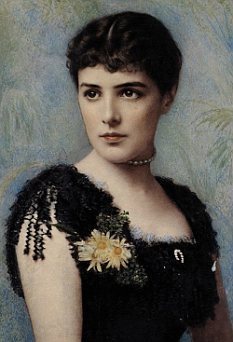
Jeanette "Jennie" Jerome was born in the Cobble Hill section of Brooklyn in 1854, the second of three daughters of financier, sportsman, and speculator Leonard Jerome and his British wife Clarissa (always called Clara, daughter of Ambrose Hall, a landowner. She was raised in Brooklyn and other parts of what would become New York City. She had two sisters, Clarita and Leonie. Leonard Jerome was rumored to also be the father of the American opera singer Minnie Hauk.
There is some controversy regarding the time and place of her birth. A plaque at 426 Henry St. gives her year of birth as 1850, not 1854. However, on January 9 in 1854, the Jeromes lived nearby at 8 Amity Street (since renumbered as 197). It is believed that the Jeromes were temporarily staying at the Henry Street address, which was owned by Leonard's brother Addison, and that Jennie was born there during a snowstorm.
A noted beauty (an admirer, Lord d'Abernon, said that there was "more of the panther than of the woman in her look") Jennie Jerome worked as a magazine editor in early life. Hall family lore insists that Jennie had Iroquois ancestry, through her maternal grandmother; however, there is no research or evidence to corroborate this.
Long considered one of the most beautiful women of the time, she was married for the first time on April 15, 1874, aged 20, at the British Embassy in Paris, to Lord Randolph Churchill, the third son of John Winston Spencer-Churchill, 7th Duke of Marlborough and Lady Frances Anne Emily Vane. Although the couple became engaged within three days of their initial meeting, the marriage was delayed for months while their parents argued over settlements. By this marriage, she was properly known as Lady Randolph Churchill and would have been referred to in conversation as Lady Randolph.
The Churchills had two sons. Winston (1874–1965), the future prime minister, was born less than eight months after the marriage. According to his biographer William Manchester, Winston was most likely conceived before the marriage, rather than born prematurely. (A recent biography has stated that he was born two months prematurely after Lady Randolph "had a fall.") When asked about the circumstances of his birth, he would reply, "Although present on the occasion, I have no clear recollection of the events leading up to it." Lady Randolph's sisters believed that the biological father of the second son, John (1880–1947) was Evelyn Boscawen, 7th Viscount Falmouth.
Lady Randolph is believed to have had numerous lovers during her marriage, including Karl Kinsky, the Prince of Wales (later King Edward VII of the United Kingdom) and Herbert von Bismarck.
As was the custom of the day, Lady Randolph played a limited role in her sons' upbringing, relying largely upon nannies, especially Elizabeth Everest. Winston worshipped his mother, writing her numerous letters during his time at school and begging her to visit him, which, however, she rarely did. He wrote about her in My Early Life: 'She shone for me like the evening star. I loved her dearly - but at a distance'. After he became an adult, they became good friends and strong allies, to the point where Winston regarded her almost as a political mentor, more as a big sister than as a mother. She was well-respected and influential in the highest British social and political circles. She was said to be intelligent, witty, and quick to laughter. It was said that Queen Alexandra especially enjoyed her company, despite the fact that Jennie had been involved in an affair with her husband, King Edward VII, a fact that was well known by Alexandra. Through her family contacts and her extramarital romantic relationships, Jennie greatly helped Lord Randolph's early career, as well as that of her son Winston. In 1909 when American impresario Charles Frohman became sole manager of the The Globe Theatre, the first production was His Borrowed Plumes, written by Lady Randolph Churchill. Although Mrs. Patrick Campbell produced and took the lead role in the play, it was a commercial failure. It was at this point that Mrs. Campbell began an affair with Lady Randolph's then husband, George Cornwallis-West.
Lady Randolph was a talented amateur pianist, having been tutored as a girl by Stephen Heller, a friend of Chopin. Heller believed that his young pupil was good enough to attain 'concert standard' with the necessary 'hard work', which, according to Lovell, he was not confident she was capable of.
Lord Randolph died in 1895, aged 45. On 28 July 1900, Jennie married George Cornwallis-West (1874–1951), a captain in the Scots Guards who was the same age as her elder son, Winston. Around this time, she became well known for chartering a hospital ship to care for those wounded in the Boer War. She separated from her second husband in 1912, and they were divorced in April 1914, whereupon Cornwallis-West married the actress Mrs. Patrick Campbell. Jennie dropped the surname Cornwallis-West, and resumed, by deed poll, the name Lady Randolph Churchill. Her third marriage, on 1 June 1918, was to Montagu Phippen Porch (1877–1964), a member of the British Civil Service in Nigeria, who was three years Winston's junior. At the end of World War I, Porch resigned from the colonial service, and after Jennie's death returned to West Africa where his business investments had proven successful.
In May 1921, while Montagu Porch was away in Africa, Jennie slipped while coming down a friend's staircase wearing new high-heeled shoes, breaking her ankle. Gangrene set in, and her left leg was amputated above the knee on 10 June. She died at her home in London on 29 June, following a haemorrhage of an artery in her thigh (resulting from the amputation). She was 67 years old.
She was buried in the Churchill family plot at St Martin's Church, Bladon, Oxfordshire, next to her first husband. (Source: http://en.wikipedia.org/wiki/Lady_Ran...)
More:
http://www.britannica.com/EBchecked/t...
http://greathistory.com/jennie-jerome...
http://brooklynbeforenow.blogspot.com...
http://scandalouswoman.blogspot.com/2...
http://voices.yahoo.com/american-heir...
http://www.winstonchurchill.org/suppo...
http://www.winstonchurchill.org/learn...
http://thehistorychicks.com/?tag=lady...
 by Ralph G. Martin (no photo)
by Ralph G. Martin (no photo) by Rene Kraus (no photo)
by Rene Kraus (no photo) by
by
 Anne Sebba
Anne Sebba by George Cornwallis-West (no photo)
by George Cornwallis-West (no photo) by Robert Rhodes James (no photo)
by Robert Rhodes James (no photo) by Celia Sandys (no photo)
by Celia Sandys (no photo) by Charles Higham (no photo)
by Charles Higham (no photo)(no image)Mrs. Pat : The Life of Mrs. Patrick Campbell by Margot Peters (no photo)
 Sam E. Woods
Sam E. WoodsSam E. Woods, commercial attaché in Berlin, developed excellent contacts in the German army command—contacts which brought him close to high-ranking German staff officers opposed to Hitler who knew of the plans for BARBAROSSA. Woods was able to follow the German preparations from July 1940 until the plans were finalized that December.
(Source: https://www.cia.gov/news-information/...)
More:
http://leninist.biz/en/1983/HM493/2.4...
http://dachaukz.blogspot.com/2013/05/...
http://images.library.wisc.edu/Histor...
http://munich.usconsulate.gov/history...
http://images.library.wisc.edu/Histor...
http://books.google.com/books?id=EMXg...
 by
by
 Joseph E. Persico
Joseph E. Persico by John V.H. Dippel (no photo)
by John V.H. Dippel (no photo) by John Hughes-Wilson (no photo)
by John Hughes-Wilson (no photo) by Waldo Heinrichs (no photo)
by Waldo Heinrichs (no photo) by Edwin Black (no photo)
by Edwin Black (no photo)(no image) The American Experience in World War II by Walter Hixson (no photo)
 P40 Fighter
P40 Fighter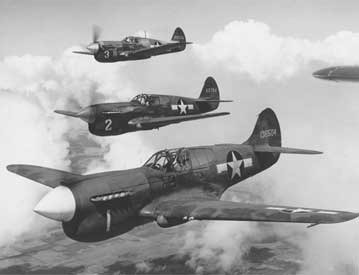
[image error]
The Curtiss P-40 Warhawk was an American single-engine, single-seat, all-metal fighter and ground attack aircraft that first flew in 1938. The P-40 design was a modification of the previous Curtiss P-36 Hawk which reduced development time and enabled a rapid entry into production and operational service. The Warhawk was used by most Allied powers during World War II, and remained in front line service until the end of the war. It was the third most-produced American fighter, after the P-51 and P-47; by November 1944, when production of the P-40 ceased, 13,738 had been built, all at Curtiss-Wright Corporation's main production facilities at Buffalo, New York.
Warhawk was the name the United States Army Air Corps adopted for all models, making it the official name in the United States for all P-40s. The British Commonwealth and Soviet air forces used the name Tomahawk for models equivalent to the P-40B and P-40C, and the name Kittyhawk for models equivalent to the P-40D and all later variants.
P-40s first saw combat with the British Commonwealth squadrons of the Desert Air Force in the Middle East and North African campaigns, during June 1941. No. 112 Squadron Royal Air Force, was among the first to operate Tomahawks in North Africa and the unit was the first Allied military aviation unit to feature the "shark mouth" logo, copying similar markings on some Luftwaffe Messerschmitt Bf 110 twin-engine fighters.
The P-40's lack of a two-stage supercharger made it inferior to Luftwaffe fighters such as the Messerschmitt Bf 109 or the Focke-Wulf Fw 190 in high-altitude combat and it was rarely used in operations in Northwest Europe. Between 1941 and 1944, the P-40 played a critical role with Allied air forces in three major theaters: North Africa, the Southwest Pacific and China. It also had a significant role in the Middle East, Southeast Asia, Eastern Europe, Alaska and Italy. The P-40's performance at high altitudes was not as important in those theaters, where it served as an air superiority fighter, bomber escort and fighter bomber. Although it gained a post-war reputation as a mediocre design, suitable only for close air support, recent research including scrutiny of the records of individual Allied squadrons, indicates that the P-40 performed surprisingly well as an air superiority fighter, at times suffering severe losses but also taking a very heavy toll of enemy aircraft. The P-40 offered the additional advantage of low cost, which kept it in production as a ground-attack aircraft long after it was obsolete as a fighter. In 2008, 29 P-40s were airworthy
(Source: http://en.wikipedia.org/wiki/Curtiss_...)
More:
http://www.militaryfactory.com/aircra...
http://www.af.mil/information/heritag...
http://ww2total.com/WW2/Weapons/War-P...
http://www.howstuffworks.com/curtiss-...
http://www.timemoneyandblood.com/HTML...
http://www.chuckhawks.com/p40.htm
http://airandspace.si.edu/collections...
http://www.fighterfactory.com/curtiss...
http://www.flickr.com/photos/libyan_s...
http://www.dailymail.co.uk/news/artic...
http://youtu.be/Pxu02bNuma4
http://youtu.be/CjZoWU5R9dA
 by Richard S. Dann (no photo)
by Richard S. Dann (no photo) by Carl Molesworth (no photo)
by Carl Molesworth (no photo) by Glen Phillips (no photo)
by Glen Phillips (no photo) by Anis El Bied (no photo)
by Anis El Bied (no photo) by Jeffrey L. Ethell (no photo)
by Jeffrey L. Ethell (no photo) by Arthur Herman (no photo)
by Arthur Herman (no photo) by R.G. Grant (no photo)
by R.G. Grant (no photo)
 HMS Prince of Wales
HMS Prince of Wales

HMS Prince of Wales was a King George V-class battleship of the Royal Navy, built at the Cammell Laird shipyard in Birkenhead, England. She was involved in several key actions of the Second World War, including the battle of Denmark Strait against the Bismarck, operations escorting convoys in the Mediterranean, and her final action and sinking in the Pacific in 1941.
Prince of Wales first encountered the Germans while being outfitted in her drydock, being attacked and damaged by German aircraft. She was heavily involved in the first contact with the German battleship Bismarck and the cruiser Prinz Eugen, and landed three hits on Bismarck including two critical hits, one which caused extensive flooding forward, and another which exploded under Bismarck's armour belt causing machinery damage, the combined effect of both hits caused her to make the ill-fated decision to return to port. Prince of Wales suffered heavy damage during the engagement and had to return to Rosyth to be repaired.
Following repairs at Rosyth, Prince of Wales transported Prime Minister Winston Churchill across the Atlantic for a conference with US President Franklin D. Roosevelt. On 5 August Roosevelt boarded the cruiser USS Augusta from the presidential yacht Potomac. Augusta proceeded from Massachusetts to Placentia Bay and Argentia in Newfoundland in company with the cruiser USS Tuscaloosa and five destroyers, arriving on 7 August. On 9 August Winston Churchill arrived in the bay aboard Prince of Wales, escorted by the destroyers HMS Ripley, HMCS Assiniboine and HMCS Restigouche. At Placentia Bay, Newfoundland, Roosevelt transferred to the destroyer USS McDougal to meet Winston Churchill on board Prince of Wales. The conference continued from 10 to 12 August aboard the heavy cruiser USS Augusta, and at the end of the conference, the Atlantic Charter was proclaimed.Following the declaration of the charter Prince of Wales arrived back at Scapa Flow on 18 August.
On 25 October 1941, Prince of Wales departed for Singapore to join Force Z, a British naval detachment. She docked there on 2 December with the rest of the force, and at 2:11 on 10 December Force Z was dispatched to investigate reports of Japanese landing forces at Kuantan. On arriving there they found the reports to be false. At 11:00 that morning Japanese bombers and torpedo aircraft began their assault on Force Z. In a second attack at 11:30 torpedoes struck Prince of Wales on the port side, wrecking the outer propeller shaft and causing the ship to take on a heavy list. A third torpedo attack developed against HMS Repulse, a Renown-class battlecruiser in Force Z, but she managed to avoid all torpedoes aimed at her. A fourth attack by torpedo-carrying Type 1 "Bettys" sank Repulse at 12:33. Six aircraft from this wave attacked Prince of Wales, with four of their torpedoes hitting the ship, causing flooding. Finally a 500 kg bomb hit the catapult deck, penetrated through to the main deck and exploded, tearing a gash in the port side of the hull. At 13:15 the order was given to abandon ship and at 13:20 Prince of Wales sank; Vice-Admiral Tom Phillips and Captain John Leach were among the 327 fatalities.
Prince of Wales and Repulse were the first capital ships to be sunk solely by air power on the open sea (albeit by land-based rather than carrier-based aircraft), a harbinger of the diminishing role this class of ships was subsequently to play in naval warfare. The wreck lies upside down in 223 feet (68 m) of water, near Kuantan, in the South China. (Source: http://en.wikipedia.org/wiki/HMS_Prin...)
More:
http://www.history.navy.mil/photos/sh...
http://www.bbc.co.uk/history/ww2peopl...
http://www.youtube.com/watch?v=wMXqvW...
http://www.royalnavy.mod.uk/The-Fleet...
http://commons.wikimedia.org/wiki/HMS...
http://www.archives.gov/education/les...
http://www.atlanticcharter.ca/gallery...
http://www.pacificwrecks.com/ships/hm...
 by Jesse Russell (no photo)
by Jesse Russell (no photo) by Source Wikipedia (no photo)
by Source Wikipedia (no photo) by David R. Facey-Crowther (no photo)
by David R. Facey-Crowther (no photo) by Max Arthur (no photo)
by Max Arthur (no photo) by James J. Colledge (no photo)
by James J. Colledge (no photo) by W.S. Hewison (no photo)
by W.S. Hewison (no photo)(no image)Profile Morskie 02 Warships In Colour Hms Repulse by Slawomir Brzezinski (no photo)
 Princess Martha of Sweden
Princess Martha of Sweden
Crown Princess Märtha was born in Stockholm on 28 March 1901. Christened Märtha Sofia Lovisa Dagmar Thyra, she was the daughter of Prince Carl of Sweden and Princess Ingeborg of Denmark.
The Princess became engaged to her cousin, then Crown Prince Olav, during the 1928 Olympic Summer Games in Amsterdam. News of the engagement was very well received. It was taken as a sign that there was no longer any tension following the dissolution of the union between Norway and Sweden. An excellent match in terms of strengthening royal ties, it was also clearly a match based on love. Princess Märtha and Crown Prince Olav were wed in Vår Frelsers church (now Oslo Cathedral) on 21 March 1929. Upon her marriage Princess Märtha became the Crown Princess of Norway, which she remained until her death in 1954.
Crown Princess of Norway
Charming, open and hard-working, Crown Princess Märtha soon became a popular and respected member of the Royal Family. She undertook a range of official engagements, and she also gave many speeches, which was unusual for females in the Royal Family at the time.
The Crown Prince and Crown Princess resided at the country estate of Skaugum, which was a wedding gift from Fritz Wedel Jarlsberg. When the main house at Skaugum was destroyed by fire in 1930, the Crown Princess was actively involved in the planning of the new building.
The Crown Prince and Crown Princess had three children: Princess Ragnhild, born in 1930, Princess Astrid, born in 1932, and Prince Harald (the future King Harald V), born in 1937. The Prince was the first heir to the throne to be born in Norway in 567 years. Crown Princess Märtha assumed the role of First Lady on Queen Maud’s death in 1938.
World War II
When German troops invaded Norway on 9 April 1940, the Royal Family, the Government and most members of the Storting managed to flee before the Germans reached Oslo. Crown Princess Märtha and her three children crossed the border into Sweden that same night. On 12 August they travelled to the USA at the invitation of President Franklin D. Roosevelt.
The Crown Prince and Crown Princess had become close friends with the US president and his wife during a comprehensive tour of the USA in summer 1939. Their friendship opened doors for the Crown Princess, who worked assiduously to promote Norwegian interests. She was involved in a wide range of activities, from paying official visits and giving lectures and speeches, to sending relief aid and participating in relief operations for refugees.
The Crown Princess was given a warm welcome when she returned to Norway with the children and King Haakon on 7 June 1945. Her ceaseless efforts during the war had made her even more popular with the Norwegian people.
Post-war period
As King Haakon’s health declined, the Crown Prince and Crown Princess assumed a growing number of official engagements. The Crown Princess became involved in many official tasks, and even held the annual New Year’s Eve speeches in 1946 and 1950. Unfortunately, Crown Princess Märtha also suffered from poor health. Her death on 5 April 1954 was a tremendous loss for Crown Prince Olav and the children as well as for Norway. Crown Princess Märtha never officially became Queen of Norway. However, as the Bishop of Oslo, Johannes Smemo, stated: “In our hearts she has long been our Queen, and she will be so forever.”
Crown Princess Märtha was buried in the Royal Mausoleum at Akershus Castle on 21 April 1954.
(Source: http://www.kongehuset.no/artikkel.htm...)
More:
http://en.wikipedia.org/wiki/Princess...
http://www.kongehuset.no/seksjon.html...
http://archive.org/details/gov.archiv...
http://www.allposters.com/-sp/Frankli...
http://youtu.be/mrowUg8CmG4
http://dctourguideonline.com/2011/08/...
http://www.nytimes.com/1994/09/11/boo...
http://www.washingtonpost.com/wp-srv/...
http://web.ics.purdue.edu/~dltazeta/f...
http://www.historicwomenofsubstance.c...
http://www.criticalpast.com/video/656...
 by
by
 Doris Kearns Goodwin
Doris Kearns Goodwin by
by
 Gore Vidal
Gore Vidal by Greg King (no photo)
by Greg King (no photo) by Edward Riley (no photo)
by Edward Riley (no photo)(no image) Delta Zeta Sorority: A Century Of Sisterhood: The Story Of Delta Zeta Sorority, 1902 2002 by Nancy Brewer (no photo)
message 107:
by
Jerome, Assisting Moderator - Upcoming Books and Releases
(new)
Joseph B. Poindexter


Though his parents were from Virginia, Joseph Boyd Poindexter was born in 1869 in Grant County, Oregon. While not the first of the clan to come to that Territory, his family was among the most progressive. His uncle, Philip Poindexter, joined forces with one William Orr, to create a cattle empire known as the P&O Ranch of California and Montana, with private holdings also in Oregon. The P&O Ranch of Montana is today known as the Matador, one of the largest and most famous still-operating cattle ranches.
Meanwhile, Joseph's father Thomas Watson Poindexter pursued a more homely brand of public notice, working as a merchant and serving for a time as Grant County Clerk. Joseph, however, was bound for higher things. When the family moved to Montana, Joseph by one account sometimes rode for his Uncle Philip. Yet his studies led him to a law degree in 1893, and then to the bar, whence he became an accomplished lawyer. He was married in 1897, opened his own law practice, and later served as Montana State Attorney General, finding his political stance with the conservative Democrats.
In 1917, President Wilson appointed Joseph Poindexter U.S. District Judge for the Territory of Hawaii. From the cold cattle ranges of Montana to the Polynesian paradise, Poindexter doubtless had little trouble adapting to his new home. A brutal blow to his happiness must have been the death of his wife in 1918, yet he continued his work with steady purpose. President Franklin D. Roosevelt recognized his administrative acumen, and Joseph B. Poindexter was appointed the first Governor of Hawaii for two full terms, March 1934 through August 1942. He was among the first to advocate Hawaii's statehood, yet that happy endeavor was interrupted by tragedy.
It was his grim fate to be in the Governor's seat one sleepy Sunday morning in December of 1941, when a distant foe visited those tropical shores with fire and death. The Japanese had attacked Pearl Harbor.
Over the years, much has been written, investigations, hearings, accusations, denials, and in today's lexicon, "Who knew what and when did they know it" relative to the attack.
Governor Poindexter had concerns about the vulnerability of Hawaii to foreign aggression. He visited Secretary of Interior Ickes (Department of the Interior was the administrative arm of the U.S. government in Territorial matters) in the summer of 1941 to protest the transfer of some of the Pacific Fleet to the Atlantic. According to Governor Poindexter, Ickes idea was "that our concern out here was with sabotage, that we should guard against the possibility of sabotage." Then and ever after Poindexter felt "very keenly that this attitude was very largely responsible for conditions" in Hawaii. The governor also recalls that Ickes continued with, "Oh, you people need not be alarmed whatever. There is going to be no attack on Hawaii. It is too far away." Time blurred the governor's recollection of all of Ickes' exact words. But this sentence stuck sharply in his mind. "The battle is on the Atlantic."
The attack on Pearl Harbor is documented through words, pictures, and experiences related by those who bore the brunt of the attack.
His voice trembling, the seventy-two year old Governor of Hawaii went on the air from his office via a KGU microphone to read a proclamation of emergency. It was less than necessary, since getting the chaos under control required martial law, which would make General Short military governor (General Short was the top Army commander in Hawaii).
As he was closing, a telephone message was handed to the governor. Short wanted him off the air; another attack was expected, and the Army wanted to shut down Honolulu's radio station to prevent the Japanese from homing in on the broadcast.
Poindexter wept. "We are going off the air for the first time. We have been under attack and the sign of the Rising Sun has been plainly seen on the underside of the planes."
Blotting out Oahu's radio signal was a good idea, but eight hours too late. Still, the governor's aides, panicking that another raid was imminent, hustled him down the stairs as soon as he completed this peroration, pushed him into a car and drove him away.
Bewildered, Poindexter thought he had said something wrong on the air and was being rushed off to house arrest.
Hawaii survived the war with fine fortitude, as did Joseph Poindexter. From 1932 to 1943 he served as president of the American Bar Association, before settling into a quieter life in his island home. Joseph Boyd Poindexter died in Honolulu in 1951. His ashes were returned to the scenes of his youth, and interred at Dillon, Montana.
(Source: http://1poindexter.com/joseph.htm)
More:
https://en.wikipedia.org/wiki/Joseph_...
lodge616.com/about/history/biographie...
ww.jstor.org/discover/10.2307/4048887...
http://www.hawaiihistory.org/index.cf...
http://www.hawaiihistory.org/index.cf...
http://the.honoluluadvertiser.com/150...
http://the.honoluluadvertiser.com/150...
http://the.honoluluadvertiser.com/150...
http://the.honoluluadvertiser.com/150...
http://the.honoluluadvertiser.com/150...
(no image) Modern History Of Hawaii by Ann Rayson (no photo)
(no image) Completing the Union: Alaska, Hawai'i, and the Battle for Statehood by John S. Whitehead (no photo)
 by Gavan Daws (no photo)
by Gavan Daws (no photo)
 by Steven M. Gillon (no photo)
by Steven M. Gillon (no photo)
 by Craig Shirley (no photo
by Craig Shirley (no photo
 by Bill McWilliams (no photo)
by Bill McWilliams (no photo)
 by Tetsuden Kashima (no photo)
by Tetsuden Kashima (no photo)


Though his parents were from Virginia, Joseph Boyd Poindexter was born in 1869 in Grant County, Oregon. While not the first of the clan to come to that Territory, his family was among the most progressive. His uncle, Philip Poindexter, joined forces with one William Orr, to create a cattle empire known as the P&O Ranch of California and Montana, with private holdings also in Oregon. The P&O Ranch of Montana is today known as the Matador, one of the largest and most famous still-operating cattle ranches.
Meanwhile, Joseph's father Thomas Watson Poindexter pursued a more homely brand of public notice, working as a merchant and serving for a time as Grant County Clerk. Joseph, however, was bound for higher things. When the family moved to Montana, Joseph by one account sometimes rode for his Uncle Philip. Yet his studies led him to a law degree in 1893, and then to the bar, whence he became an accomplished lawyer. He was married in 1897, opened his own law practice, and later served as Montana State Attorney General, finding his political stance with the conservative Democrats.
In 1917, President Wilson appointed Joseph Poindexter U.S. District Judge for the Territory of Hawaii. From the cold cattle ranges of Montana to the Polynesian paradise, Poindexter doubtless had little trouble adapting to his new home. A brutal blow to his happiness must have been the death of his wife in 1918, yet he continued his work with steady purpose. President Franklin D. Roosevelt recognized his administrative acumen, and Joseph B. Poindexter was appointed the first Governor of Hawaii for two full terms, March 1934 through August 1942. He was among the first to advocate Hawaii's statehood, yet that happy endeavor was interrupted by tragedy.
It was his grim fate to be in the Governor's seat one sleepy Sunday morning in December of 1941, when a distant foe visited those tropical shores with fire and death. The Japanese had attacked Pearl Harbor.
Over the years, much has been written, investigations, hearings, accusations, denials, and in today's lexicon, "Who knew what and when did they know it" relative to the attack.
Governor Poindexter had concerns about the vulnerability of Hawaii to foreign aggression. He visited Secretary of Interior Ickes (Department of the Interior was the administrative arm of the U.S. government in Territorial matters) in the summer of 1941 to protest the transfer of some of the Pacific Fleet to the Atlantic. According to Governor Poindexter, Ickes idea was "that our concern out here was with sabotage, that we should guard against the possibility of sabotage." Then and ever after Poindexter felt "very keenly that this attitude was very largely responsible for conditions" in Hawaii. The governor also recalls that Ickes continued with, "Oh, you people need not be alarmed whatever. There is going to be no attack on Hawaii. It is too far away." Time blurred the governor's recollection of all of Ickes' exact words. But this sentence stuck sharply in his mind. "The battle is on the Atlantic."
The attack on Pearl Harbor is documented through words, pictures, and experiences related by those who bore the brunt of the attack.
His voice trembling, the seventy-two year old Governor of Hawaii went on the air from his office via a KGU microphone to read a proclamation of emergency. It was less than necessary, since getting the chaos under control required martial law, which would make General Short military governor (General Short was the top Army commander in Hawaii).
As he was closing, a telephone message was handed to the governor. Short wanted him off the air; another attack was expected, and the Army wanted to shut down Honolulu's radio station to prevent the Japanese from homing in on the broadcast.
Poindexter wept. "We are going off the air for the first time. We have been under attack and the sign of the Rising Sun has been plainly seen on the underside of the planes."
Blotting out Oahu's radio signal was a good idea, but eight hours too late. Still, the governor's aides, panicking that another raid was imminent, hustled him down the stairs as soon as he completed this peroration, pushed him into a car and drove him away.
Bewildered, Poindexter thought he had said something wrong on the air and was being rushed off to house arrest.
Hawaii survived the war with fine fortitude, as did Joseph Poindexter. From 1932 to 1943 he served as president of the American Bar Association, before settling into a quieter life in his island home. Joseph Boyd Poindexter died in Honolulu in 1951. His ashes were returned to the scenes of his youth, and interred at Dillon, Montana.
(Source: http://1poindexter.com/joseph.htm)
More:
https://en.wikipedia.org/wiki/Joseph_...
lodge616.com/about/history/biographie...
ww.jstor.org/discover/10.2307/4048887...
http://www.hawaiihistory.org/index.cf...
http://www.hawaiihistory.org/index.cf...
http://the.honoluluadvertiser.com/150...
http://the.honoluluadvertiser.com/150...
http://the.honoluluadvertiser.com/150...
http://the.honoluluadvertiser.com/150...
http://the.honoluluadvertiser.com/150...
(no image) Modern History Of Hawaii by Ann Rayson (no photo)
(no image) Completing the Union: Alaska, Hawai'i, and the Battle for Statehood by John S. Whitehead (no photo)
 by Gavan Daws (no photo)
by Gavan Daws (no photo) by Steven M. Gillon (no photo)
by Steven M. Gillon (no photo) by Craig Shirley (no photo
by Craig Shirley (no photo by Bill McWilliams (no photo)
by Bill McWilliams (no photo) by Tetsuden Kashima (no photo)
by Tetsuden Kashima (no photo)
 Brigadier General Billy Mitchell
Brigadier General Billy Mitchell[image error]

The son of wealthy Senator John L. Mitchell (D-WI) and his wife Harriet, William "Billy" Mitchell was born on December 28, 1879 at Nice, France. Educated in Milwaukee, he later enrolled at Columbian College (present-day George Washington University) in Washington, DC. In 1898, prior to graduating, he enlisted in the US Army with the goal of fighting in the Spanish-American War. Entering the service, Mitchell's father soon used his connections to obtain his son a commission. Though the war ended before he saw action, Mitchell elected to remain in the US Army Signal Corps and spent time in Cuba and the Philippines.
Sent north in 1901, Mitchell successfully built telegraph lines in remote areas of Alaska. During this posting, he began studying Otto Lilienthal's glider experiments. This reading, combined with further research, led him to conclude in 1906 that future conflicts would be fought in the air. Two years later, he witnessed a flying demonstration given by Orville Wright at Fort Myer, VA. Sent to the Army Staff College, he became the only Signal Corps Officer on the Army General Staff in 1913. As aviation was assigned to the Signal Corps, Mitchell was well placed to further develop his interest.
Associating with many early military aviators, Mitchell was made deputy commander of the Aviation Section, Signal Corps in 1916. At age 38, the US Army felt that Mitchell was too old for flying lessons. As a result, he was forced to seek private instruction at the Curtiss Aviation School in Newport News, VA where he proved a quick study. When the US entered World War I in April 1917, Mitchell, now a lieutenant colonel, was en route to France as an observer and to study aircraft production. Traveling to Paris, he established an Aviation Section office and began connecting with his British and French counterparts.
Working closely with the Royal Flying Corps' General Sir Hugh Trenchard, Mitchell learned how to develop aerial combat strategies and plan large-scale air operations. On April 24, he became the first American officer to fly over the lines when he rode with a French pilot. Quickly earning a reputation as a daring and tireless leader, Mitchell was promoted to brigadier general and given command of all American air units in General John J. Pershing's American Expeditionary Force.
In September 1918, Mitchell successfully planned and orchestrated a campaign using 1,481 Allied aircraft in support of ground forces during the Battle of St. Mihiel. Gaining air superiority over the battlefield, his aircraft aided in driving back the Germans. During his time in France, Mitchell proved a highly effective commander, but his aggressive approach and unwillingness to operate in the chain of command made him numerous enemies. For his performance in World War I, Mitchell received the Distinguished Service Cross, the Distinguished Service Medal, and several foreign decorations.
Following the war, Mitchell expected to be placed in command of the US Army Air Service. He was blocked in this goal when Pershing named Major General Charles T. Menoher, an artilleryman, to the post. Mitchell instead was made Assistant Chief of the Air Service and was able to retain his wartime rank of brigadier general. A relentless advocate for aviation, he encouraged US Army pilots to challenge records as well as promoted races and ordered aircraft to aid in fighting forest fires. Convinced that air power would become the driving force of war in the future, he pressed for the creation of an independent air force.
Mitchell's vocal support of air power brought him into conflict with the US Navy as he felt the ascent of aviation made the surface fleet increasingly obsolete. Convinced that bombers could sink battleships, he argued that aviation should be the US' first line of defense. Among those he alienated was Assistant Secretary of the Navy Franklin D. Roosevelt. Failing to achieve his goals, Mitchell became increasingly outspoken and attacked his superiors in the US Army, as well as the leadership of the US Navy and White House for failing to understand the importance of military aviation.
Continuing to agitate, Mitchell managed in February 1921 to convince Secretary of War Newton Baker and Secretary of the Navy Josephus Daniels to hold joint Army-Navy exercises in which his aircraft would bomb surplus/captured ships. Though the US Navy was reluctant to agree, it was compelled to accept the exercises after Mitchell learned of their own aerial testing against ships. Believing that he could succeed in "wartime conditions," Mitchell also held that a thousand bombers could be built for the price of one battleship making aviation a more economical defense force.
Dubbed Project B, the exercises moved forward in June and July 1921 under a set of rules of engagement that greatly favored the survivability of the ships. In the early tests, Mitchell's aircraft sank a captured German destroyer and light cruiser. On July 20-21, they attacked the German battleship Ostfriesland. While the aircraft did sink it, they violated the rule of engagement in doing so. In addition, the circumstances of the exercises were not "wartime conditions" as all of the target vessels were stationary and effectively defenseless.
Mitchell repeated his success later that year by sinking the retired US battleship Alabama in September. The tests incensed President Warren Harding who wished to avoid any show of naval weakness immediately prior to the Washington Naval Conference, but did lead to increased funding for military aviation. Following a protocol incident with his naval counterpart, Rear Admiral William Moffett, at the beginning of the conference, Mitchell was sent overseas on an inspection tour.
Returning to the US, Mitchell continued to criticize his superiors regarding aviation policy. In 1924, the commander of the Air Service, Major General Mason Patrick, sent him on a tour of Asia and the Far East to remove him from the limelight. During this tour, Mitchell foresaw a future war with Japan and predicted an aerial attack on Pearl Harbor. That fall, he again blasted the Army and Navy leadership, this time to the Lampert Committee. The following March, his term of Assistant Chief ended and he was exiled to San Antonio, TX, with the rank of colonel, to oversee air operations.
Later that year, following the loss of the US Navy airship USS Shenandoah, Mitchell issued a statement accusing the military's senior leadership of "almost treasonable administration of the national defense" and incompetence. As a result of these statements, he was brought up on court-martial charges for insubordination at the direction of President Calvin Coolidge. Beginning that November, the court-martial saw Mitchell receive broad public support and notable aviation officers such as Eddie Rickenbacker, Henry "Hap" Arnold, and Carl Spaatz testified on his behalf.
On December 17, Mitchell was found guilty and sentenced to a five-year suspension from active duty and loss of pay. The youngest of the twelve judges, Major General Douglas MacArthur, called serving on the panel "distasteful," and voted not guilty stating that an officer should not be "silenced for being at variance with his superiors in rank and with accepted doctrine." Rather than accept the punishment, Mitchell resigned on February 1, 1926. Retiring to his farm in Virginia, he continued to advocate for air power and a separate air force until his death on February 19, 1936. (Source: http://militaryhistory.about.com/od/a...)
More:
http://www.airpower.maxwell.af.mil/ai...
http://www.nationalmuseum.af.mil/fact...
http://www.af.mil/information/heritag...
http://www.army.mil/article/33680
http://www.airforcemag.com/MagazineAr...
http://blog.nasm.si.edu/aviation/gene...
http://www.airpower.au.af.mil/airchro...
http://law.jrank.org/pages/2858/Billy...
 by Douglas C. Waller (no photo)
by Douglas C. Waller (no photo) by Amy Waters Yarsinske (no photo)
by Amy Waters Yarsinske (no photo) by Alfred F. Hurley (no photo)
by Alfred F. Hurley (no photo) by Spencer Lane (no photo)
by Spencer Lane (no photo) by H. Paul Jeffers (no photo)
by H. Paul Jeffers (no photo) by William Schwarzer (no photo)
by William Schwarzer (no photo)(no image)The Billy Mitchell Affair by Burke Davis (no photo)
(no image)Billy Mitchell by James J. Cooke (no photo)
 Henry Wadsworth Longfellow
Henry Wadsworth Longfellow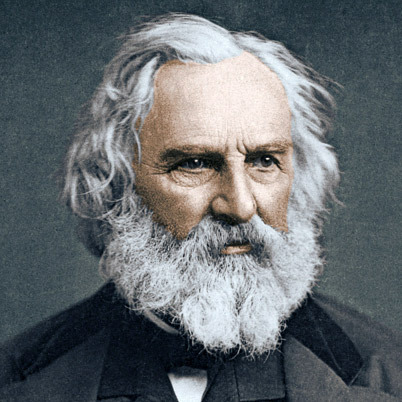
Henry Wadsworth Longfellow was born in Portland, Maine—then still part of Massachusetts—on February 27, 1807, the second son in a family of eight children. His mother, Zilpah Wadsworth, was the daughter of a Revolutionary War hero. His father, Stephen Longfellow, was a prominent Portland lawyer and later a member of Congress.
Henry was a dreamy boy who loved to read. He heard sailors speaking Spanish, French and German in the Portland streets and liked stories set in foreign places: The Arabian Nights, Robinson Crusoe, and the plays of Shakespeare.
After graduating from Bowdoin College, Longfellow studied modern languages in Europe for three years, then returned to Bowdoin to teach them. In 1831 he married Mary Storer Potter of Portland, a former classmate, and soon published his first book, a description of his travels called Outre Mer ("Overseas"). But in November 1835, during a second trip to Europe, Longfellow's life was shaken when his wife died during a miscarriage. The young teacher spent a grief-stricken year in Germany and Switzerland.
Longfellow took a position at Harvard in 1836. Three years later, at the age of 32, he published his first collection of poems, Voices of the Night, followed in 1841 by Ballads and Other Poems. Many of these poems ("A Psalm of Life," for example) showed people triumphing over adversity, and in a struggling young nation that theme was inspiring. Both books were very popular, but Longfellow's growing duties as a professor left him little time to write more. In addition, Frances Appleton, a young woman from Boston, had refused his proposal of marriage.
Frances finally accepted his proposal the following spring, ushering in the happiest 18 years of Longfellow's life. The couple had six children, five of whom lived to adulthood, and the marriage gave him new confidence. In 1847, he published Evangeline, a book-length poem about what would now be called "ethnic cleansing." The poem takes place as the British drive the French from Nova Scotia, and two lovers are parted, only to find each other years later when the man is about to die.
In 1854, Longfellow decided to quit teaching to devote all his time to poetry. He published Hiawatha, a long poem about Native American life, and The Courtship of Miles Standish and Other Poems. Both books were immensely successful, but Longfellow was now preoccupied with national events. With the country moving towards civil war, he wrote "Paul Revere's Ride," a call for courage in the coming conflict.
A few months after the war began in 1861, Frances Longfellow was sealing an envelope with wax when her dress caught fire. Despite her husband's desperate attempts to save her, she died the next day. Profoundly saddened, Longfellow published nothing for the next two years. He found comfort in his family and in reading Dante's Divine Comedy. (Later he produced its first American translation.) Tales of a Wayside Inn, largely written before his wife's death, was published in 1863.
When the Civil War ended in 1865, the poet was 58. His most important work was finished, but his fame kept growing. In London alone, 24 different companies were publishing his work. His poems were popular throughout the English-speaking world, and they were widely translated, making him the most famous American of his day. His admirers included Lincoln, Dickens, and Baudelaire.
From 1866 to 1880, Longfellow published seven more books of poetry, and his seventy-fifth birthday in 1882 was celebrated across the country. But his health was failing, and he died the following month, on March 24. When Walt Whitman heard of the poet's death, he wrote that, while Longfellow's work "brings nothing offensive or new, does not deal hard blows," he was the sort of bard most needed in a materialistic age: "He comes as the poet of melancholy, courtesy, deference—poet of all sympathetic gentleness—and universal poet of women and young people. I should have to think long if I were ask'd to name the man who has done more and in more valuable directions, for America."
(Source: http://www.poets.org/poet.php/prmPID/143)
More:
http://www.hwlongfellow.org/
https://en.wikipedia.org/wiki/Henry_W...
http://www.gutenberg.org/browse/autho...
http://www.reelyredd.com/0802blacksmi...
http://www.nps.gov/long/index.htm
http://hcl.harvard.edu/libraries/houg...
http://quotationpark.com/authors/LONG...
http://www.mainehistory.org/house_ove...
http://www.poetryfoundation.org/bio/h...



 by
by
 Henry Wadsworth Longfellow
Henry Wadsworth Longfellow by Newton Arvin (no photo)
by Newton Arvin (no photo) by Charles C. Calhoun (no photo)
by Charles C. Calhoun (no photo) by Christoph Irmscher (no photo)
by Christoph Irmscher (no photo)(no image) Young Longfellow, 1807-1843 by Lawrance Thompson (no photo)
 O Ship of State (poem)
O Ship of State (poem)Thou, too, sail on, O Ship of State!
Sail on, O Union, strong and great!
Humanity with all its fears,
With all the hopes of future years,
Is hanging breathless on thy fate!
We know what Master laid thy keel,
What Workmen wrought thy ribs of steel,
Who made each mast, and sail, and rope,
What anvils rang, what hammers beat,
In what a forge and what a heat
Were shaped the anchors of thy hope!
Fear not each sudden sound and shock,
'Tis of the wave and not the rock;
'Tis but the flapping of the sail,
And not a rent made by the gale!
In spite of rock and tempest's roar,
In spite of false lights on the shore,
Sail on, nor fear to breast the sea!
Our hearts, our hopes, are all with thee.
Our hearts, our hopes, our prayers, our tears,
Our faith triumphant o'er our fears,
Are all with thee, -are all with thee!
Henry Wadsworth Longfellow
(Source: http://www.poemhunter.com/poem/o-ship...)
 Henry Wadsworth Longfellow
Henry Wadsworth Longfellow
 Walt Whitman
Walt Whitman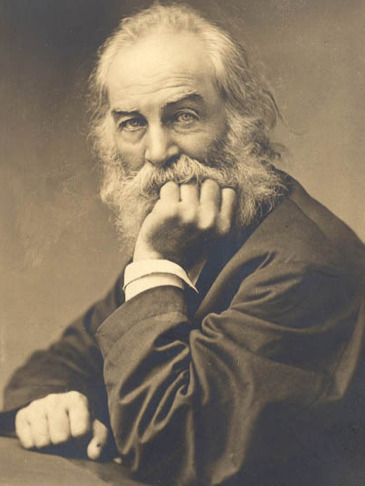
Born on May 31, 1819, Walt Whitman was the second son of Walter Whitman, a housebuilder, and Louisa Van Velsor. The family, which consisted of nine children, lived in Brooklyn and Long Island in the 1820s and 1830s.
At the age of twelve, Whitman began to learn the printer's trade, and fell in love with the written word. Largely self-taught, he read voraciously, becoming acquainted with the works of Homer, Dante, Shakespeare, and the Bible.
Whitman worked as a printer in New York City until a devastating fire in the printing district demolished the industry. In 1836, at the age of 17, he began his career as teacher in the one-room school houses of Long Island. He continued to teach until 1841, when he turned to journalism as a full-time career.
He founded a weekly newspaper, Long-Islander, and later edited a number of Brooklyn and New York papers. In 1848, Whitman left the Brooklyn Daily Eagle to become editor of the New Orleans Crescent. It was in New Orleans that he experienced at first hand the viciousness of slavery in the slave markets of that city. On his return to Brooklyn in the fall of 1848, he founded a "free soil" newspaper, the Brooklyn Freeman, and continued to develop the unique style of poetry that later so astonished Ralph Waldo Emerson.
In 1855, Whitman took out a copyright on the first edition of Leaves of Grass, which consisted of twelve untitled poems and a preface. He published the volume himself, and sent a copy to Emerson in July of 1855. Whitman released a second edition of the book in 1856, containing thirty-three poems, a letter from Emerson praising the first edition, and a long open letter by Whitman in response. During his subsequent career, Whitman continued to refine the volume, publishing several more editions of the book.
At the outbreak of the Civil War, Whitman vowed to live a "purged" and "cleansed" life. He wrote freelance journalism and visited the wounded at New York-area hospitals. He then traveled to Washington, D.C. in December 1862 to care for his brother who had been wounded in the war.
Overcome by the suffering of the many wounded in Washington, Whitman decided to stay and work in the hospitals and stayed in the city for eleven years. He took a job as a clerk for the Department of the Interior, which ended when the Secretary of the Interior, James Harlan, discovered that Whitman was the author of Leaves of Grass, which Harlan found offensive. Harlan fired the poet.
Whitman struggled to support himself through most of his life. In Washington, he lived on a clerk's salary and modest royalties, and spent any excess money, including gifts from friends, to buy supplies for the patients he nursed. He had also been sending money to his widowed mother and an invalid brother. From time to time writers both in the states and in England sent him "purses" of money so that he could get by. In the early 1870s, Whitman settled in Camden, NJ, where he had come to visit his dying mother at his brother's house.
However, after suffering a stroke, Whitman found it impossible to return to Washington. He stayed with his brother until the 1882 publication of Leaves of Grass gave Whitman enough money to buy a home in Camden. In the simple two-story clapboard house, Whitman spent his declining years working on additions and revisions to a new edition of the book and preparing his final volume of poems and prose, Good-Bye, My Fancy (1891). After his death on March 26, 1892, Whitman was buried in a tomb he designed and had built on a lot in Harleigh Cemetery.
(Source: http://www.poets.org/poet.php/prmPID/126)
More:
http://www.whitmanarchive.org/
http://en.wikipedia.org/wiki/Walt_Whi...
http://www.poetryfoundation.org/bio/w...
http://www.biography.com/people/walt-...
http://www.waltwhitman.org/
http://www.pbs.org/wgbh/amex/whitman/
http://www.brainyquote.com/quotes/aut...
http://www.english.illinois.edu/maps/...
http://www.loc.gov/rr/program/bib/whi...
http://www.findagrave.com/cgi-bin/fg....
http://www.youtube.com/watch?v=hCxA0C...




 by
by
 Walt Whitman
Walt Whitman by Philip Callow (no photo)
by Philip Callow (no photo) by Justin Kaplan (no photo)
by Justin Kaplan (no photo) by Gary Schmidgall (no photo)
by Gary Schmidgall (no photo) by Adrien Stoutenberg (no photo)
by Adrien Stoutenberg (no photo) by Henry Bryan Binns (no photo)
by Henry Bryan Binns (no photo)
Manuel Quezon
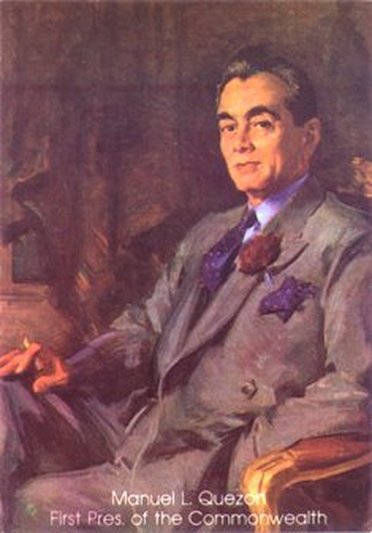

Manuel Quezon, in full Manuel Luis Quezon y Molina (born Aug. 19, 1878, Baler, Phil.—died Aug. 1, 1944, Saranac Lake, N.Y., U.S.), Filipino statesman, leader of the independence movement, and first president of the Philippine Commonwealth established under U.S. tutelage in 1935.
Quezon was the son of a schoolteacher and small landholder of Tagalog descent on the island of Luzon. He cut short his law studies at the University of Santo Tomás in Manila in 1899 to participate in the struggle for independence against the United States, led by Emilio Aguinaldo. After Aguinaldo surrendered in 1901, however, Quezon returned to the university, obtained his degree (1903), and practiced law for a few years. Convinced that the only way to independence was through cooperation with the United States, he ran for governor of Tayabas province in 1905. Once elected, he served for two years before being elected a representative in 1907 to the newly established Philippine Assembly.
In 1909 Quezon was appointed resident commissioner for the Philippines, entitled to speak, but not vote, in the U.S. House of Representatives; during his years in Washington, D.C., he fought vigorously for a speedy grant of independence by the United States. Quezon played a major role in obtaining Congress’ passage in 1916 of the Jones Act, which pledged independence for the Philippines without giving a specific date when it would take effect. The act gave the Philippines greater autonomy and provided for the creation of a bicameral national legislature modeled after the U.S. Congress. Quezon resigned as commissioner and returned to Manila to be elected to the newly formed Philippine Senate in 1916; he subsequently served as its president until 1935. In 1922 he gained control of the Nacionalista Party, which had previously been led by his rival Sergio Osmeña.
Quezon fought for passage of the Tydings–McDuffie Act (1934), which provided for full independence for the Philippines 10 years after the creation of a constitution and the establishment of a Commonwealth government that would be the forerunner of an independent republic. Quezon was elected president of the newly formulated Commonwealth on Sept. 17, 1935. As president he reorganized the islands’ military defense (aided by Gen. Douglas MacArthur as his special adviser), tackled the huge problem of landless peasants in the countryside who still worked as tenants on large estates, promoted the settlement and development of the large southern island of Mindanao, and fought graft and corruption in the government. A new national capital, later known as Quezon City, was built in a suburb of Manila.
Quezon was reelected president in 1941. After Japan invaded and occupied the Philippines in 1942, he went to the United States, where he formed a government in exile, served as a member of the Pacific War Council, signed the declaration of the United Nations against the Fascist nations, and wrote his autobiography, The Good Fight (1946). Quezon died of tuberculosis before full Philippine independence was established.
(Source: http://www.britannica.com/EBchecked/t...
Manuel-Quezon)
More:
http://globalnation.inquirer.net/4749...
http://en.wikipilipinas.org/index.php...
https://en.wikipedia.org/wiki/Manuel_...
http://www.pbs.org/wgbh/amex/macarthu...
http://www.quezon.ph/familyinfo/manue...
http://tagaloglang.com/Famous-Filipin...
http://malacanang.gov.ph/presidents/c...
http://rescueinthephilippines.com/?p=104
http://www.youtube.com/watch?v=msH2H0...
http://www.youtube.com/watch?v=taHy0G...
http://www.unesco.org/new/en/communic...
http://www.nndb.com/people/150/000098...
 by
by
 John Gunther
John Gunther
 by Frank Ephraim
by Frank Ephraim
 by
by
 Manuel L. Quezon
Manuel L. Quezon
 by
by
 Manuel L. Quezon III
Manuel L. Quezon III
(no image) Eagle Of The Philippines: President Manuel Quezonby Elinor Goettel (no photo)


Manuel Quezon, in full Manuel Luis Quezon y Molina (born Aug. 19, 1878, Baler, Phil.—died Aug. 1, 1944, Saranac Lake, N.Y., U.S.), Filipino statesman, leader of the independence movement, and first president of the Philippine Commonwealth established under U.S. tutelage in 1935.
Quezon was the son of a schoolteacher and small landholder of Tagalog descent on the island of Luzon. He cut short his law studies at the University of Santo Tomás in Manila in 1899 to participate in the struggle for independence against the United States, led by Emilio Aguinaldo. After Aguinaldo surrendered in 1901, however, Quezon returned to the university, obtained his degree (1903), and practiced law for a few years. Convinced that the only way to independence was through cooperation with the United States, he ran for governor of Tayabas province in 1905. Once elected, he served for two years before being elected a representative in 1907 to the newly established Philippine Assembly.
In 1909 Quezon was appointed resident commissioner for the Philippines, entitled to speak, but not vote, in the U.S. House of Representatives; during his years in Washington, D.C., he fought vigorously for a speedy grant of independence by the United States. Quezon played a major role in obtaining Congress’ passage in 1916 of the Jones Act, which pledged independence for the Philippines without giving a specific date when it would take effect. The act gave the Philippines greater autonomy and provided for the creation of a bicameral national legislature modeled after the U.S. Congress. Quezon resigned as commissioner and returned to Manila to be elected to the newly formed Philippine Senate in 1916; he subsequently served as its president until 1935. In 1922 he gained control of the Nacionalista Party, which had previously been led by his rival Sergio Osmeña.
Quezon fought for passage of the Tydings–McDuffie Act (1934), which provided for full independence for the Philippines 10 years after the creation of a constitution and the establishment of a Commonwealth government that would be the forerunner of an independent republic. Quezon was elected president of the newly formulated Commonwealth on Sept. 17, 1935. As president he reorganized the islands’ military defense (aided by Gen. Douglas MacArthur as his special adviser), tackled the huge problem of landless peasants in the countryside who still worked as tenants on large estates, promoted the settlement and development of the large southern island of Mindanao, and fought graft and corruption in the government. A new national capital, later known as Quezon City, was built in a suburb of Manila.
Quezon was reelected president in 1941. After Japan invaded and occupied the Philippines in 1942, he went to the United States, where he formed a government in exile, served as a member of the Pacific War Council, signed the declaration of the United Nations against the Fascist nations, and wrote his autobiography, The Good Fight (1946). Quezon died of tuberculosis before full Philippine independence was established.
(Source: http://www.britannica.com/EBchecked/t...
Manuel-Quezon)
More:
http://globalnation.inquirer.net/4749...
http://en.wikipilipinas.org/index.php...
https://en.wikipedia.org/wiki/Manuel_...
http://www.pbs.org/wgbh/amex/macarthu...
http://www.quezon.ph/familyinfo/manue...
http://tagaloglang.com/Famous-Filipin...
http://malacanang.gov.ph/presidents/c...
http://rescueinthephilippines.com/?p=104
http://www.youtube.com/watch?v=msH2H0...
http://www.youtube.com/watch?v=taHy0G...
http://www.unesco.org/new/en/communic...
http://www.nndb.com/people/150/000098...
 by
by
 John Gunther
John Gunther by Frank Ephraim
by Frank Ephraim by
by
 Manuel L. Quezon
Manuel L. Quezon by
by
 Manuel L. Quezon III
Manuel L. Quezon III(no image) Eagle Of The Philippines: President Manuel Quezonby Elinor Goettel (no photo)
 Laurence Sherman Kuter
Laurence Sherman Kuter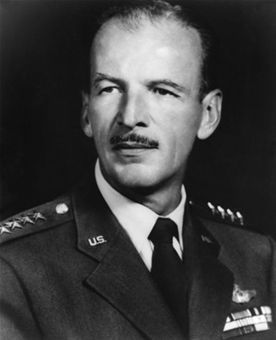
Laurence Sherman Kuter was one of the founding fathers of the independent Air Force and a framer of the Air War Plan document that mapped out the defeat of Germany in World War II. He was also the first commander of both the Military Air Transport Service and Pacific Air Forces.
He was born in Rockford, Ill., in 1905, and graduated from the U.S. Military Academy, West Point, N.Y., June 14, 1927.
Early in 1941 he was one of the four principal authors of Air War Plans Division 1, Munitions Requirements of the Army Air Force, the war plan that served as the blueprint for the air assault on Germany. This plan was used almost without change.
Kuter was the youngest general officer in the Army in 1942, and he never served in the active rank of colonel. His was the first "jump" promotion of an officer since the Civil War when William T. Sherman was promoted. His assignments were varied by serving on the War Department staff and General Henry H. Arnold's staff, commanding a bomb wing in England, and was the deputy commander of the Northwest African Tactical Air Force. He returned to Washington for the rest of the war after Germany's surrender in Africa, even representing the Army Air Forces at the Yalta and Malta conferences in 1945 during General Arnold's illness.
In September 1947, he was reappointed by presidential order as the U.S. representative to the permanent International Civil Aviation Organization. In his appointment he had the diplomatic rank of minister. During this period of the birth of international agreements in aviation, Kuter participated in major civil aviation conferences in London, Cairo, Lima and Rio de Janeiro.
This experience led President Truman to nominate him for the chairmanship of the Civil Aeronautics Board. The Senate committee refused to confirm the nomination of another military man to a high-level civililan position, and indicated that it would be necessary for Kuter to resign from the service. He preferred not to resign from the Air Force and asked that his nomination be withdrawn.
After the war he again served on the Air Staff, and then headed the Military Air Transport Service, the first integrated military service, now called a unified command. MATS proved its organizational soundness and capability in its first six months of operations when its global resources were directed into the operation of the Berlin airlift. Under Kuter's leadership MATS also developed and managed a 12,000-mile logistical pipeline between the U.S. and Asia at the outbreak of hostilities in Korea in June 1950.
When he assumed command of the Far East Air Forces, Kuter immediately found the mobility of air power impeded by the existence of two major commands in the Pacific. His air units were split between the Far East Command in Tokyo and the Pacific Command in Hawaii. He could not move air units from one of these commands to the other without permission of two theater commanders or the Joint Chiefs in Washington. His objections to the divided command system were registered in a formal recommendation to the Air Force Chief of Staff. This led to the consolidation of the two commands and establishment of the present Pacific Command.
When Far East Air Forces was disestablished in this consolidation of command, Kuter became commander in chief of the newly created Pacific Air Forces July 1, 1957. In his career, he logged more than 8,000 flying hours, including 3,200 hours as a command pilot. Before 1952 he had flown around the world seven times visiting Air Force installations.
His final assignment was the commander of the North American Aerospace Command in Colorado Springs, Colo. Leaving active duty in July, 1962, Kuter was a avid collector and historian, and donated his collection of papers covering his entire 35-year career to the U.S. Air Force Academy.
He was the author of "An Airman at Yalta" (New York: Duell, Sloan, and Pearce, 1955) and "The Great Gamble" (1973).
Kuter died in Naples, Fla., Nov. 30, 1979.
(Source: http://www.af.mil/information/heritag...)
More:
http://en.wikipedia.org/wiki/Laurence...
http://www.airpower.maxwell.af.mil/ai...
http://select.nytimes.com/gst/abstrac...
http://projects.militarytimes.com/cit...
http://www.ion.org/search/view_abstra...
http://www.criticalpast.com/video/656...
http://www.ovguide.com/laurence-s-kut...
http://www.foreignaffairs.com/author/...
http://www.washingtonpost.com/wp-dyn/...
http://www.atalink.org/HallOfFame/Mem...
http://www.findagrave.com/cgi-bin/fg....
http://books.google.com/books?id=OJgf...
http://books.google.com/books?id=t1Op...
 by B. Chance Saltzman (no photo)
by B. Chance Saltzman (no photo) by Roger Miller (no photo)
by Roger Miller (no photo) by Richard H. Kohn (no photo)
by Richard H. Kohn (no photo)(no image) The Great Gamble by Laurence S. Kuter (no photo)
(no image) Foundation of the Force: Air Force Enlisted Personnel Policy 1907-1956 by Air Force History and Museums Program (U.S.) (no photo)
 Arthur Travers Harris
Arthur Travers Harris
Harris led RAF Bomber Command in World War Two, earning him the nickname 'Bomber Harris'. His implementation of the policy of 'saturation' or 'area' bombing of German cities has made him a hugely controversial figure.
Arthur Travers Harris was born on 13 April 1892 in Cheltenham. His father was in the Indian Civil Service. Harris went to boarding school in England and then settled in Rhodesia in southern Africa. At the outbreak of World War One he joined a local unit and then returned to England and joined the Royal Flying Corps. His experiences as a pilot on the Western Front shaped his opinion of air bombing as preferable to the mass slaughter of the trenches.
In 1918, Harris became a squadron leader in the newly formed RAF, and during the following two decades served in India and the Middle East. He returned to England at the outbreak of war and in early 1942, he took over as commander-in-chief of Bomber Command and was promoted to air chief marshal. At the time, heavy losses of bombers on daytime raids and wildly inaccurate nighttime raids had led to the suspension of long-range sorties by the RAF. Harris set out to implement a new and more efficient bombing strategy.
In May 1942, he gathered together the maximum number of available bombers and devastated the German city of Cologne in the first 'thousand bomber' raid. New tactics were learned and though subsequent raids of the same size were not as successful, the raid helped boost the morale of Bomber Command and the British public. There was initially support for Harris' belief that area bombing alone would destroy Germany's will to fight, but mounting losses, combined with evidence that the German spirit was unbroken, eroded this support and brought him into conflict with Winston Churchill. The most controversial raid was in February 1945 when the German city of Dresden was obliterated.
Harris commanded respect from his subordinates and enormous loyalty from his crews. But the debate about the morality - and indeed efficacy - of the bombing raids was already under way in the closing stages of the war, and to Harris' disappointment, his request for a special campaign medal for the Bomber Command was refused.
In 1946, he retired from the RAF and embarked on a successful business career in South Africa, but later returned to Britain where he was made a baronet. He died on 5 April 1984.
(Source: http://militaryhistory.about.com/gi/o...)
More:
http://en.wikipedia.org/wiki/Sir_Arth...
http://www.britannica.com/EBchecked/t...
http://militaryhistory.about.com/od/a...
http://militaryhistory.about.com/gi/o...
http://militaryhistory.about.com/gi/o...
http://www.mindef.gov.sg/safti/pointe...
http://www.raf.mod.uk/bombercommand/c...
http://www.rafweb.org/Biographies/Har...
http://www.bible-researcher.com/dresd...
 by
by
 Robin Neillands
Robin Neillands by John V. Denson (no photo)
by John V. Denson (no photo) by Stephen A. Garrett (no photo)
by Stephen A. Garrett (no photo) by Alan W. Cooper (no photo)
by Alan W. Cooper (no photo) by Henry Probert (no photo)
by Henry Probert (no photo)
 Oscar Westover
Oscar Westover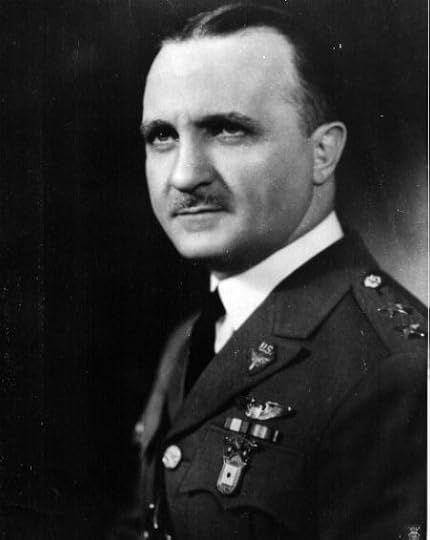
Major General Oscar Westover was chief of the Air Corps from December 1935 until September 1938, and was in part responsible for the beginning of a period of expansion that ended with the emergence of the U.S. Air Force as a separate service.
Oscar Westover was born in Bay City, Mich., in 1883. His military service began as an enlisted man in the U.S. Army from 1901 to 1902, when he was appointed to the U.S. Military Academy. He graduated in 1906 and was commissioned a second lieutenant in the infantry. Westover was promoted to first lieutenant on April 13, 1911; to captain on July 1, 1916; and to major on Oct. 20, 1917.
In 1919 Captain Westover was detailed to the Aviation Section, Signal Corps, and in 1920 transferred to the Air Service with the rank of major. (He had previously been promoted to lieutenant colonel and colonel.) Westover attended the Air Service Balloon School in 1921, the Air Service Airship School in 1922, the Air Service Primary Flying and Advanced Flying Schools in 1923, the Air Corps Tactical School in 1927, and Command and General Staff School to January 1932, both as a student and as an instructor. As a result of various courses, Westover was awarded aeronautical ratings as a balloon observer, airship pilot, airplane pilot, and airplane observer.
Westover served as assistant executive and executive in the Office, Chief of the Air Service, from November 1918 to November 1920. He was appointed director of aircraft production in the Office, Chief of the Air Corps in April 1921, serving until December 1922. From 1924 to 1926 he served as commandant of the Air Service Tactical School at Langley Field, Va., and as commanding officer of Langley Field. On Jan. 13, 1930 he was promoted to lieutenant colonel and on Dec. 22, 1931 appointed assistant to the chief of the Air Corps and promoted to brigadier general. He was named chief of the Air Corps and promoted to major general on Dec. 22, 1935. He spent the next two-and-a-half years flying to bases around the country to step up pilot training and increase the emphasis on aviation which would be important in the 1940s. On Sept. 21, 1938, General Westover lost his life in an airplane accident near the Lockheed plant at Burbank, Calif., when his plane burst into flames on landing. Westover Air Force Base, Chicopee Falls, Mass., was named in his honor in June 1949.
General Westover has been awarded the Distinguished Service Medal and the World War I Victory Medal.
(Source: http://www.af.mil/information/bios/bi...)
More:
http://en.wikipedia.org/wiki/Oscar_We...
http://www.westoverafbhistory.com/wes...
http://www.flickr.com/photos/sdasmarc...
http://news.google.com/newspapers?nid...
http://www.highbeam.com/doc/1G1-12607...
http://projects.militarytimes.com/cit...
http://www.redirectify.com/people/osc...
http://www.airforcemag.com/MagazineAr...
http://www.armchairgeneral.com/journe...
http://www.jcs-group.com/military/joh...
 by David E. Johnson (no photo)
by David E. Johnson (no photo) by General Henry H. Arnold (no photo)
by General Henry H. Arnold (no photo) by William P. Head (no photo)
by William P. Head (no photo) by John C. Fredriksen (no photo)
by John C. Fredriksen (no photo) by Warren A. Trest (no photo)
by Warren A. Trest (no photo)
 Orville and Wilbur Wright
Orville and Wilbur Wright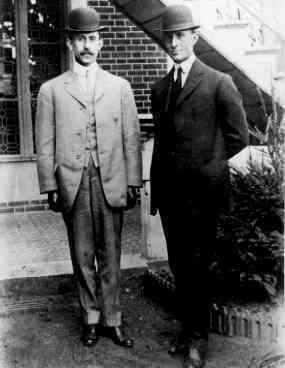
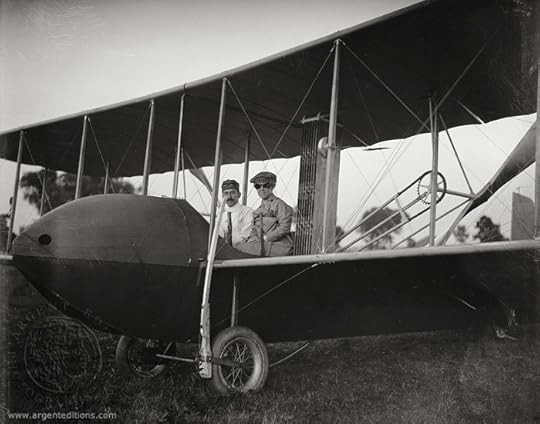
At the dawn of the 20th Century, many efforts were underway to become the first to fly. Most inventors of the day were impulsive and undisciplined. They would build a plane one day and try to fly it the very next day, with their results either disastrous or simply unproductive. The Wright Brothers, on the other hand, were much more scientific and methodical in their approach. As bicycle mechanics, the brothers believed in testing out their ideas laboriously before proceeding with further advancements. To help gauge their progress, they built a wind tunnel - the first one built for the purpose of checking an aircraft wing design. In the years preceding their first flight, the Wrights successfully conducted almost a thousand flights in gliders before they felt ready to begin production of a motor-powered flyer.
After years of development, Orville and Wilbur Wright finally were ready to test their first powered plane, the Wright Flyer. On the morning of December 17, 1903, Orville and Wilbur stood on the beach at Kitty Hawk, North Carolina and actually flipped a coin to see who would be first to try out the flyer. Orville won. That first flight lasted only 12 seconds and covered only 120 feet, but it was historic - the world's first powered, controlled flight. The two brothers took turns and actually made other successful flights that day - the longest lasting 59 seconds and traveling 852 feet.
Wishing to establish a patent for their plane, Orville and Wilbur Wright retreated to their bicycle shop where they kept their flyer out of public view.
Rather than calling attention to their historic feat, though, the Wright Brothers actually concealed their invention, opting to retreat to their bicycle shop in Dayton, Ohio. Fearing a rival inventor might make off with their design if they observed the plane in flight, the Wright Brothers became obsessed with obtaining a patent for the Wright Flyer. Over the next five years, the Wright Brothers rarely flew - and if they did, it was for themselves, not at public demonstrations.
While Orville and Wilbur isolated themselves, other aviators began taking to the skies and - unlike the Wright Brothers - found widespread press coverage for their achievements. Brazilian Alberto Santos-Dumont made headlines in Europe with his brief 1906 flight in France. On July 4, 1908, American Glenn Curtiss won a silver trophy and national acclaim for flying his plane, June Bug, over one kilometer at a public exhibition. The praise being heaped on these aviators was like a thorn in the side for the brothers, who already were flying much longer distances at much greater heights than their aviation counterparts.
Once the Wrights had been granted their patent, they finally felt secure enough to begin proving to the world that they, indeed, were the true pioneers of aviation. The place they chose was France. Many Europeans as the time were skeptical of the reports made about the Wright Brothers' ability to fly. They wanted to see the Americans take to the skies for themselves. Wilbur Wright set sail for France along with an unassembled version of one of their planes. On August 8, 1908, in front of a cynical crowd of French reporters and public dignitaries, Wilbur Wright climbed into his flyer and put on an aerial display which stunned the spectators. The French were only accustomed to seeing flights which lasted only a few brief seconds. The Wright Flyer could stay aloft for minutes, even hours. In a later demonstration of the Wrights incredible flight skills, Wilbur Wright was able to circle his plane for more than two and a half hours. Arriving under a cloud of skepticism, the Wrights left France hailed as masters of aviation.
In the years following their triumphant from France, the Wright Brothers officially formed their own aircraft company. But instead of focusing on improving their original biplane design, the Wrights chose to launch lawsuit after lawsuit against rival plane-makers, such as Glenn Curtiss. The Wrights claimed that these competing manufacturers infringed upon the patents they owned. The legal battles continued for years. The case was eventually decided in 1914. While the courts sided with the Wrights, their victory was ultimately a hollow one. Wilbur Wright had died of typhoid fever two years earlier. Orville Wright, in the meantime, was in the midst of selling the company he and his brother built. In the years ahead, other plane designers and manufacturers would pick up where the Wrights had left off, continuing to soar higher, faster and farther.
(Source: http://www.pbs.org/kcet/chasingthesun...)
More:
http://en.wikipedia.org/wiki/Wright_b...
http://www.shapell.org/manuscript.asp...
http://www.scientificamerican.com/art...
http://invention.psychology.msstate.edu/
http://invention.psychology.msstate.e...
http://airandspace.si.edu/wrightbroth...
http://www.findagrave.com/cgi-bin/fg....
http://www.findagrave.com/cgi-bin/fg....
http://www.awesomestories.com/history...
http://www.wright-brothers.org/
 by Fred C. Kelly (no photo)
by Fred C. Kelly (no photo) by Fred Howard (no photo)
by Fred Howard (no photo) by Harry Combs (no photo)
by Harry Combs (no photo) by John D. Anderson (no photo)
by John D. Anderson (no photo)(no image) One Day At Kitty Hawk: The Untold Story Of The Wright Brothers And The Airplane by John Evangelist Walsh (no photo)
 Captain John L. McCrea
Captain John L. McCrea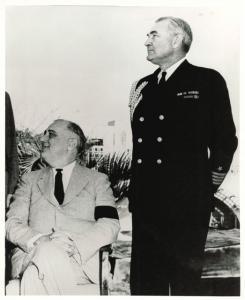
John McCrea was a Naval Academy midshipman in 1914 when his ship, the USS Idaho (BB-24) was sold to Greece on the eve of World War I. After graduating in 1915 he served in the USS New York (BB-34) and was present when the German fleet surrendered following the war.
In the 1920s and 1930s he matured as a naval officer, serving in a number of destroyers and taking time to get a law degree. He served a tour in Guam in the 1930s, then was executive officer of the battleship Pennsylvania.
In 1941, as an aide to CNO Harold Stark, he made a trip to the Pacific to deliver revised war plans to the top commanders. At the beginning of the war he served a year as naval aide to President Franklin D. Roosevelt, then was first skipper of the battleship Iowa (BB-61).
After the war he held a series of positions, including DCNO (Administration) and Deputy Commander in Chief Pacific Fleet. After duty as Commandant First Naval District, he retired in 1953 and worked for John Hancock Insurance Company. He died in 1990. (Source: http://www.usni.org/heritage/mccrea)
More:
http://books.google.com/books?id=B7ol...
http://www.pacificbattleship.com/page...
http://www.nytimes.com/1990/01/30/obi...
http://digicoll.library.wisc.edu/cgi-...
http://en.wikipedia.org/wiki/USS_Iowa...
http://pearlharboronline.com/#Captain...
http://www.lexisnexis.com/documents/a...
http://www.whitehousehistory.org/whha...
 by George Mckee Elsey (no photo)
by George Mckee Elsey (no photo) by
by
 Barrett Tillman
Barrett Tillman by Grzegorz Nowak (no photo)
by Grzegorz Nowak (no photo) by
by
 Gordon W. Prange
Gordon W. Prange by Michael Gannon (no photo)
by Michael Gannon (no photo) by Edward L. Beach, Jr. (no photo)
by Edward L. Beach, Jr. (no photo) by Edwin T. Layton (no photo)
by Edwin T. Layton (no photo)
 Senator Burton Wheeler
Senator Burton Wheeler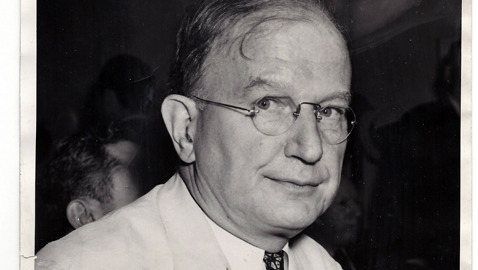
Burton Kendall Wheeler was born in Hudson, Massachusetts on 27th February, 1882. He was admitted to the bar after graduating from the University of Michigan in 1905 and worked as a lawyer in Silver Bow County, Montana.
A member of the Democratic Party, Wheeler was elected to the Montana house of representatives (1910-1912) and was district attorney for Montana (1913-1918). Wheeler was an unsuccessful candidate for governor of Montana in 1920 but was elected to the Senate two years later.
In 1924 Wheeler and Robert LaFollette became the candidates of the Progressive Party in the 1924 presidential election. Although they gained support from trade unions, the Socialist Party and the Scripps-Howard newspaper chain, La Follette and Wheeler, only won one-sixth of the votes.
Returning to the Democratic Party Wheeler was elected to the Senate for Montana in 1928, 1934 and 1940. In September 1940, Wheeler helped Charles A. Lindbergh and Norman Thomas to form the America First Committee (AFC). I t soon became the most powerful isolationist group in the United States. The AFC had four main principles: (1) The United States must build an impregnable defense for America; (2) No foreign power, nor group of powers, can successfully attack a prepared America; (3) American democracy can be preserved only by keeping out of the European War; (4) "Aid short of war" weakens national defense at home and threatens to involve America in war abroad. In one speech he argued: "You can't put your shirt tail into a clothes wringer and pull it out suddenly when the wringer keeps turning."
On 17th December, 1940, Franklin D. Roosevelt made a speech to the American public: "In the present world situation of course there is absolutely no doubt in the mind of a very overwhelming number of Americans that the best immediate defence of the United States is the success of Great Britain in defending itself; and that, therefore, quite aside from our historic and current interest in the survival of democracy in the world as a whole, it is equally important, from a selfish point of view of American defence, that we should do everything to help the British Empire to defend itself... In other words, if you lend certain munitions and get the munitions back at the end of the war, if they are intact - haven't been hurt - you are all right; if they have been damaged or have deteriorated or have been lost completely, it seems to me you come out pretty well if you have them replaced by the fellow to whom you have lent them."
Isolationists like Wheeler, Arthur Vandenberg of Michigan and Thomas Connally of Texas argued that this legislation would lead to American involvement in the Second World War. In early February 1941 a poll by the George H. Gallup organisation revealed that only 22 percent were unqualifiedly against the President's proposal. It has been argued by Thomas E. Mahl, the author of Desperate Deception: British Covert Operations in the United States, 1939-44 (1998), has argued that the Gallup organization had been infiltrated by the British Security Coordination (BSC).
Hadley Cantril, a member of the faculty of Princeton University Department of Psychology, had used a grant from the Rockefeller Foundation to establish the Office of Public Opinion Research. A supporter of President Franklin D. Roosevelt and intervention in the Second World War he was also an agent for the British Security Coordination and did work for the anti-isolationist group, Fight for Freedom. Cantril was of the opinion that Roosevelt needed "an improving body of public opinion to sustain him in each measure of assistance to Britain and the USSR." Cantril was also an advisor to George H. Gallup and worked closely with David Ogilvy, who was employed by Gallup and was also an agent for BSC.
Another BSC agent, Sanford Griffith, established a company Market Analysts Incorporated and was initially commissioned to carry out polls for the anti-isolationist Committee to Defend America by Aiding the Allies. Griffith's assistant, Francis Adams Henson, a long time activist against the Nazi Germany government, later recalled: "My job was to use the results of our polls, taken among their constituents, to convince on-the-fence Congressmen and Senators that they should favor more aid to Britain."
As Richard W. Steele has pointed out: "public opinion polls had become a political weapon that could be used to inform the views of the doubtful, weaken the commitment of opponents, and strengthen the conviction of supporters." William Stephenson later admitted: "Great care was taken beforehand to make certain the poll results would turn out as desired. The questions were to steer opinion toward the support of Britain and the war... Public Opinion was manipulated through what seemed an objective poll."
Wheeler gave the most passionate speech against the proposed legislation: "Never before have the American people been asked or compelled to give so bounteously and so completely of their tax dollars to any foreign nation. Never before has the Congress of the United States been asked by any President to violate international law. Never before has this nation resorted to duplicity in the conduct of its foreign affairs. Never before has the United States given to one man the power to strip this nation of its defenses. Never before has a Congress coldly and flatly been asked to abdicate. If the American people want a dictatorship - if they want a totalitarian form of government and if they want war - this bill should be steam-rollered through Congress, as is the wont of President Roosevelt. Approval of this legislation means war, open and complete warfare. I, therefore, ask the American people before they supinely accept it: Was the last World War worthwhile?"
The major surprise of the debate was that Arthur Vandenberg announced on the floor of the Senate that he had finally decided to support the loan. He warned his colleagues: "If we do not lead some other great and powerful nation will capitalize our failure and we shall pay the price of our default." Richard N. Gardner, the author of Sterling Dollar Diplomacy in Current Perspective (1980), has argued that Vandenberg's speech was the "turning point in the Senate Debate" with sixteen other Republicans voting in favour of the bill.
The AFC influenced public opinion through publications and speeches and within a year had over 800,000 members. The AFC was dissolved four days after the Japanese Air Force attacked Pearl Harbor on 7th December, 1941.
Burton Kendall Wheeler died in Washington, on 6th January, 1975.
(Source: http://www.spartacus.schoolnet.co.uk/...)
More:
http://en.wikipedia.org/wiki/Burton_K...
http://bioguide.congress.gov/scripts/...
http://www.senate.gov/artandhistory/h...
http://www.lib.montana.edu/archives/w...
http://www.knoxfocus.com/2012/12/burt...
http://teachingamericanhistory.org/li...
http://www.antiwar.com/justin/j090501...
http://www.nwhistorycourse.org/ttcour...
http://www.drumlummon.org/images/DV_v...
http://www.authentichistory.com/1939-...
http://www.govtrack.us/congress/membe...
 by David O'Toole (no photo)
by David O'Toole (no photo) by John Morrison (no photo)
by John Morrison (no photo) by William A. Cook (no photo)
by William A. Cook (no photo)(no image) Yankee from the West: The Candid, Turbulent Life Story of the Yankee-Born U.S. Senator from Montana by Burton Wheeler (no photo)
(no image) Mrs. Wheeler Goes to Washington: Mrs. Burton Kendall Wheeler, Wife of the Senator from Montana by Elizabeth Wheeler Colman (no photo)
 Joseph W. Martin Jr.
Joseph W. Martin Jr.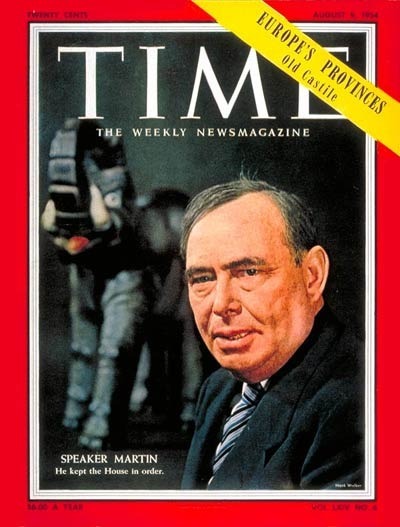
Joseph William Martin, Jr. (November 3, 1884 – March 6, 1968) was a Republican Congressman and Speaker of the House from North Attleboro, Massachusetts. He was notably the only Republican to serve as Speaker between 1931 and 1995.
Martin served as Speaker of the House of Representatives on two separate occasions from 1947 to 1949 and from 1953 to 1955. These terms represented two Republican short-term majorities in the House, and Martin's two terms were bookended by Sam Rayburn, the Texas Democrat and mentor of Lyndon Johnson with whom Martin enjoyed a warm personal relationship.
In 1948, Martin traveled with his presidential nominee Thomas E. Dewey in North Attleboro, where Martin's mother, the former Catherine Keating (died 1957), told the confident Dewey, the governor of New York, that he was too complacent in the campaign and could not take victory for granted. "Don't take it so easy," she admonished. Later Dewey confessed to Martin that Dewey could be more forceful in speaking on behalf of other candidates, such as Eisenhower, than he could for himself because of Dewey's innate hesitancy to tout his own abilities.
In 1952, Martin urged General Douglas MacArthur, whom he had invited to give the speech before Congress popularly called "Old Soldiers Never Die," to seek the Republican presidential nomination. MacArthur, however, favored U.S. Senator Robert A. Taft, Sr., of Ohio, who lost the nomination to Willkie in 1940, to Dewey in 1948, and to Dwight Eisenhower in 1952. Eisenhower then defeated Governor Adlai E. Stevenson, Jr., of Illinois.
In preparation for the 1952 elections, Martin traveled to Hot Springs, Arkansas, for a regional Republican meeting called by state party chairman Osro Cobb, a former member of the Arkansas House of Representatives, to unveil a potential strategy to make the GOP competitive in the American South. "We came away from the meeting more determined and better prepared to advance the two-party system in the South," recalls Cobb in his memoirs, as the Republicans won at the presidential level that year in Tennessee, Texas, Florida, and Virginia.
Following dramatic Republican losses in the 1958 election cycle, which placed a return to majority status out of reach (for thirty-six more years, as it turned out, until the 1994 Republican Revolution), Martin was ousted from the leadership by Charles A. Halleck of Indiana, whom Martin had befriended after Halleck's election to the House. In spite of this defeat, Martin chose to remain as a backbench member of the House. Eight years later, in 1966, he was ousted from his seat in the Republican primary by the more liberal Margaret Heckler, who was forty-six years his junior, and later a member of the Cabinet of President Ronald W. Reagan. (Source: https://en.wikipedia.org/wiki/Joseph_....)
More:
http://bioguide.congress.gov/scripts/...
http://www.nndb.com/people/083/000119...
http://history.house.gov/People/Detai...
http://www.trumanlibrary.org/whistles...
http://turtledove.wikia.com/wiki/Jose...
http://news.google.com/newspapers?nid...
http://fineartamerica.com/featured/re...
http://www.britannica.com/EBchecked/t...
 by James J. Kenneally (no photo)
by James J. Kenneally (no photo) by Howard Gutman (no photo)
by Howard Gutman (no photo) by William Henry Smith (no photo)
by William Henry Smith (no photo) by Mark Grossman (no photo)
by Mark Grossman (no photo) by Lewis L. Gould (no photo)
by Lewis L. Gould (no photo) by Robert E. Jenner (no photo)
by Robert E. Jenner (no photo) by Joseph Fried (no photo)
by Joseph Fried (no photo)(no image)My First Fifty years in Politics by Joseph W. Martin (no photo)
 William J. Donovan
William J. Donovan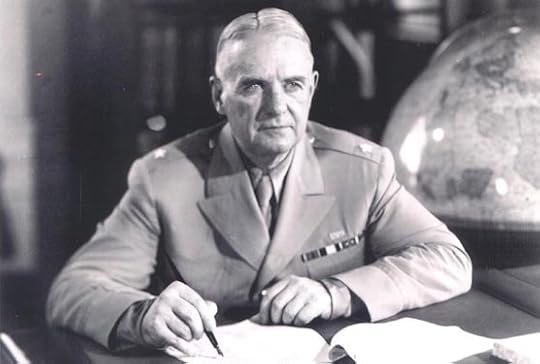
William “Wild Bill” Donovan is considered the father of American centralized intelligence. Major General Donovan led the Office of Strategic Services (OSS) from 1942 to 1945. The OSS is the forerunner of today’s Central Intelligence Agency (CIA). Throughout his lifetime of service he was awarded numerous medals. He was the first person in American history to have earned the country’s four highest awards: The Congressional Medal of Honor, the Distinguished Service Cross, the Distinguished Service Medal, and the National Security Medal.
William Joseph Donovan was born January 1, 1883 in Buffalo, New York. The grandson of Irish immigrants, he was very religious and wanted to become a Catholic Priest. He was a life-long Republican, but believed in supporting the best man, no matter what their political affiliation. Donovan graduated from Columbia Law School in 1907 and practiced corporate law. He joined the New York National Guard in 1912 as a captain. Captain Donovan served on the Mexican border during the campaign against Pancho Villa in 1916.
During World War 1, Donovan served as a major in the 165th (formerly 69th) New York Infantry Regiment, Rainbow Division. In France he led troops into battle throughout the Champagne-Marne, St. Mihiel, and Argonne campaigns. His courage under fire earned Donovan the nickname “Wild Bill”. He was wounded several times and for his service at Landres-et-St.Georges he was awarded the Congressional Medal of Honor. By the end of WWI, Donovan had been promoted to the rank of colonel and awarded several medals by the United States and its European allies. He became one of the most decorated soldiers of WWI.
Colonel Donovan began his intelligence career while serving with the American Expeditionary Force during the Russian Civil War. Donovan continued his intelligence gathering in the 1920s and 1930s through fact-finding trips in Europe. In 1941, President Roosevelt chose Donovan to head the new Office of the Coordinator of information (COI). The main goal of the COI was to get the intelligence braches of the Army, Navy, FBI, and State Department to work more closely together.
The Office of Strategic Services (OSS) was formed out of the COI after America entered the Second World War. Colonel (and later Major General) Donovan was once again selected to lead this intelligence operation. The OSS conducted espionage, sabotage, and morale operations against Nazi-Germany in Europe and Japanese Forces in Asia. The OSS was instrumental in preparing the French resistance for Operation Overload (D-Day). In Burma, OSS Detachment 101 led very successful missions against the Japanese military. President Roosevelt referred to Donovan as his “secret legs” and General Dwight D. Eisenhower though very highly of him as well. However, not everybody appreciated Donovan and the OSS. Some notable critics were FBI Director J. Edgar Hoover, General Douglas MacArthur, President Harry S. Truman, and several members of the Joint Chiefs of Staff.
In September 1945, the OSS was dissolved (the CIA would take its place in 1947). Donovan became a lawyer once again, first during the prosecution of Nazis at the Nuremberg War Crimes Tribunal and later as a Wall Street lawyer. From 1953-1954 he was appointed Ambassador to Thailand by President Eisenhower. In 1956 he was diagnosed with arteriosclerosis. Donovan died on February 8, 1959 in Washington DC and is buried at Arlington National Cemetery.
(Source: http://www.nps.gov/prwi/historycultur...)
More:
http://www.spartacus.schoolnet.co.uk/...
http://www.arlingtoncemetery.net/wjod...
https://www.cia.gov/news-information/...
https://en.wikipedia.org/wiki/William...
http://www.homeofheroes.com/moh/citat...
http://www.lawschool.cornell.edu/libr...
http://www.findagrave.com/cgi-bin/fg....
http://vault.fbi.gov/William%20J%20Do...
http://c250.columbia.edu/c250_celebra...
http://www.britannica.com/EBchecked/t...

 by Thomas F. Troy (no photo)
by Thomas F. Troy (no photo) by Anthony Cave Brown (no photo)
by Anthony Cave Brown (no photo) by Douglas Waller (no photo)
by Douglas Waller (no photo) by William Stevenson (no photo)
by William Stevenson (no photo)
 Charles L. McNary
Charles L. McNary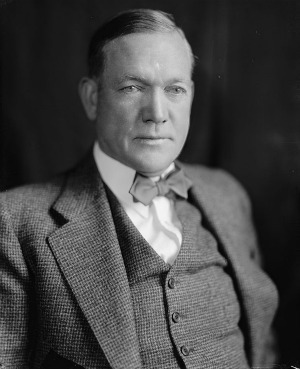
Charles Linza McNary represented Oregon in the U.S. Senate from 1917 until his death in 1944. In an era that saw the challenges of World War I, the Great Depression, and World War II, he established a national reputation as a thoughtful, effective, and independent legislative leader.
One of ten children born to a farming family near Salem in 1874, McNary lost both parents when he was a child and was raised by his older sister. He attended Stanford University and then returned to Salem to enroll in Willamette University’s School of Law. In 1902, he married Jessie Breyman, a member of a prominent Salem family. She was killed in an automobile accident in 1918. In 1923, he married Cornelia Morton, and the two adopted a daughter, Charlotte. Throughout his political career, McNary found refuge at his Salem farm, Fir Cone, where he raised nut and fruit trees and was recognized as a horticulturist.
After graduation and admission to the Oregon State Bar, McNary practiced in Salem with his brother John until he was named deputy district attorney of the Third Judicial District in 1904. In 1908, he became the dean of the Willamette Law School.
Governor Oswald West named McNary to fill a vacancy on the Oregon Supreme Court in 1913, but he lost the 1914 Republican primary and left the court in January 1915. He continued his involvement in Oregon politics, however, and became chair of the state Republican Party in 1916. In 1917, Governor James Withycombe appointed him to the Senate to fill the seat left vacant by the death of Senator Harry Lane. The following year, he was elected to the office.
In the Senate, McNary quickly attracted the attention of his colleagues when he spoke out forcibly in favor of United States membership in the League of Nations. Veteran Senator Henry Cabot Lodge, a Republican from Massachusetts and one of the League’s leading opponents, nevertheless admired McNary and opened the way for his appointment to the Agriculture and Forestry Committee.
In 1924, McNary became the committee’s chair and quickly moved to introduce bills dealing with issues important to Oregon voters. He and New York Congressman John D. Clarke secured passage of the Clarke-McNary Act, which encouraged forest fire protection, reforestation, and the expansion of national forest lands. With Republican Representative Gilbert N. Haugen from Iowa, he initiated a bill designed to address the postwar recession in agriculture by providing for government purchase of crop surpluses. Over three years, the two managed to get the bill through Congress only to see it vetoed by President Calvin Coolidge. The bill is recognized as the prototype for subsequent agricultural subsidy legislation.
In the face of the growing influence of the Ku Klux Klan in Oregon, in 1922 McNary endorsed Governor Ben Olcott for reelection, a candidate the Klan opposed. He supported the governor despite warnings that his stand could endanger his own reelection in 1924. In fact, McNary considered not running in 1924 in lieu of a cabinet or district court appointment, but the prospect of Klan opposition helped him make the decision to run.
Confronted with the Great Depression, the Democratic takeover of the U.S. Senate, and the election of Franklin D. Roosevelt, Senate Republicans chose McNary to be minority leader, a position he held until his death in 1944. In that role, McNary opposed the conservative Republicans who sought to block every measure of Roosevelt’s New Deal. He found common ground with Roosevelt in their mutual support for public power and trade unions, and McNary’s legislation led to the building of the Grand Coulee and Bonneville hydroelectric dams. Nevertheless, McNary successfully fought Roosevelt’s effort to pack the Supreme Court.
McNary held decidedly isolationist views on foreign relations, strongly favoring the Neutrality Act and consistently opposing any measure that might lead to American involvement in a foreign war. The Nazi invasion of France, however, persuaded him that measures must be taken to aid the British. He worked with Roosevelt to formulate and pass the 1940 Lend-Lease Bill that proved so important to Britain’s survival.
Despite his relationship with the president, McNary accepted the Republican nomination on the Wendell Willkie ticket in 1940. That fall, in The Nation, Democrat and future senator Richard Neuberger characterized McNary as “probably the most progressive individual” on a Republican presidential ticket since Theodore Roosevelt. He had often complained, Neuberger continued, that the management of the party was “in the hands of men who have been directing it away from social and governmental reforms demanded by the masses.”
After McNary died of a brain tumor in February 1944, Time magazine wrote: “In ‘Charley Mac,’ Republicans had a tactician who knew when to hold his pack, in order to let the Democrats knock each other out.…No one on the scene can rival Charley’s cloakroom finesse; his likeliest successors are men more apt to give open battle on the floor.” (Source: http://www.oregonencyclopedia.org/ent...)
More:
http://en.wikipedia.org/wiki/Charles_...
http://www.oregon.gov/SOLL/Pages/ojd_...
http://www.senate.gov/artandhistory/a...
http://www.jstor.org/discover/10.2307...
http://www.presidency.ucsb.edu/ws/?pi...
http://www.nndb.com/people/202/000117...
http://en.wikipedia.org/wiki/United_S...
http://news.google.com/newspapers?nid...
http://www.statemaster.com/graph/pre_...
 by Steve Neal (no photo)
by Steve Neal (no photo) by Source Wikipedia (no photo)
by Source Wikipedia (no photo) by Marcia S. Gresko (no photo)
by Marcia S. Gresko (no photo) by Charles Peters (no photo)
by Charles Peters (no photo) by Susan Dunn (no photo)
by Susan Dunn (no photo)(no image)The Republican Party and Wendell Willkie by Donald Bruce Johnson (no photo)
(no image)Roosevelt and the Isolationists, 1932-45 by Wayne S. Cole (no photo)
 Yes, the passage about the poem and the letter to Churchill is in Chapter Two. We thought to put the full poem here for reference.
Yes, the passage about the poem and the letter to Churchill is in Chapter Two. We thought to put the full poem here for reference.
 Alisa wrote: "Yes, the passage about the poem and the letter to Churchill is in Chapter Two. We thought to put the full poem here for reference."
Alisa wrote: "Yes, the passage about the poem and the letter to Churchill is in Chapter Two. We thought to put the full poem here for reference."I removed the posting since it was in the book.
message 125:
by
Jerome, Assisting Moderator - Upcoming Books and Releases
(new)
Labor Secretary Francis Perkins
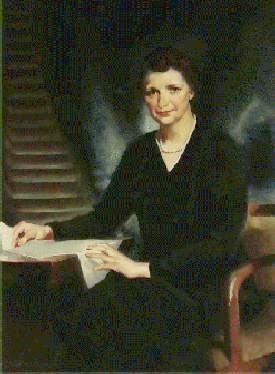
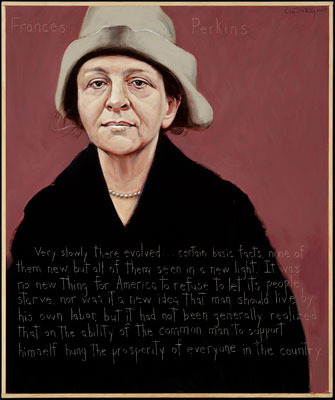
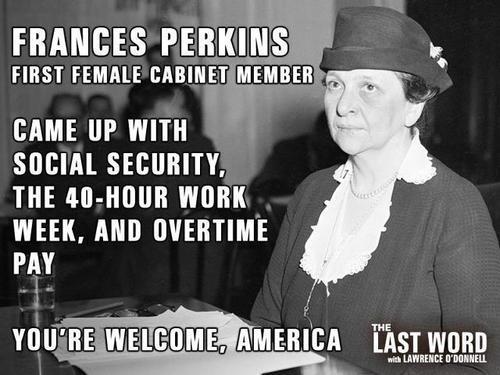
Frances Perkins
Tenure: March 4, 1933 to June 30, 1945
From Massachusetts; graduate of Mount Holyoke College. Trained as a social worker, worked in settlement houses in Chicago (Hull House) and Philadelphia, and was involved in the reform efforts spawned by the tragic Triangle Shirtwaist Co. Fire in New York City.
She was the first woman Industrial Commissioner under New York Governor Franklin Roosevelt; held other important labor related jobs in the New York state government under Governors Roosevelt and Al Smith.
Appointed by Roosevelt; was the first woman Cabinet member.
Led the battle against the Great Depression: the Wagner-Peyser Act revitalized the U.S. Employment Service, the Fair Labor Standards Act set a floor under wages and a ceiling over hours, the Wagner Act protected workers' right to organize.
She established the Labor Standards Bureau. Through effective relationships with the state governments, she strengthened labor law enforcement by the states. She was also the principal architect of the Social Security Act.
Served 12 years, 3 months (longer than any other Secretary).
Went on to serve as a Member of the Civil Service Commission. Department of Labor Headquarters named after her in 1980. Inducted into the Labor Hall of Fame in 1988.
(Source: http://www.dol.gov/oasam/programs/his...)
More:
http://www.britannica.com/EBchecked/t...
http://www.fdrlibrary.marist.edu/abou...
http://en.wikipedia.org/wiki/Frances_...
http://francesperkinscenter.org/
http://www.dol.gov/oasam/programs/his...
http://www.spartacus.schoolnet.co.uk/...
http://www.democracynow.org/2009/3/31...
http://www.gwu.edu/~erpapers/teaching...
http://www.ssa.gov/history/fperkins.html
http://www.americanswhotellthetruth.o...
http://www.biography.com/people/franc...
http://tv.msnbc.com/2013/04/11/the-mo...
http://bestpossiblelife.wordpress.com...
http://tv.msnbc.com/2013/04/11/the-mo...
http://www.ilr.cornell.edu/trianglefi...
http://asteria.fivecolleges.edu/finda...
http://www.apwu.org/join/women/lbport...
http://tv.msnbc.com/2013/04/11/the-mo...
http://tv.msnbc.com/2013/04/11/the-mo...
http://tv.msnbc.com/2013/04/11/the-mo...
http://www.mtholyoke.edu/~dalbino/fdc...
http://ww3.nysif.com/AboutNYSIF/NYSIF...
http://www.columbia.edu/cu/lweb/archi...
http://www.columbia.edu/cu/lweb/digit...
http://www.tumblr.com/tagged/frances%...
http://www.nytimes.com/2009/06/21/nyr...
http://archive.org/details/org.vineya...
http://smithsonianeducation.org/spotl...
 by Kirstin Downey (no photo)
by Kirstin Downey (no photo)
 by
by
 Frances Perkins
Frances Perkins
 by Naomi Pasachoff (no photo)
by Naomi Pasachoff (no photo)
 by Penny Colman (no photo)
by Penny Colman (no photo)
(no image) Madam Secretary, Frances Perkins by George Whitney Martin (no photo)
(no image) Madam Secretary: Frances Perkins by Elisabeth P. Myers (no photo)
(no image) Frances Perkins: That Woman in Fdr's Cabinet by Lillian Holmen Mohr (no photo)



Frances Perkins
Tenure: March 4, 1933 to June 30, 1945
From Massachusetts; graduate of Mount Holyoke College. Trained as a social worker, worked in settlement houses in Chicago (Hull House) and Philadelphia, and was involved in the reform efforts spawned by the tragic Triangle Shirtwaist Co. Fire in New York City.
She was the first woman Industrial Commissioner under New York Governor Franklin Roosevelt; held other important labor related jobs in the New York state government under Governors Roosevelt and Al Smith.
Appointed by Roosevelt; was the first woman Cabinet member.
Led the battle against the Great Depression: the Wagner-Peyser Act revitalized the U.S. Employment Service, the Fair Labor Standards Act set a floor under wages and a ceiling over hours, the Wagner Act protected workers' right to organize.
She established the Labor Standards Bureau. Through effective relationships with the state governments, she strengthened labor law enforcement by the states. She was also the principal architect of the Social Security Act.
Served 12 years, 3 months (longer than any other Secretary).
Went on to serve as a Member of the Civil Service Commission. Department of Labor Headquarters named after her in 1980. Inducted into the Labor Hall of Fame in 1988.
(Source: http://www.dol.gov/oasam/programs/his...)
More:
http://www.britannica.com/EBchecked/t...
http://www.fdrlibrary.marist.edu/abou...
http://en.wikipedia.org/wiki/Frances_...
http://francesperkinscenter.org/
http://www.dol.gov/oasam/programs/his...
http://www.spartacus.schoolnet.co.uk/...
http://www.democracynow.org/2009/3/31...
http://www.gwu.edu/~erpapers/teaching...
http://www.ssa.gov/history/fperkins.html
http://www.americanswhotellthetruth.o...
http://www.biography.com/people/franc...
http://tv.msnbc.com/2013/04/11/the-mo...
http://bestpossiblelife.wordpress.com...
http://tv.msnbc.com/2013/04/11/the-mo...
http://www.ilr.cornell.edu/trianglefi...
http://asteria.fivecolleges.edu/finda...
http://www.apwu.org/join/women/lbport...
http://tv.msnbc.com/2013/04/11/the-mo...
http://tv.msnbc.com/2013/04/11/the-mo...
http://tv.msnbc.com/2013/04/11/the-mo...
http://www.mtholyoke.edu/~dalbino/fdc...
http://ww3.nysif.com/AboutNYSIF/NYSIF...
http://www.columbia.edu/cu/lweb/archi...
http://www.columbia.edu/cu/lweb/digit...
http://www.tumblr.com/tagged/frances%...
http://www.nytimes.com/2009/06/21/nyr...
http://archive.org/details/org.vineya...
http://smithsonianeducation.org/spotl...
 by Kirstin Downey (no photo)
by Kirstin Downey (no photo) by
by
 Frances Perkins
Frances Perkins by Naomi Pasachoff (no photo)
by Naomi Pasachoff (no photo) by Penny Colman (no photo)
by Penny Colman (no photo)(no image) Madam Secretary, Frances Perkins by George Whitney Martin (no photo)
(no image) Madam Secretary: Frances Perkins by Elisabeth P. Myers (no photo)
(no image) Frances Perkins: That Woman in Fdr's Cabinet by Lillian Holmen Mohr (no photo)
 Rainbow 5
Rainbow 5
Less than two weeks after he won an unprecedented third term in office in November 1940, President Roosevelt received a private briefing from the Chief of Naval Operations, Admiral Harold R. Stark. Stark warned Roosevelt that failure by the United States to aid Britain against Germany would almost certainly lead to Britain's defeat and German domination of the whole of Europe, the Middle East and Africa. Stark argued that American aid to Britain should include actual participation in the war in Europe and North Africa by US armed forces. Stark also argued that top priority should be given to defeating Germany regardless of any threat that might arise from Japan.
Admiral Stark's advice that the defeat of Nazi Germany should be the top priority of the United States even in the event of war with Japan was accepted by President Roosevelt, and formally designated as "Plan D". The plan acquired the designation "D" simply because it followed the numbering in Stark's formal memorandum to the President. However, Plan D was effectively an implementation of the American military’s Rainbow -5 strategic war plan. Rainbow -5 stipulated as its premise that the United States was engaged in war against the three Axis powers, Japan, Germany and Italy. This plan specified that American military power would be deployed against Germany and Italy as a priority even if Japan had already entered the war as their ally. Until Germany and Italy were defeated, Rainbow -5 required the United States to adopt a defensive posture in the Pacific behind lines linking Hawaii to Alaska and Panama. The Rainbow -5 war plan clearly involved abandoning everything west of Hawaii to the Japanese, including the Philippines and Australia.
(Source: http://www.pacificwar.org.au/GermanyF...)
More:
http://www.globalsecurity.org/militar...
http://www.ibiblio.org/pha/pha/misc/r...
http://en.wikipedia.org/wiki/United_S...
http://ariwatch.com/Links/RainbowFive...
http://www.history.army.mil/books/wwi...
http://lanceolsen.hubpages.com/hub/WW...
http://www.americanheritage.com/conte...
http://www.strike-the-root.com/72/dav...
http://www.veteranstoday.com/2008/06/...
 by
by
 Thomas J. Fleming
Thomas J. Fleming by
by
 Rick Atkinson
Rick Atkinson by
by
 Charles A. Beard
Charles A. Beard by Waldo Heinrichs (no photo)
by Waldo Heinrichs (no photo) by Edwin T. Layton (no photo)
by Edwin T. Layton (no photo)(no image)The American Experience in World War II by Walter Hixson (no photo)
 Jerome & others:
Jerome & others:I loved the Kristin Downey bio on Frances Perkins - well-written, well-researched, highly recommended! "Nothing to fear" by Adam Cohen also provides a great overview of FDR's inner circle and has a chapter about Perkins.
 by Adam Cohen
by Adam CohenHas anyone read
 by
by James Srodes and if so what do people think about it?
Jerome wrote: "Labor Secretary Francis Perkins
Frances Perkins
Tenure: March 4, 1933 to June 30, 1945
From Massachusetts; graduate of Mount Holyoke College. Trained as a social worker, worked in settlement ..."
message 128:
by
Jerome, Assisting Moderator - Upcoming Books and Releases
(new)
Admiral Sir Dudley Pound
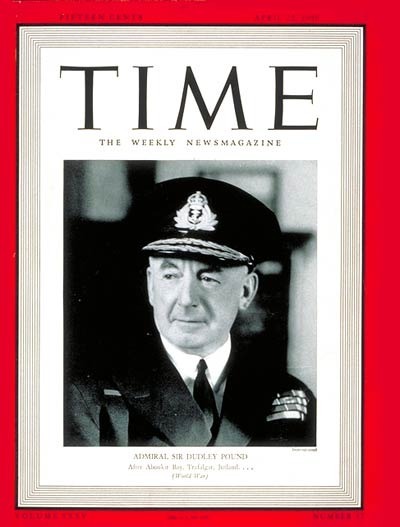 (
(
Sir Dudley Pound was the First Sea Lord, the professional head of the Royal Navy from early in 1939 until just before his death in October 1943. Alfred Dudley Pickman Rogers Pound was born on the Isle of Wight on 29 August 1877. Like Churchill he had a British father (a barrister) and an American mother.
His naval career began in 1891, when at the age of 14 he joined the navy as a cadet. By 1916 he had reached the rank of captain, and at the battle of Jutland served as the flag captain of HMS Colossus. This ship was more involved in the fighting that most of the main battle fleet, sinking two German cruisers during the fighting. After Jutland Pound was moved a new department in the Admiralty devoted to forward planning. This soon became the Plans Division, while in 1922 Pound became head of that department. He was promoted to vice admiral in 1930 and and in 1932 was made Second Sea Lord, in charge of naval personnel.
Pound was probably at his best when serving as Commander-in-Chief of the Mediterranean Fleet. He was first promised this post in January 1935, but the outbreak of the Abyssinian crisis meant that Sir William Fisher, the existing C-in-C, was kept in post. Pound volunteers to serve as Fisher's Chief of Staff during this crisis, before eventually succeeded to the command in 1936. He held this critically important command in the aftermath of the split with Italy and during the Spanish Civil War, and was rewarded for his skillful handling of a difficult situation with a knighthood in 1937.
For most of his career Pound had not been considered as a potential First Sea Lord, but in the years before the outbreak of the Second World War most of the existing candidates were ruled out. Admiral Sir Bertram Ramsey, who would later distinguish himself at Dunkirk, resigned in 1936 after a disagreement with Sir Roger Backhouse. Backhouse himself would serve as First Sea Lord from January-June 1939 before being forced to resign by ill-health. Sir William Fisher, Pound's predecessor in the Mediterranean, died suddenly in 1937. Admiral Sir Geoffrey Blake had to be invalided out in 1936. Admiral of the Fleet Sir Ernle Chatfield, the First Sea Lord at the start of 1939, was appointed Minister for the Coordination of Defence. As a result, when Backhouse resigned Pound was offered the job.
Pound is not considered to have been a particularly successful First Sea Lord. Although he was like and respected for his hard work and attention to detail by many at his own rank, he was not felt to have a very good grasp of wider strategic issues, and he was not always popular with his subordinates. . He was described as having a "slow but good" brain (by his flag captain in the Mediterranean), and reached the top post through hard work and the absence of rival candidates. His health was also poor in 1939. He suffered from a hip injury which made it difficult to sleep, and is said to have fallen asleep in meetings. He also had a brain tumour, discovered by the Fleet Medical Officer, but not reported to the Admiralty. Pound was also prone to interfere in matters of detail in remote commands, taking advantage of the Admiralty's status as an active operational headquarters, sometimes with disastrous results (perhaps the best known of these was the order that saw convoy PQ-17 scatter in the face of a perceived threat from the German surface fleet, exposing the merchant ships to destruction at the hands of the U-boats).
Pound's most important contribution to the fighting during his time as First Sea Lord was his focus on the U-boat war. Pound quickly realised that every other aspect of the British war effort, and later the Anglo-American war effort in Europe, relied on the defeat of the U-boats. This was also an area where his attention to detail was of great value. Pound was also able to handle Churchill with some success, managed to convince the PM to abandon some of his wilder schemes, without losing Churchill's complete confidence.
As First Sea Lord Pound was a member of the Chief of Staff Committee until replaced by General Alan Brooke in March 1942. He also accompanied Churchill on a number of his trans-Atlantic voyages, taking part in meetings of the Joint Chiefs of Staff. It was on one of these journeys, to the Quadrant summit at Quebec, that ill health forced Pound to resign from his post. On 10 September 1943 Pound informed Churchill that he had suffered a stroke which had left his right side "largely paralysed". Pound returned to Britain on HMS Renown. Soon after his return he suffered from a second stroke. He died on 21 October (Trafalgar Day) 1943. Pound was replaced as First Sea Lord by Admiral Andrew Cunningham.
(Source: http://www.historyofwar.org/articles/...)
More:
http://en.wikipedia.org/wiki/Dudley_P...
http://www.winstonisback.com/WinstonI...
http://ww2db.com/person_bio.php?perso...
http://www.warhistory.ie/world-war-2/...
http://www.admirals.org.uk/admirals/f...
http://www.dreadnoughtproject.org/tfs...
http://duringthewar.weebly.com/dudley...
http://desertwar.net/dudley-pound.html
http://www.britishpathe.com/video/win...
 by Robin Brodhurst (no photo)
by Robin Brodhurst (no photo)
 by
by
 Christopher M. Bell
Christopher M. Bell
 by T. A. Heathcote (no photo)
by T. A. Heathcote (no photo)
 by
by
 Ludovic Kennedy
Ludovic Kennedy
 by Stanley Martin (no photo)
by Stanley Martin (no photo)
 by Malcolm H. Murfett (no photo)
by Malcolm H. Murfett (no photo)
 by
by
 Richard Holmes
Richard Holmes
 by Nathan Miller (no photo)
by Nathan Miller (no photo)
 (
(Sir Dudley Pound was the First Sea Lord, the professional head of the Royal Navy from early in 1939 until just before his death in October 1943. Alfred Dudley Pickman Rogers Pound was born on the Isle of Wight on 29 August 1877. Like Churchill he had a British father (a barrister) and an American mother.
His naval career began in 1891, when at the age of 14 he joined the navy as a cadet. By 1916 he had reached the rank of captain, and at the battle of Jutland served as the flag captain of HMS Colossus. This ship was more involved in the fighting that most of the main battle fleet, sinking two German cruisers during the fighting. After Jutland Pound was moved a new department in the Admiralty devoted to forward planning. This soon became the Plans Division, while in 1922 Pound became head of that department. He was promoted to vice admiral in 1930 and and in 1932 was made Second Sea Lord, in charge of naval personnel.
Pound was probably at his best when serving as Commander-in-Chief of the Mediterranean Fleet. He was first promised this post in January 1935, but the outbreak of the Abyssinian crisis meant that Sir William Fisher, the existing C-in-C, was kept in post. Pound volunteers to serve as Fisher's Chief of Staff during this crisis, before eventually succeeded to the command in 1936. He held this critically important command in the aftermath of the split with Italy and during the Spanish Civil War, and was rewarded for his skillful handling of a difficult situation with a knighthood in 1937.
For most of his career Pound had not been considered as a potential First Sea Lord, but in the years before the outbreak of the Second World War most of the existing candidates were ruled out. Admiral Sir Bertram Ramsey, who would later distinguish himself at Dunkirk, resigned in 1936 after a disagreement with Sir Roger Backhouse. Backhouse himself would serve as First Sea Lord from January-June 1939 before being forced to resign by ill-health. Sir William Fisher, Pound's predecessor in the Mediterranean, died suddenly in 1937. Admiral Sir Geoffrey Blake had to be invalided out in 1936. Admiral of the Fleet Sir Ernle Chatfield, the First Sea Lord at the start of 1939, was appointed Minister for the Coordination of Defence. As a result, when Backhouse resigned Pound was offered the job.
Pound is not considered to have been a particularly successful First Sea Lord. Although he was like and respected for his hard work and attention to detail by many at his own rank, he was not felt to have a very good grasp of wider strategic issues, and he was not always popular with his subordinates. . He was described as having a "slow but good" brain (by his flag captain in the Mediterranean), and reached the top post through hard work and the absence of rival candidates. His health was also poor in 1939. He suffered from a hip injury which made it difficult to sleep, and is said to have fallen asleep in meetings. He also had a brain tumour, discovered by the Fleet Medical Officer, but not reported to the Admiralty. Pound was also prone to interfere in matters of detail in remote commands, taking advantage of the Admiralty's status as an active operational headquarters, sometimes with disastrous results (perhaps the best known of these was the order that saw convoy PQ-17 scatter in the face of a perceived threat from the German surface fleet, exposing the merchant ships to destruction at the hands of the U-boats).
Pound's most important contribution to the fighting during his time as First Sea Lord was his focus on the U-boat war. Pound quickly realised that every other aspect of the British war effort, and later the Anglo-American war effort in Europe, relied on the defeat of the U-boats. This was also an area where his attention to detail was of great value. Pound was also able to handle Churchill with some success, managed to convince the PM to abandon some of his wilder schemes, without losing Churchill's complete confidence.
As First Sea Lord Pound was a member of the Chief of Staff Committee until replaced by General Alan Brooke in March 1942. He also accompanied Churchill on a number of his trans-Atlantic voyages, taking part in meetings of the Joint Chiefs of Staff. It was on one of these journeys, to the Quadrant summit at Quebec, that ill health forced Pound to resign from his post. On 10 September 1943 Pound informed Churchill that he had suffered a stroke which had left his right side "largely paralysed". Pound returned to Britain on HMS Renown. Soon after his return he suffered from a second stroke. He died on 21 October (Trafalgar Day) 1943. Pound was replaced as First Sea Lord by Admiral Andrew Cunningham.
(Source: http://www.historyofwar.org/articles/...)
More:
http://en.wikipedia.org/wiki/Dudley_P...
http://www.winstonisback.com/WinstonI...
http://ww2db.com/person_bio.php?perso...
http://www.warhistory.ie/world-war-2/...
http://www.admirals.org.uk/admirals/f...
http://www.dreadnoughtproject.org/tfs...
http://duringthewar.weebly.com/dudley...
http://desertwar.net/dudley-pound.html
http://www.britishpathe.com/video/win...
 by Robin Brodhurst (no photo)
by Robin Brodhurst (no photo) by
by
 Christopher M. Bell
Christopher M. Bell by T. A. Heathcote (no photo)
by T. A. Heathcote (no photo) by
by
 Ludovic Kennedy
Ludovic Kennedy by Stanley Martin (no photo)
by Stanley Martin (no photo) by Malcolm H. Murfett (no photo)
by Malcolm H. Murfett (no photo) by
by
 Richard Holmes
Richard Holmes by Nathan Miller (no photo)
by Nathan Miller (no photo)
Alisa - actually please instruct Aurelie to do a copy and paste of her post and move it to the bibliography thread where it should be.
Aurelie - this is the bibliography thread where lists of books should go related to folks in this book:
http://www.goodreads.com/topic/show/1...
Aurelie - this is the bibliography thread where lists of books should go related to folks in this book:
http://www.goodreads.com/topic/show/1...
 Thank you, Bentley. Aurelie, your post would make a great addition to the discussion bibliography. Thanks again. http://www.goodreads.com/topic/show/1...
Thank you, Bentley. Aurelie, your post would make a great addition to the discussion bibliography. Thanks again. http://www.goodreads.com/topic/show/1...
 John Steinbeck
John Steinbeck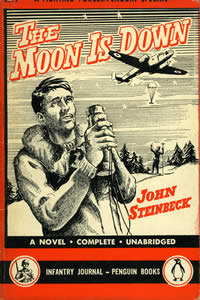
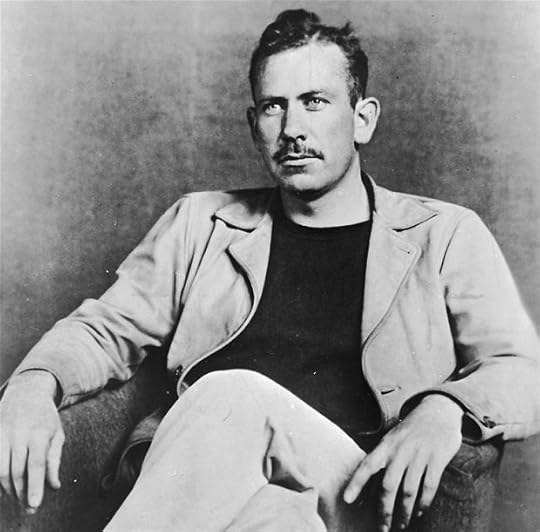
Born in Salinas, California on February 27, 1902, John Steinbeck remains the quintessential California writer. Beginning in the 1930s, he forged a significant place in the culture and letters of the United States as a writer deeply engaged with place, with marginalized workers and ordinary people, and with the political and social human dramas that confronted him. More than any other writer of the United States in the 1900s, he remained engaged in the struggles of his country. He wrote social histories in the 1930s; deeply ecological works in the 1940s; early accounts of the Cold War when covering the Soviet Union in 1947; cultural studies of Mexico and Mexicans from the mid-1930s to the mid-1950s; and in the 1960s increasingly concerned essays about the people of the United States, including accounts of the U.S. war in Vietnam. John Steinbeck, winner of the 1962 Nobel Prize, wrote as the conscience of his country for nearly 40 years. He died 20 December 1968 in his New York City apartment.
(Source: http://as.sjsu.edu/steinbeck/biograph...)
More:
http://en.wikipedia.org/wiki/John_Ste...
http://www.lawrencemalkin.com/krueger...
http://cwcs.ysu.edu/resources/literat...
http://www.famousauthors.org/john-ste...
http://www.oprah.com/oprahsbookclub/J...
http://www.nobelprize.org/nobel_prize...






 by
by
 John Steinbeck
John Steinbeck
 by Donald V. Coers (no photo)
by Donald V. Coers (no photo) by
by
 Jay Parini
Jay Parini by Jackson J. Benson (no photo)
by Jackson J. Benson (no photo)(no image) John Steinbeck: The War Years, 1939-1945 by Roy S. Simmonds (no photo)
 James Roosevelt
James Roosevelt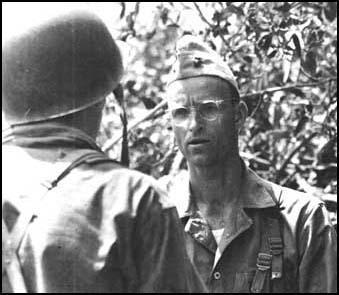
James Roosevelt, the son of Franklin D. Roosevelt and Eleanor Roosevelt, and brother of Franklin Roosevelt Jr., was born in New York City on 23rd December, 1907. After graduating from Harvard University in 1930 he became an insurance broker in Boston. He eventually became president of Roosevelt & Sargent Incorporated.
Roosevelt joined the United States Marines in November 1940. After Japan attacked at Pearl Harbor two leading marines, Evans Carlson and Merritt Edson advocated the use of guerrilla warfare against the Japanese Army in the Pacific War. Eventually Edson was given command of the 1st Raider Battalion whereas Carlson got the 2nd Raider Battalion. Roosevelt became Carlson's assistant. Based in San Diego, the Carlson's Raiders were taught the military tactics employed by the Red Army against the Japanese. This included learning how to kill silently and quickly. Following the example of the guerrillas in China, Carlson abolished the traditional privileges enjoyed by officers. They ate the same food, wore the same clothes and carried the same equipment.
In August 1943 the 2nd Raider Battalion landed on the small island of Makin Atoll. After two days of fighting Carlson's men were able to destroy the radio station, burned equipment and captured important documents. Thirty marines were killed before General Alexander Vandegrift ordered them to leave the island. As a result of the raid the Japanese Army fortified the Gilbert Islands. On 4th November 1943, the Carlson's Raiders landed in Guadalcana. Over the next month Carlson's men killed more than 500 Japanese while only losing 17 men.
By the end of the war Roosevelt had reached the rank of brigadier general. After leaving the army [Marine Corps] he became chairman of Roosevelt & Haines. A member of the Democratic Party he was an unsuccessful candidate for Governor of California in 1950.
Roosevelt was elected to the House of Representatives and served between 3rd January, 1955 and 30th September 1965. A strong opponent of McCarthyism Roosevelt was one of the first politicians to attack the tactics of Joseph McCarthy. He was also the only member of the House of Representatives to voted against giving the House of Un-American Activities money.
He resigned from Congress to become the United States representative to United Nations Economic and Social Council.
James Roosevelt died in California on 13th August 1991.
(Source: http://www.spartacus.schoolnet.co.uk/...)
More:
http://www.nytimes.com/1991/08/14/us/...
http://en.wikipedia.org/wiki/James_Ro...
http://www.marinecorpsmuseum.org/toho...
https://en.wikipedia.org/wiki/Marine_...
http://www.nps.gov/history/history/on...
http://projects.militarytimes.com/cit...
http://www.usna.edu/Library/sca/findi...
http://www.fdrlibrary.marist.edu/arch...
http://articles.latimes.com/1991-08-1...
http://articles.baltimoresun.com/1991...
http://millercenter.org/president/fdr...
http://www.whitehousehistory.org/whha...
 by
by
 Jean Edward Smith
Jean Edward Smith by Peter Collier (no photo)
by Peter Collier (no photo) by Blanche Wiesen Cook (no photo)
by Blanche Wiesen Cook (no photo) by Joseph Alsop (no photo)
by Joseph Alsop (no photo) by Roger Butterfield (no photo)
by Roger Butterfield (no photo) by Anthony Badger (no photo)
by Anthony Badger (no photo) by James Roosevelt (no photo)
by James Roosevelt (no photo)(no image)My Parents: A Differing View by James Roosevelt (no photo)
(no image)A Family Matter by James Roosevelt (no photo)
 Risto Heikki Ryti
Risto Heikki Ryti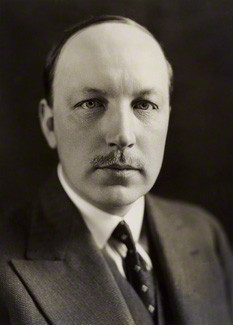
Risto Heikki Ryti (1889-1956) was the President of Finland from 1940 to 1944.
Ryti was born in Huittinen as one of seven sons. He was educated briefly at Pori Grammar School, and was then tutored at home, before enrolling at the University of Helsinki in 1906 to study law. After graduating in 1909, Ryti returned to his roots in Satakunta, where he established himself as a lawyer in Rauma. During this period Ryti also undertook further studies, becoming a Master of Laws. In 1914 he moved to Oxford to study maritime law, but the outbreak of World War I forced him to return to Finland. After civil war he was elected as a member of Parliament, from 1919 to 1923 and from 1927 to 1929. During his first few years in Parliament, Ryti served as chairman of the judiciary committee. In 1921 he was appointed as Finance Minister. President Ståhlberg appointed him as Chairman of the Bank of Finland, a post he remained in until he became Prime Minister in 1939 in the beginning of the Winter War. He persuaded the rest of the Cabinet to settle for peace and was one to sign the Moscow Peace Treaty in 1940. The peace, in which Finland lost large land areas was generally considered crushing. In the following precarious times Ryti bore the heavy responsibilities of state leadership as President Kyösti Kallio was struck by illness. Ryti was selected as successor to the retired Kallio just some weeks before the latter suffered a lethal stroke on December 19, 1940.
In August 1940 Ryti agreed to secret military cooperation with Germany, in order to strengthen Finland's position vis-à-vis the threatening Soviet Union. When Germany's assault on the Soviet Union begun in June 1941, Finland remained formally neutral until Soviet air raids gave an expected reason to fulfill the invasion plans some days later. Finnish troops soon regained the territory lost in the Winter War and a substantial buffer zone beyond. The Soviet Union's major offensive begun in June 1944, in a situation when Finland's relations to Germany were strained due to earlier attempts to secure a separate peace. Finland was in dire need of food, weapons and ammunition, as the Nazi Foreign Minister demanded guarantees that Finland would not again seek a separate peace. Ryti gave this guarantee, expressed as his personal guarantee that Finland under his presidency would not. Soon after the situation was stabilized, Ryti resigned and peace negotiations could begin again, this time from a stronger position although most territorial gains had been lost again.
After the war Ryti attempted to return to the Bank of Finland. However, in 1945 Finnish communists and the Soviet Union demanded he should be tried as "responsible for the war". After considerable pressure Ryti was sentenced to 10 years' imprisonment. President Paasikivi pardoned him in 1949. He died in 1956 and was buried with full honors.
(Source:http://www.stampslandia.net84.net/gal...)
More:
http://www15.uta.fi/FAST/FIN/HIST/sm-...
http://www.kansallisbiografia.fi/engl...
http://en.wikipedia.org/wiki/Risto_Ryti
http://ww2db.com/person_bio.php?perso...
http://www.tpk.fi/public/default.aspx...
http://www.reference.com/browse/risto...
http://finugor.ru/en/leaders/candidat...
http://desertwar.net/risto-ryti.html
 by Martti Turtola (no photo)
by Martti Turtola (no photo) byLester J. Bartson (no photo)
byLester J. Bartson (no photo) by Frank Joseph (no photo)
by Frank Joseph (no photo) by Henrik O. Lunde (no photo)
by Henrik O. Lunde (no photo)(no image)Finland in World War II by Tiina Kinnunen (no photo)
message 134:
by
Jerome, Assisting Moderator - Upcoming Books and Releases
(last edited Oct 20, 2014 03:53PM)
(new)
Ribbentrop-Molotov Peace Pact
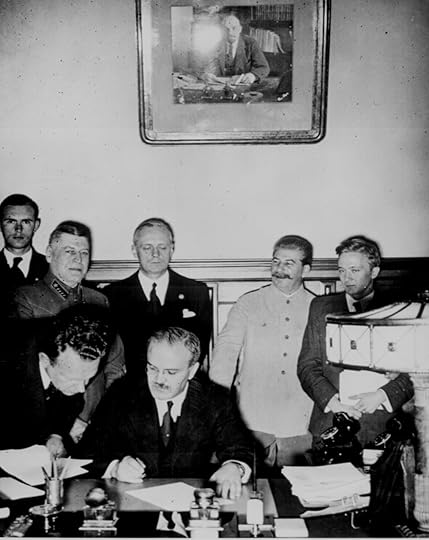
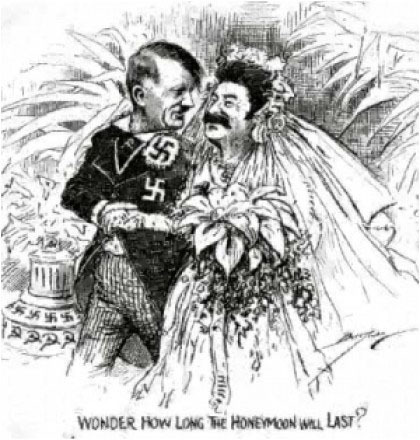
In the 1930s Joseph Stalin became increasingly concerned that the Soviet Union would be invaded by Germany. Stalin believed the best way to of dealing with Germany was to form an anti-fascist alliance with countries in the west. Stalin argued that even Adolf Hitler would not start a war against a united Europe.
Neville Chamberlain, the British prime minister, was not enthusiastic about forming an alliance with the Soviet Union. He wrote to a friend: "I must confess to the most profound distrust of Russia. I have no belief whatever in her ability to maintain an effective offensive, even if she wanted to. And I distrust her motives, which seem to me to have little connection with our ideas of liberty, and to be concerned only with getting everyone else by the ears."
Winston Churchill, an outspoken critic of British foreign policy, agreed with Joseph Stalin: "There is no means of maintaining an eastern front against Nazi aggression without the active aid of Russia. Russian interests are deeply concerned in preventing Herr Hitler's designs on eastern Europe. It should still be possible to range all the States and peoples from the Baltic to the Black sea in one solid front against a new outrage of invasion. Such a front, if established in good heart, and with resolute and efficient military arrangements, combined with the strength of the Western Powers, may yet confront Hitler, Goering, Himmler, Ribbentrop, Goebbels and co. with forces the German people would be reluctant to challenge."
Stalin's own interpretation of Britain's rejection of his plan for an antifascist alliance, was that they were involved in a plot with Germany against the Soviet Union. This belief was reinforced when Neville Chamberlain met with Adolf Hitler at Munich in September, 1938, and gave into his demands for the Sudetenland in Czechoslovakia. Joseph Stalin now believed that the main objective of British foreign policy was to encourage Germany to head east rather than west.
Joseph Stalin realized that war with Germany was inevitable. However, to have any chance of victory he needed time to build up his armed forces. The only way he could obtain time was to do a deal with Hitler. Stalin was convinced that Hitler would not be foolish enough to fight a war on two fronts. If he could persuade Hitler to sign a peace treaty with the Soviet Union, Germany was likely to invade Western Europe instead.
On 3rd May, 1939, Stalin dismissed Maxim Litvinov, his Jewish Commissar for Foreign Affairs. Litvinov had been closely associated with the Soviet Union's policy of an antifascist alliance. Meetings soon took place betweenVyacheslav Molotov, Litvinov's replacement and Joachim von Ribbentrop, the German foreign minister. On 28th August, 1939, the Nazi-Soviet Pact was signed in Moscow. Under the terms of the agreement, both countries promised to remain neutral if either country became involved in a war.
As Raymond Gram Swing later recalled: "The British were busy all through early 1939 trying to negotiate an agreement with the Soviet Union. Even up to the stunning surprise of the Von Ribbentrop-Molotov pact, a success in the British negotiations was awaited. The Poles were against it; they wanted no truck with Moscow. But I thought the British-Soviet negotiations would succeed in spite of the Poles, and said so. Now that this is all in the past, one sees that Stalin signed the pact with Hitler for two reasons, one being to partition a hostile Poland and annex a part of it, the other being to buy time to prepare for an attack Hitler might launch against the Soviet Union."
In March, 1940, Walter Duranty wrote in Atlantic Monthly that although the Soviet Union and Nazi Germany were "to all intents and purposes allies" the natural animosity between the two countries, and indeed their rival systems of government, dictated that such an alliance could not last. It was, he wrote, an alliance built upon "a temporary community of interests and a joint dislike of others, which is surely a slender foundation on which to build a permanent edifice."
(Source: http://www.spartacus.schoolnet.co.uk/...)
More:
http://history1900s.about.com/od/worl...
http://en.wikipedia.org/wiki/Molotov%...
http://russiasperiphery.blogs.wm.edu/...
http://www.johndclare.net/RoadtoWWII8...
http://www.spartacus.schoolnet.co.uk/...
http://www.ushmm.org/wlc/en/article.p...
http://www.historyplace.com/worldwar2...
http://www.fordham.edu/halsall/mod/19...
http://www.bbc.co.uk/schools/gcsebite...
http://www.guardian.co.uk/commentisfr...
http://forward.com/articles/141553/on...
http://www.karinthy.hu/pages/netday/t...
http://www.guardian.co.uk/world/2009/...
 by Anthony Read (no photo)
by Anthony Read (no photo)
 by
by
 Timothy Snyder
Timothy Snyder
 by Izidors Vizulis (no photo)
by Izidors Vizulis (no photo)
 by
by
 Richard M. Watt
Richard M. Watt
 by Bernd Wegner (no photo)
by Bernd Wegner (no photo)
(no image) America and the Nazi-Soviet Pact by Francis A., Ierace (no photo)
(no image) Partners In Tyranny: The Nazi Soviet Nonagression Pact, August 23, 1939 by John Kolasky (no photo)
 by
by
 Roger Moorhouse
Roger Moorhouse


In the 1930s Joseph Stalin became increasingly concerned that the Soviet Union would be invaded by Germany. Stalin believed the best way to of dealing with Germany was to form an anti-fascist alliance with countries in the west. Stalin argued that even Adolf Hitler would not start a war against a united Europe.
Neville Chamberlain, the British prime minister, was not enthusiastic about forming an alliance with the Soviet Union. He wrote to a friend: "I must confess to the most profound distrust of Russia. I have no belief whatever in her ability to maintain an effective offensive, even if she wanted to. And I distrust her motives, which seem to me to have little connection with our ideas of liberty, and to be concerned only with getting everyone else by the ears."
Winston Churchill, an outspoken critic of British foreign policy, agreed with Joseph Stalin: "There is no means of maintaining an eastern front against Nazi aggression without the active aid of Russia. Russian interests are deeply concerned in preventing Herr Hitler's designs on eastern Europe. It should still be possible to range all the States and peoples from the Baltic to the Black sea in one solid front against a new outrage of invasion. Such a front, if established in good heart, and with resolute and efficient military arrangements, combined with the strength of the Western Powers, may yet confront Hitler, Goering, Himmler, Ribbentrop, Goebbels and co. with forces the German people would be reluctant to challenge."
Stalin's own interpretation of Britain's rejection of his plan for an antifascist alliance, was that they were involved in a plot with Germany against the Soviet Union. This belief was reinforced when Neville Chamberlain met with Adolf Hitler at Munich in September, 1938, and gave into his demands for the Sudetenland in Czechoslovakia. Joseph Stalin now believed that the main objective of British foreign policy was to encourage Germany to head east rather than west.
Joseph Stalin realized that war with Germany was inevitable. However, to have any chance of victory he needed time to build up his armed forces. The only way he could obtain time was to do a deal with Hitler. Stalin was convinced that Hitler would not be foolish enough to fight a war on two fronts. If he could persuade Hitler to sign a peace treaty with the Soviet Union, Germany was likely to invade Western Europe instead.
On 3rd May, 1939, Stalin dismissed Maxim Litvinov, his Jewish Commissar for Foreign Affairs. Litvinov had been closely associated with the Soviet Union's policy of an antifascist alliance. Meetings soon took place betweenVyacheslav Molotov, Litvinov's replacement and Joachim von Ribbentrop, the German foreign minister. On 28th August, 1939, the Nazi-Soviet Pact was signed in Moscow. Under the terms of the agreement, both countries promised to remain neutral if either country became involved in a war.
As Raymond Gram Swing later recalled: "The British were busy all through early 1939 trying to negotiate an agreement with the Soviet Union. Even up to the stunning surprise of the Von Ribbentrop-Molotov pact, a success in the British negotiations was awaited. The Poles were against it; they wanted no truck with Moscow. But I thought the British-Soviet negotiations would succeed in spite of the Poles, and said so. Now that this is all in the past, one sees that Stalin signed the pact with Hitler for two reasons, one being to partition a hostile Poland and annex a part of it, the other being to buy time to prepare for an attack Hitler might launch against the Soviet Union."
In March, 1940, Walter Duranty wrote in Atlantic Monthly that although the Soviet Union and Nazi Germany were "to all intents and purposes allies" the natural animosity between the two countries, and indeed their rival systems of government, dictated that such an alliance could not last. It was, he wrote, an alliance built upon "a temporary community of interests and a joint dislike of others, which is surely a slender foundation on which to build a permanent edifice."
(Source: http://www.spartacus.schoolnet.co.uk/...)
More:
http://history1900s.about.com/od/worl...
http://en.wikipedia.org/wiki/Molotov%...
http://russiasperiphery.blogs.wm.edu/...
http://www.johndclare.net/RoadtoWWII8...
http://www.spartacus.schoolnet.co.uk/...
http://www.ushmm.org/wlc/en/article.p...
http://www.historyplace.com/worldwar2...
http://www.fordham.edu/halsall/mod/19...
http://www.bbc.co.uk/schools/gcsebite...
http://www.guardian.co.uk/commentisfr...
http://forward.com/articles/141553/on...
http://www.karinthy.hu/pages/netday/t...
http://www.guardian.co.uk/world/2009/...
 by Anthony Read (no photo)
by Anthony Read (no photo) by
by
 Timothy Snyder
Timothy Snyder  by Izidors Vizulis (no photo)
by Izidors Vizulis (no photo) by
by
 Richard M. Watt
Richard M. Watt by Bernd Wegner (no photo)
by Bernd Wegner (no photo)(no image) America and the Nazi-Soviet Pact by Francis A., Ierace (no photo)
(no image) Partners In Tyranny: The Nazi Soviet Nonagression Pact, August 23, 1939 by John Kolasky (no photo)
 by
by
 Roger Moorhouse
Roger Moorhouse
 Hans Thomsen
Hans Thomsen
Thomsen at center
Hans Thomsen (1891 in Hamburg - 1968) was a German diplomat for the Third Reich. He served as Chargé d'Affaires at the Embassy of Germany in Washington, representing the German government from November 1938 (after the recall of ambassador Hans-Heinrich Dieckhoff) to December 11, 1941 (termination of relations after declaration of war). In 1943 he replaced Victor zu Wied (the brother of William, Prince of Albania) at the German delegation in Stockholm, Sweden, remaining there to the end of the war. Thomsen was interrogated prior to the Nuremberg tribunals but was not charged with any crime. In the early 1950s he served as head of the Hamburg chapter of the Red Cross.
Thomsen and the isolationists
Like Dieckhoff, Thomsen suffered no illusions about the U.S. administration's policy towards Nazi Germany, and he sent warnings to the German government advising them of President Roosevelt's hostility. Therefore, he was involved in several attempts to drum up American isolationist opinion, including efforts to get American authors to write in opposition to American involvement in the War. Thomsen also orchestrated a campaign to influence the 1940 Republican National Convention to pass an anti-war platform. Thomsen reported to the German foreign ministry on June 12, 1940 that a "well-known Republican congressman" had offered to take a group of fifty isolationists to the convention in exchange for $3000. Thomsen asked for funds for this and for full page advertisements to be placed in newspapers during the convention. These ads were written by George Viereck, a German agent on the staff of Congressman Hamilton Fish, and appear to have been influential: the wording of the foreign policy plank, reported Thomsen, "was taken almost verbatim" from an ad which appeared in the New York Times and other papers. Fish does not appear to have been personally involved in these efforts, though he headed the National Committee to Keep America Out of Foreign Wars which sponsored the ads.
The Purple cipher
Thomsen warned his government, in April 1941, that the Japanese diplomatic code (code-named Purple by the Americans) had been broken by the Americans, having been tipped off by the Soviet ambassador to the US, Konstantin Umansky. These warnings were passed on to the Japanese government, but in the end they were not acted upon, and American cryptographers continued to read Japanese messages through the war.
Thomsen and Donovan
Just before the Pearl Harbor attack, Thomsen was involved in a curious attempt by William Donovan, the United States Coordinator of Information, to recruit him entirely to the American side. Thomsen had been supplying information on German military strength and movements to Malcolm Lovell, a real estate developer involved in Quaker anti-war efforts. Lovell understood himself to be an intermediary and passed the information on to Donovan. These messages included various warnings about Japanese actions and their consequences, including warnings that the Japanese Empire was compelled by its position to attack the United States; on November 13, 1940, he also passed through a message that Germany would join with Japan if the latter were to declare war on the United States. Donovan and Roosevelt were not entirely sure what to make of this information; nonetheless, just before the attack, Donovan offered Thomsen a million dollars in exchange for a public statement distancing himself from the Nazi regime. Donovan's efforts failed, and Thomsen returned to Germany at the end of the year as America entered the war.
(Source: http://en.wikipedia.org/wiki/Hans_Tho...)
More:
http://turtledove.wikia.com/wiki/Hans...
http://histclo.com/essay/war/ww2/cou/...
http://udspace.udel.edu/handle/19716/...
http://avalon.law.yale.edu/wwii/gerde...
http://docs.fdrlibrary.marist.edu/psf...
 by
by
 Max Wallace
Max Wallace by David Kahn (no photo)
by David Kahn (no photo) by Manfred Jonas (no photo)
by Manfred Jonas (no photo) by Christof Mauch (no photo)
by Christof Mauch (no photo) by Charles Peters (no photo)
by Charles Peters (no photo)
message 136:
by
Jerome, Assisting Moderator - Upcoming Books and Releases
(new)
Admiral Erich Raeder

Erich Johann Albert Raeder was born into a middle-class family in Wandsbek, Hamburg, Germany. He joined the Imperial German Navy in 1894. By 1912 he was already the Chief of Staff for Franz von Hipper. During WW1, he participated in the Battle of Dogger Bank in 1915 and the Battle of Jutland in 1916. He joined the admiral rank in 1922 with a promotion to rear admiral. He was promoted vice admiral in 1925 and full admiral in 1928. Although he disliked the Nazi philosophy, he supported Adolf Hitler's rise for the opportunity to strengthen the navy. On 20 Apr 1936, Hitler presented him with the rank of general admiral; he was later awarded the rank of grand admiral in 1939.
When the military phase of WW2 broke out in Europe, Raeder was instrumental in Germany's interest in Denmark and Norway, which gained the Kriegsmarine valuable ports on the long Norwegian coast. Understanding that his navy cannot compete with its British counterparts, he voiced against a German invasion of Britain, but the planning for Operation Sealion continued nevertheless. That plan was later postponed indefinitely after Göring's inability to win the Battle of Britain. Raeder also voiced his recommendation against an invasion of Russia, but as the Russian invasion largely involved land forces, he had even less influence on the decision making process. During 1943, his career became overshadowed by the recent successes of Admiral Karl Dönitz. Raeder finally resigned from his position in May 1943; Dönitz had already taken over Raeder's command position in Jan 1943.
After the war Raeder was sentenced to life imprisonment at the Nuremberg Trials for waging a war of aggression. The sentence was later reduced, and then he was released early on 26 Sep 1955 for health reasons. He wrote an autobiography in 1957 and passed away in Kiel in 1960.
(Source: http://ww2db.com/person_bio.php?perso...)
More:
http://en.wikipedia.org/wiki/Erich_Ra...
http://ldfb.tripod.com/r01.html
http://www.answers.com/topic/erich-ra...
http://www.spartacus.schoolnet.co.uk/...
http://www.jewishvirtuallibrary.org/j...
http://www.trial-ch.org/en/ressources...
http://www.excatholicsforchrist.com/a...
http://www.history.com/this-day-in-hi...
http://www.ushmm.org/wlc/en/article.p...
http://www.princeton.edu/~achaney/tmv...
http://www.germandaggers.info/raeder.htm
http://www.britannica.com/EBchecked/t...
http://en.metapedia.org/wiki/Erich_Ra...
http://www.reference.com/browse/erich...
 by Keith W. Bird (no photo)
by Keith W. Bird (no photo)
 by Erich Raeder (no photo)
by Erich Raeder (no photo)
 by Vincent P. O'Hara (no photo)
by Vincent P. O'Hara (no photo)
 by James P Duffy (no photo)
by James P Duffy (no photo)
 by Tobias R., III Philbin (no photo)
by Tobias R., III Philbin (no photo)
 by Samuel W. Mitcham Jr. (no photo)
by Samuel W. Mitcham Jr. (no photo)

Erich Johann Albert Raeder was born into a middle-class family in Wandsbek, Hamburg, Germany. He joined the Imperial German Navy in 1894. By 1912 he was already the Chief of Staff for Franz von Hipper. During WW1, he participated in the Battle of Dogger Bank in 1915 and the Battle of Jutland in 1916. He joined the admiral rank in 1922 with a promotion to rear admiral. He was promoted vice admiral in 1925 and full admiral in 1928. Although he disliked the Nazi philosophy, he supported Adolf Hitler's rise for the opportunity to strengthen the navy. On 20 Apr 1936, Hitler presented him with the rank of general admiral; he was later awarded the rank of grand admiral in 1939.
When the military phase of WW2 broke out in Europe, Raeder was instrumental in Germany's interest in Denmark and Norway, which gained the Kriegsmarine valuable ports on the long Norwegian coast. Understanding that his navy cannot compete with its British counterparts, he voiced against a German invasion of Britain, but the planning for Operation Sealion continued nevertheless. That plan was later postponed indefinitely after Göring's inability to win the Battle of Britain. Raeder also voiced his recommendation against an invasion of Russia, but as the Russian invasion largely involved land forces, he had even less influence on the decision making process. During 1943, his career became overshadowed by the recent successes of Admiral Karl Dönitz. Raeder finally resigned from his position in May 1943; Dönitz had already taken over Raeder's command position in Jan 1943.
After the war Raeder was sentenced to life imprisonment at the Nuremberg Trials for waging a war of aggression. The sentence was later reduced, and then he was released early on 26 Sep 1955 for health reasons. He wrote an autobiography in 1957 and passed away in Kiel in 1960.
(Source: http://ww2db.com/person_bio.php?perso...)
More:
http://en.wikipedia.org/wiki/Erich_Ra...
http://ldfb.tripod.com/r01.html
http://www.answers.com/topic/erich-ra...
http://www.spartacus.schoolnet.co.uk/...
http://www.jewishvirtuallibrary.org/j...
http://www.trial-ch.org/en/ressources...
http://www.excatholicsforchrist.com/a...
http://www.history.com/this-day-in-hi...
http://www.ushmm.org/wlc/en/article.p...
http://www.princeton.edu/~achaney/tmv...
http://www.germandaggers.info/raeder.htm
http://www.britannica.com/EBchecked/t...
http://en.metapedia.org/wiki/Erich_Ra...
http://www.reference.com/browse/erich...
 by Keith W. Bird (no photo)
by Keith W. Bird (no photo) by Erich Raeder (no photo)
by Erich Raeder (no photo) by Vincent P. O'Hara (no photo)
by Vincent P. O'Hara (no photo) by James P Duffy (no photo)
by James P Duffy (no photo) by Tobias R., III Philbin (no photo)
by Tobias R., III Philbin (no photo) by Samuel W. Mitcham Jr. (no photo)
by Samuel W. Mitcham Jr. (no photo)
message 137:
by
Jerome, Assisting Moderator - Upcoming Books and Releases
(new)
Air Marshal Sir Charles Portal
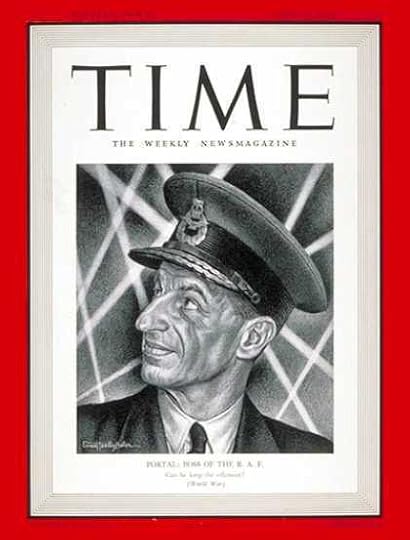
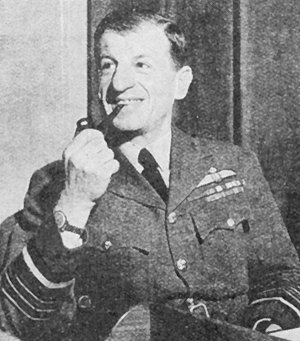
Portal was born in Hungerford on May 21st 1893. He went to Christ's College, Oxford, and when World War One broke out he joined the British Army. Portal joined the Royal Engineers and by the end of 1914, he was given the command of the motorbike riders in the 1st Corps Headquarters Signal Company. In 1915, Portal transferred to the newly formed Royal Flying Corps and became a pilot after initially training to be an observer. Portal distinguished himself in the air to such an extent that by the time the war ended, he had been awarded the Distinguished Flying Cross and the Military Cross and had attained the rank lieutenant colonel. In total, Portal flew in over 900 missions ranging from reconnaissance to directing artillery fire and night time bombing.
After the war, Portal joined the newly formed Royal Air Force. His main aim from a technical point of view was to create better bombing accuracy so that the risks that pilots took when they flew had definite end results. In 1927, he was given command of No 7 Squadron. In 1934, Portal was appointed the commander of British forces in Aden. In January 1935, while in Aden, he was promoted to Air Commodore and, after joining the Imperial Defence College, was promoted to Air Vice Marshal.
As many became convinced that war was all but inevitable, Portal was tasked with creating thirty new air bases in Britain. When war broke out he was promoted to Air Marshal. In April 1940, Portal was given the command of Bomber Command. On August 25th, Portal gave the order for Bomber Command to start attacks on German cities.
These attacks were meant to show the Nazi government the power of the RAF. Though little damage was done in the initial raids they did directly impact the way the Battle of Britain was being fought. Fighter Command was struggling to contain the attacks by the Luftwaffe on its air bases. The attacks by Bomber Command led to a change in targets for the Luftwaffe with London now the main target in revenge for the bombing raids on Germany. This gave Fighter Command the time it needed to recover and go on to win the Battle of Britain.
In July 1940, Portal was knighted and in October 1940, he was promoted to Air Chief Marshal and became Chief of the Air Staff. Together with 'Bomber' Harris, Portal developed the tactic that became known as 'area bombing'. Portal believed that mass night time bombing of German cities would sufficiently undermine the civil population's morale that it would turn on the government and force it into surrender. Hence the raids on Hamburg, Cologne, Dresden and others. This bombing campaign remains a contentious issue. Also Bomber Command itself suffered major casualties with over 57,000 men killed.
In January 1943, Portal accompanied Churchill to the Casablanca meeting. It was at this meeting that the Combined Chiefs of Staff selected Portal to coordinate the bomber forces of Britain and America in a combined offensive over Germany. This force was under the command of Eisenhower for D-Day in 1944. Once D-Day had been successful, command of this force reverted back to Portal, now Marshal of the RAF (promoted in January 1944).
Portal was told by Churchill to bring area bombing to an end in March 1945. Churchill believed that with the war coming to an end, the Allies would take over a wasteland.
In August 1945, Portal was made a baron (Baron Portal of Hungerford) and a year later a viscount (Viscount Portal of Hungerford). After leaving the RAF, Portal took on a number of positions, such as Controller of Atomic Energy. He never wrote his memoirs and died on April 22nd, 1971.
(Source: http://www.historylearningsite.co.uk/...)
More:
http://en.wikipedia.org/wiki/Charles_...
http://www.britannica.com/EBchecked/t...
http://www.spartacus.schoolnet.co.uk/...
http://www.thepeerage.com/p13504.htm
http://en.wikipedia.org/wiki/Strategi...
http://www.guardian.co.uk/world/2009/...
http://www.historylearningsite.co.uk/...
http://www.commondreams.org/headlines...
http://www.history.co.uk/explore-hist...
 by David Rigby (no photo)
by David Rigby (no photo)
 by Tami Davis Biddle (no photo)
by Tami Davis Biddle (no photo)
 by Randall Thomas Wakelam (no photo)
by Randall Thomas Wakelam (no photo)
 by
by
 Rupert Matthews
Rupert Matthews
 by
by
 Max Hastings
Max Hastings
 by
by
 Simon Read
Simon Read
 by Randall Hansen (no photo)
by Randall Hansen (no photo)
 by Jörg Friedrich (no photo)
by Jörg Friedrich (no photo)
 by Igor Primoratz (no photo)
by Igor Primoratz (no photo)
 by
by
 A.C. Grayling
A.C. Grayling
 by Paul Addison (no photo)
by Paul Addison (no photo)
 by Frederick Taylor (no photo)
by Frederick Taylor (no photo)


Portal was born in Hungerford on May 21st 1893. He went to Christ's College, Oxford, and when World War One broke out he joined the British Army. Portal joined the Royal Engineers and by the end of 1914, he was given the command of the motorbike riders in the 1st Corps Headquarters Signal Company. In 1915, Portal transferred to the newly formed Royal Flying Corps and became a pilot after initially training to be an observer. Portal distinguished himself in the air to such an extent that by the time the war ended, he had been awarded the Distinguished Flying Cross and the Military Cross and had attained the rank lieutenant colonel. In total, Portal flew in over 900 missions ranging from reconnaissance to directing artillery fire and night time bombing.
After the war, Portal joined the newly formed Royal Air Force. His main aim from a technical point of view was to create better bombing accuracy so that the risks that pilots took when they flew had definite end results. In 1927, he was given command of No 7 Squadron. In 1934, Portal was appointed the commander of British forces in Aden. In January 1935, while in Aden, he was promoted to Air Commodore and, after joining the Imperial Defence College, was promoted to Air Vice Marshal.
As many became convinced that war was all but inevitable, Portal was tasked with creating thirty new air bases in Britain. When war broke out he was promoted to Air Marshal. In April 1940, Portal was given the command of Bomber Command. On August 25th, Portal gave the order for Bomber Command to start attacks on German cities.
These attacks were meant to show the Nazi government the power of the RAF. Though little damage was done in the initial raids they did directly impact the way the Battle of Britain was being fought. Fighter Command was struggling to contain the attacks by the Luftwaffe on its air bases. The attacks by Bomber Command led to a change in targets for the Luftwaffe with London now the main target in revenge for the bombing raids on Germany. This gave Fighter Command the time it needed to recover and go on to win the Battle of Britain.
In July 1940, Portal was knighted and in October 1940, he was promoted to Air Chief Marshal and became Chief of the Air Staff. Together with 'Bomber' Harris, Portal developed the tactic that became known as 'area bombing'. Portal believed that mass night time bombing of German cities would sufficiently undermine the civil population's morale that it would turn on the government and force it into surrender. Hence the raids on Hamburg, Cologne, Dresden and others. This bombing campaign remains a contentious issue. Also Bomber Command itself suffered major casualties with over 57,000 men killed.
In January 1943, Portal accompanied Churchill to the Casablanca meeting. It was at this meeting that the Combined Chiefs of Staff selected Portal to coordinate the bomber forces of Britain and America in a combined offensive over Germany. This force was under the command of Eisenhower for D-Day in 1944. Once D-Day had been successful, command of this force reverted back to Portal, now Marshal of the RAF (promoted in January 1944).
Portal was told by Churchill to bring area bombing to an end in March 1945. Churchill believed that with the war coming to an end, the Allies would take over a wasteland.
In August 1945, Portal was made a baron (Baron Portal of Hungerford) and a year later a viscount (Viscount Portal of Hungerford). After leaving the RAF, Portal took on a number of positions, such as Controller of Atomic Energy. He never wrote his memoirs and died on April 22nd, 1971.
(Source: http://www.historylearningsite.co.uk/...)
More:
http://en.wikipedia.org/wiki/Charles_...
http://www.britannica.com/EBchecked/t...
http://www.spartacus.schoolnet.co.uk/...
http://www.thepeerage.com/p13504.htm
http://en.wikipedia.org/wiki/Strategi...
http://www.guardian.co.uk/world/2009/...
http://www.historylearningsite.co.uk/...
http://www.commondreams.org/headlines...
http://www.history.co.uk/explore-hist...
 by David Rigby (no photo)
by David Rigby (no photo) by Tami Davis Biddle (no photo)
by Tami Davis Biddle (no photo) by Randall Thomas Wakelam (no photo)
by Randall Thomas Wakelam (no photo) by
by
 Rupert Matthews
Rupert Matthews by
by
 Max Hastings
Max Hastings by
by
 Simon Read
Simon Read by Randall Hansen (no photo)
by Randall Hansen (no photo) by Jörg Friedrich (no photo)
by Jörg Friedrich (no photo) by Igor Primoratz (no photo)
by Igor Primoratz (no photo) by
by
 A.C. Grayling
A.C. Grayling by Paul Addison (no photo)
by Paul Addison (no photo) by Frederick Taylor (no photo)
by Frederick Taylor (no photo)
 Edward R. Murrow
Edward R. Murrow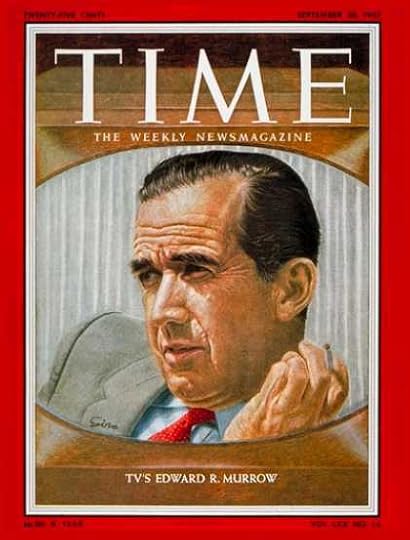
“This . . . is London.” With those trademark words, crackling over the airwaves from a city in the midst of blitzkrieg, Edward R. Murrow began a journalistic career that has had no equal. From the opening days of World War II through his death in 1965, Murrow had an unparalleled influence on broadcast journalism. His voice was universally recognized, and a generation of radio and television newsmen emulated his style. Murrow’s pioneering television documentaries have more than once been credited with changing history, and to this day his name is synonymous with courage and perseverance in the search for truth.
In 1937, Edward R. Murrow was sent by CBS to set up a network of correspondents to report on the gathering storm in Europe. He assembled a group of young reporters whose names soon became household words in wartime America, among whom were William Shirer, Charles Collingwood, Bill Shael, and Howard K. Smith. The group, which came to be known collectively as “Murrow’s Boys,” reported the whole of World War II from the front lines with a courage and loyalty inspired by Murrow’s own fearlessness. During the war Murrow flew in more than twenty bombing missions over Berlin, and along with Bill Shadel was the first Allied correspondent to report the horrors from the Nazi death camps.
Returning to America after the war, Murrow was surprised to find that his overseas reports had made him a star at home. With the advent of television, Murrow was approached to host a weekly program. Along with his associate, Fred Friendly, Murrow had been producing a popular radio show, Hear It Now. The television show was to be called See It Now. Joe Wershba, a reporter who worked closely with Murrow, remembers, “Neither of them knew anything about film making or television. All they knew was they wanted to do stories. Important stories.” Television was in its infancy and Murrow and Friendly had to learn the process of filmmaking and the primitive television equipment on the job.
Murrow’s love of common America led him to seek out stories of ordinary people. He presented their stories in such a way that they often became powerful commentaries on political or social issues. See It Now consistently broke new ground in the burgeoning field of television journalism. In 1953, Murrow made the decision to investigate the case of Milo Radulovich. Radulovich had been discharged from the Air Force on the grounds that his mother and sister were communist sympathizers. The program outlined the elements of the case, casting doubt on the Air Force’s decision, and within a short while, Milo Radulovich had been reinstated. This one edition of See It Now marked a change in the face of American journalism and a new age in American politics.
Soon after the Milo Radulovich program aired, it was learned that Senator Joseph McCarthy was preparing an attack on Murrow. As it happened, Murrow himself had been collecting material about McCarthy and his Senate Investigating Committee for several years, and he began assembling the program. Broadcast on March 9, 1954, the program, composed almost entirely of McCarthy’s own words and pictures, was a damning portrait of a fanatic. McCarthy demanded a chance to respond, but his rebuttal, in which he referred to Murrow as “the leader of the jackal pack,” only sealed his fate. The combination of the program’s timing and its persuasive power broke the Senator’s hold over the nation. The entire fiasco, however, caused a rift with CBS, and they decided to discontinue See It Now.
By 1961 tensions had become irreparable between Murrow and CBS and he accepted an appointment from President Kennedy as the head of the United States Information Agency. He was only to have the job for three years before being diagnosed with lung cancer. In 1964 Murrow was awarded the Presidential Medal of Freedom and in 1965 died on his farm in New York. Perhaps more than any reporter before or since, Murrow captured the trust and belief of a nation and returned that trust with honesty and courage. His belief in journalism as an active part of the political process and a necessary tool within democracy has forever altered the politics and everyday life of the American people. (Source: http://www.pbs.org/wnet/americanmaste...)
More:
http://en.wikipedia.org/wiki/Edward_R...
http://www.otr.com/murrow.shtml
http://dca.lib.tufts.edu/features/mur...
http://www.nytimes.com/learning/gener...
http://www.evesmag.com/murrow.htm
http://www.cfr.org/thinktank/fellowsh...
http://www.jewishvirtuallibrary.org/j...
http://www.britannica.com/EBchecked/t...
http://www.quotationspage.com/quotes/...
http://worldhistoryproject.org/topics...
http://www.edwardmurrow.com/
 by Bob Edwards (no photo)
by Bob Edwards (no photo) by
by
 Joseph E. Persico
Joseph E. Persico by Phillip Seib (no photo)
by Phillip Seib (no photo) by Mark Bernstein (no photo)
by Mark Bernstein (no photo) by
by
 Norman H. Finkelstein
Norman H. Finkelstein by Edward Bliss Jr (no photo)
by Edward Bliss Jr (no photo) by
by
 Edward R. Murrow
Edward R. Murrow by
by
 Edward R. Murrow
Edward R. Murrow by George Clack (no photo)
by George Clack (no photo)(no image)See It Now: A Selection in Text and Pictures by
 Edward R. Murrow
Edward R. Murrow
Major General Lewis Brereton

Lewis Hyde Brereton (June 21, 1890 – July 20, 1967) was a military aviation pioneer and Lieutenant general in the United States Air Force. A 1911 graduate of the United States Naval Academy, he began his military career as a United States Army officer in the Coast Artillery Corps prior to World War I, then spent the remainder of his service as a career aviator.
Brereton was one of the few senior U.S. commanders in World War II who served in combat theaters continuously from the attack on Pearl Harbor to the German surrender, and he saw action in more theaters than any other senior officer. He began World War II as a major general commanding the Far East Air Force in the Philippines and concluded it as a lieutenant general in command of the First Allied Airborne Army. Brereton commanded forces in four controversial events of the war: the destruction on the ground of much of the United States Army Air Forces in the Philippines, Operation Tidal Wave; Operation Cobra; and Operation Market-Garden.
Brereton was one of the first military pilots of the United States Army, assigned to the Aeronautical Division, U.S. Signal Corps in September 1912. He was one of five pioneers (the others being General of the Air Force Henry H. Arnold, Major Generals Frank P. Lahm and Benjamin D. Foulois, and Brigadier General Thomas DeW. Milling) who were members of the United States Air Force and all of its progenitors, and the only one to do so on continuous active duty (Arnold, Lahm, Foulois, and Milling were all on the retired list when the USAF came into being).
(Source:http://en.wikipedia.org/wiki/Lewis_H.... - much more at this site)
More:
http://www.arlingtoncemetery.net/brer...
http://www.youtube.com/watch?v=99esby...
http://www.eisenhower.archives.gov/re...
http://www.airpower.maxwell.af.mil/ai...
http://library.syr.edu/digital/guides...
 by
by
 Carlo D'Este
Carlo D'Este
 by Thomas Alexander Hughes
by Thomas Alexander Hughes
 by James A. Huston
by James A. Huston
(no image) The Brereton Diaries: The War In The Air In The Pacific, Middle East, And Europe, 3 October 1941 8 May 1945 by Lewis Brereton (no photo)
(no image) They Fought with What They Had: The Story of the Army Air Forces in the Southwest Pacific, 1941-1942 by Walter D. Edmonds
Walter D. Edmonds

Lewis Hyde Brereton (June 21, 1890 – July 20, 1967) was a military aviation pioneer and Lieutenant general in the United States Air Force. A 1911 graduate of the United States Naval Academy, he began his military career as a United States Army officer in the Coast Artillery Corps prior to World War I, then spent the remainder of his service as a career aviator.
Brereton was one of the few senior U.S. commanders in World War II who served in combat theaters continuously from the attack on Pearl Harbor to the German surrender, and he saw action in more theaters than any other senior officer. He began World War II as a major general commanding the Far East Air Force in the Philippines and concluded it as a lieutenant general in command of the First Allied Airborne Army. Brereton commanded forces in four controversial events of the war: the destruction on the ground of much of the United States Army Air Forces in the Philippines, Operation Tidal Wave; Operation Cobra; and Operation Market-Garden.
Brereton was one of the first military pilots of the United States Army, assigned to the Aeronautical Division, U.S. Signal Corps in September 1912. He was one of five pioneers (the others being General of the Air Force Henry H. Arnold, Major Generals Frank P. Lahm and Benjamin D. Foulois, and Brigadier General Thomas DeW. Milling) who were members of the United States Air Force and all of its progenitors, and the only one to do so on continuous active duty (Arnold, Lahm, Foulois, and Milling were all on the retired list when the USAF came into being).
(Source:http://en.wikipedia.org/wiki/Lewis_H.... - much more at this site)
More:
http://www.arlingtoncemetery.net/brer...
http://www.youtube.com/watch?v=99esby...
http://www.eisenhower.archives.gov/re...
http://www.airpower.maxwell.af.mil/ai...
http://library.syr.edu/digital/guides...
 by
by
 Carlo D'Este
Carlo D'Este by Thomas Alexander Hughes
by Thomas Alexander Hughes by James A. Huston
by James A. Huston(no image) The Brereton Diaries: The War In The Air In The Pacific, Middle East, And Europe, 3 October 1941 8 May 1945 by Lewis Brereton (no photo)
(no image) They Fought with What They Had: The Story of the Army Air Forces in the Southwest Pacific, 1941-1942 by
 Walter D. Edmonds
Walter D. Edmonds
 Kichisaburo Nomura
Kichisaburo Nomura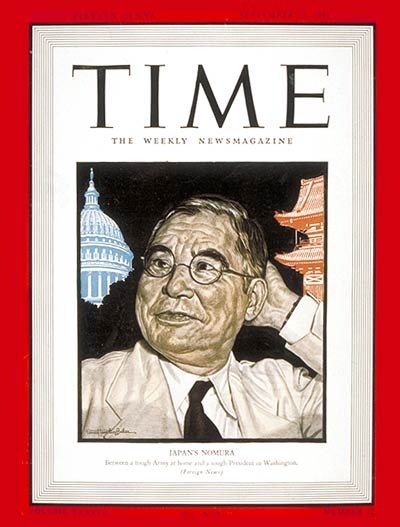
Nomura was born in Wakayama city, Wakayama prefecture. He graduated from the 26th class of the Imperial Japanese Naval Academy in 1898, with a ranking of 2nd out of a class of 57 cadets. As a midshipman, he served on the corvette Hiei and battleship Yashima. He was promoted to ensign on January 12, 1900, and to sub-lieutenant on October 1, 1901. As a crewman, he made a voyage to the United States on the battleship Mikasa from 1901-1902.
Promoted to lieutenant on September 26, 1903, he served on a large number of ships, including the gunboat Maya, corvette Kongō and cruiser Tokiwa. He served as chief navigator on the cruiser Saien (1904), and cruiser Takachiho during the Russo-Japanese War. After the war, he was chief navigator on the cruisers Hashidate and Chitose. In March 1908, he was sent as naval attaché to Austria. He was promoted to lieutenant commander on September 25, 1908, and became naval attaché to Germany in 1910. He returned to Japan in May 1911, and became executive officer on the cruiser Otowa in September 1911. In June 1912, he was assigned a number of staff roles and was promoted to commander on December 1, 1913. During World War I, from 11 December 1914 until 1 June 1918, Nomura was naval attaché to the United States. While in the United States, he was promoted to captain on April 1, 1917.
On Nomura's return to Japan, he received his first command, the cruiser Yakumo. However, only a month later, he was re-assigned back to the Imperial Japanese Navy General Staff, which included a trip to France as part of Japan's delegation to the Versailles Peace Treaty Conference. Following the conclusion of these negotiations, he returned to Washington DC to participate in the Washington Naval Conference of 1921-1922. On June 1, 1922, Nomura was promoted to rear admiral. He served as chief of the 3rd section of the Navy General Staff, followed by Commander of the 1st Expeditionary Fleet, Director of the Education Bureau, and Vice Chief of the Navy General Staff. He was promoted to vice admiral on December 1, 1926. On 11 June 1930, Nomura became Commander in Chief of the Kure Naval District. He was Commander in Chief of the Yokosuka Naval District in December 1930.
During the First Shanghai Incident in 1932, he was appointed as commander of the Japanese forces (army and navy) fighting in Shanghai. However, he was replaced by Kenkichi Ueda when the Japanese forces did not manage to win. Finally, Yoshinori Shirakawa was the Japanese commander appointed who won the battle in Shanghai.
Nomura was promoted to full admiral on March 1, 1933. From 1933-1937, Nomura served as Naval Councilor on the Supreme War Council, and retired from active service in 1937.
After his retirement, Nomura was principal of the Gakushuin Peer's school from 1937-1939. He was appointed Foreign Minister of Japan from 1939-1940 in the cabinet of Nobuyuki Abe. On November 27, 1940, Nomura was sent as ambassador to the United States, replacing Kensuke Horinouchi (who had served since March, 1939). Through much of 1941, Ambassador Nomura negotiated with United States Secretary of State Cordell Hull in an attempt to prevent war from breaking out between Japan and the United States. Nomura and Hull attempted to resolve issues including the Japanese conflict with China, the Japanese occupation of French Indochina, and the United States oil embargo against Japan. Nomura's repeated pleas to his superiors to offer the Americans meaningful concessions were rejected by his own government. On November 15, 1941, Nomura was joined by a "special envoy" to Washington, Saburō Kurusu.
After World War II, Nomura denied that he knew beforehand of the attack. Reportedly Nomura and Kurusu had to personally decode the radioed message of Japan's breaking off the negotiations with the United States (which given the circumstances practically meant war), as it had been sent from Japan on Monday, December 8 and was received when the embassy's technical support staff was still on Sunday holiday. Nomura stated that this is why he had been unable to deliver the message until after the actual attack had taken place. In his memoirs, Hull credited Nomura with having been sincere in trying to prevent war between Japan and the USA.
On August 20, 1942, Nomura returned to Japan. He continued to serve in an unofficial capacity as an advisor to the government through World War II, and was appointed to the Privy Council in May 1945.
After the war, Nomura started a new career: He was hired by Konosuke Matsushita to work in his company as a general manager and was sent to manage Victor Company of Japan, which was owned by Matsushita. He was then invited by Prime Minister Shigeru Yoshida to serve as a member of a committee studying rearmament of Japan.
In 1954, Nomura ran for the House of Councilors (upper house) and was elected by a landslide. In the late 1950s he was considered to be a strong candidate to head the Defense Agency by both Prime Ministers Ichirō Hatoyama and Nobusuke Kishi, but declined each offer expressing his belief in civilian control of armed forces. Nomura had been a civilian for nearly two decades by that time but he was still regarded by many as a retired admiral of the old Imperial Japanese navy.
Nomura was reelected to the upper house in 1960 and died in office in 1964. (Source: http://en.wikipedia.org/wiki/Kichisab...)
More:
http://ww2db.com/person_bio.php?perso...
http://ospreypearlharbor.com/encyclop...
http://www.foreignaffairs.com/article...
http://www.saipanstewart.com/essays/b...
http://usforeignpolicy.about.com/od/a...
http://www.procomtours.com/saburo_kur...
http://www.awesomestories.com/flicks/...
 by Peter Mauch (no photo)
by Peter Mauch (no photo) by Cordell Hull no (photo)
by Cordell Hull no (photo) by
by
 Gordon W. Prange
Gordon W. Prange by Robert B. Stinnett (no photo)
by Robert B. Stinnett (no photo) by Roberta Wohlstetter (no photo)
by Roberta Wohlstetter (no photo) by Stanley H. Smith (no photo)
by Stanley H. Smith (no photo)(no image)The Occupation-Era Correspondence of Kichisaburo Nomura by Peter Mauch (no photo)
 Harry Truman
Harry Truman

As Senator
In 1934, Truman asked Pendergast to support his run for a seat in the United States House of Representatives. Though the details of this episode are murky, Pendergast supposedly agreed initially but then changed his mind: he wanted Truman to run for the U.S. Senate. Following a bruising Democratic primary that featured widespread ballot-box stuffing by Truman's (and his main competitor's) supporters, Truman captured the Democratic nomination. He then easily defeated his Republican opponent in November. On December 31, 1934, Senator-elect Truman, his wife Bess, and daughter Margaret arrived in Washington, D.C.
Truman's first term as senator was largely unremarkable. He enjoyed his life in the Senate, especially the male camaraderie and "old boys" network that characterized the institution. The long hours and time away from Bess and Margaret tried his family life, however. Politically, Truman emerged as a reliable ally of President Franklin D. Roosevelt's "New Deal" programs and built especially strong ties with labor unions. He made his mark on transportation issues as a member of the Appropriations Committee and the Interstate Commerce Committee. He helped write (with Democratic Senator Burton Wheeler of Montana) the Transportation Act of 1940, which tried to bring some order to the tangle of regulations affecting transportation industries. Truman also helped design the Civil Aeronautics Act of 1938, which laid the groundwork for the growth of the airline industry over the next four decades.
Truman's first term as senator was largely unremarkable. He enjoyed his life in the Senate, especially the male camaraderie and "old boys" network that characterized the institution. The long hours and time away from Bess and Margaret tried his family life, however. Politically, Truman emerged as a reliable ally of President Franklin D. Roosevelt's "New Deal" programs and built especially strong ties with labor unions. He made his mark on transportation issues as a member of the Appropriations Committee and the Interstate Commerce Committee. He helped write (with Democratic Senator Burton Wheeler of Montana) the Transportation Act of 1940, which tried to bring some order to the tangle of regulations affecting transportation industries. Truman also helped design the Civil Aeronautics Act of 1938, which laid the groundwork for the growth of the airline industry over the next four decades.
Truman faced a tough re-election campaign in 1940. The Democratic machine that had powered him to victory in 1934 had collapsed during the intervening years. Pendergast was ill and in prison as the election cycle approached. As in 1934, Truman's largest challenge was winning the Democratic nomination. He managed to defeat Governor Lloyd Stark by only 8,000 votes; Truman overcame Stark's support from rural voters by running up large margins in urban Kansas City and St. Louis. According to Truman biographer Alonzo Hamby, the 1940 election showed Truman to be a "candidate of the cities, an urban liberal."
Truman began his second term in the Senate in 1941 as the United States prepared for war. During the last six months of 1940, Congress had appropriated more than ten billion dollars for defense and military spending. Truman convinced the Senate leadership and the Roosevelt administration to make him head of a special Senate investigative committee—which became known as the Truman committee—charged with uncovering and stopping wasteful defense spending. He described the committee's work as protecting the "little man" from the greedy predations of big labor and big business. While moderately successful on this score, he did garner both popularity and recognition.
The coming of World War II forced Truman to clarify and crystallize his thinking about American foreign policy. In the mid-1930s, Truman voted for the Neutrality Acts, but this support was politically motivated—his constituents were mildly isolationist—rather than indicative of a deeply-ingrained isolationism. Indeed, Truman had warned publicly of the threats posed by Germany and Japan and of the need for increased American military preparedness. After the outbreak of hostilities in August 1939, Truman supported initiatives like the "cash-and-carry" and Lend-Lease policies designed to succor American allies in their time of need. He also supported American rearmament efforts and the Selective Service Act. Truman explained his evolving position in early 1941, writing to a Missouri voter, "We are facing a bunch of thugs, and the only theory a thug understands is a gun and a bayonet."
(Source: http://millercenter.org/president/tru...)
More:
http://bioguide.congress.gov/scripts/...
https://en.wikipedia.org/wiki/Harry_S...
http://en.wikipedia.org/wiki/Truman_C...
http://www.trumanlibrary.org/
http://www.pbs.org/wgbh/americanexper...
http://www.senate.gov/artandhistory/h...
 by
by
 David McCullough
David McCullough by
by
 Alonzo L. Hamby
Alonzo L. Hamby by
by
 Margaret Truman
Margaret Truman by
by
 Robert Dallek
Robert Dallek by Robert H. Ferrell (no photo)
by Robert H. Ferrell (no photo) by James A. Thurber (no photo)
by James A. Thurber (no photo) by
by
 Thomas J. Fleming
Thomas J. Fleming
 Governor Culbert Olson
Governor Culbert Olson
Culbert Olson was born in Filmore, Utah on 7th November, 1876. His mother was involved in the campaign for women's suffrage and eventually became the first female elected official in Utah. He was brought up in the Church of Jesus Christ of Latter-day Saints (Mormon) but rejected religion at an early age.
At the age of fourteen Olson left school and found work as a telegraph operator. In 1890 Olson enrolled in the Brigham Young University at Provo, Utah. After graduating he found work as a journalist for the Daily Ogden Standard.
Olson took a keen interest in politics and in 1896 campaigned for William Jennings Bryan. He later moved to Washington as a newspaper correspondent.
Olson studied law at George Washington University and the University of Michigan and was admitted to the Utah Bar in 1901. Olson became a lawyer in Salt Lake City. A member of the Democratic Party, Olson was elected to the state legislature of Utah in 1916. Over the next four years he advocated an end to child labour, progressive taxation, old age pensions, government control of public utilities and legislation to protect the rights of trade unionists.
In 1920 Olson moved to Los Angeles. In his law practice he gained a reputation for investigating business fraud. In the 1924 presidential election he campaigned for Robert La Follette and the Progressive Party and later for the novelist, Upton Sinclair, when he tried to become Governor of California.
A strong supporter of Franklin D. Roosevelt and the New Deal, in 1934 Olson became state chairman of the Democratic Party. In November 1938 Olson was elected as Governor of California, the first Democrat to hold this office for forty-four years.
One of the first acts was to pardon Tom Mooney, a trade union leader who had been convicted of a bombing which occurred in San Francisco in 1916. Although strong evidence existed that the District Attorney of the time, Charles Fickert, had framed Mooney, the Republican governors during this period, William Stephens (1917-1923), Friend Richardson (1923-1927), Clement Young (1927-1931), James Rolph (1931-1934) and Frank Merriam (1934-39) refused to order his release. In October 1939, Olson pardoned Warren Billings, a friend of Mooney's who had also been imprisoned for the bombing.
As governor Olson tried to introduce an advanced New Deal in California. In Olson's words that would provide "economic security from the cradle to the grave, under a government that recognizes the right to an education, to employment on a basis of just reward, and to retirement at old age in comfort and decency, as inalienable as the right to life itself."
Olson was defeated in his campaign to be re-elected in 1942. Olson, an atheist, told a friend that he lost "because of the active hostility of a certain privately owned power corporation and the Roman Catholic Church in California."
In 1957 Culbert Olson became president of the United Secularists of America and held the post until his death in Los Angeles on 13th April, 1962. (Source: http://www.spartacus.schoolnet.co.uk/...)
More:
http://www.sfmuseum.org/hist8/evac3.html
http://governors.library.ca.gov/29-ol...
http://en.wikipedia.org/wiki/Culbert_...
http://encyclopedia.densho.org/Culber...
http://www.nga.org/cms/home/governors...
http://www.joincalifornia.com/candida...
http://archive.org/details/car_000043
http://www.californiascapitol.com/201...
 by Lawson Fusao Inada (no photo)
by Lawson Fusao Inada (no photo) by
by
 Gail Sakurai
Gail Sakurai by Greg Robinson (no photo)
by Greg Robinson (no photo) by Source Wikipedia (no photo)
by Source Wikipedia (no photo) by
by
 Kevin Starr
Kevin Starr by Robert Eugene Burke (no photo)
by Robert Eugene Burke (no photo)(no image)Gentle Dynamiter: A Biography of Tom Mooney by Estolv E. Ward(no photo)
 John Gilbert Winant
John Gilbert Winant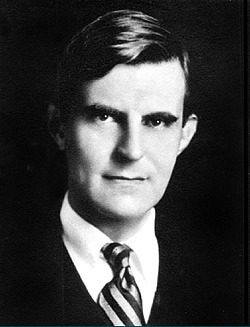
JOHN G. WINANT, the sixty-ninth and seventy-second governor of New Hampshire, was born in New York City on February 23, 1889. His education was attained at St. Paul’s School in Concord, and later he attended Princeton University. His teaching career was temporarily interrupted when he enlisted in the American Expeditionary Force during World War I. Winant first entered politics in 1916, serving as a member of the New Hampshire House of Representatives, a position he was reelected to in 1922. He also served as a member of the New Hampshire State Senate from 1921 to 1922. Winant next secured the Republican gubernatorial nomination, and was elected governor by a popular vote in 1924. After losing his 1926 reelection bid, Winant was successful in both his 1930 and 1932 campaigns. During his tenure, the state banking commission was restructured; the state highway system was advanced; and an executive budget plan was initiated. Also, depression related relief measures were enacted; and Winant was the first governor to work together with the National Planning Board, as well as being the first to satisfy the Civilian Conservation Corps enrollment quota.
After leaving the governorship, Winant secured an appointment to serve as the assistant director of the International Labor Organization in Geneva, a post he held in 1935 and again from 1937 to 1940. He also headed the newly created Social Security Administration Board; was the U.S. ambassador to Great Britain from 1941 to 1946; and served as the U.S. representative to the United Nations Economic and Social Council in 1946.
During World War II, he served on the European Advisory Commission, as well as organizing the 1943 Moscow conference that resulted in the Teheran summit of Allied governments. After writing one volume of his memoirs, Governor John Winant committed suicide. He was buried at St. Paul's School in Concord, New Hampshire.
(Source: http://www.nga.org/cms/home/governors...)
More:
http://en.wikipedia.org/wiki/John_Gil...
http://harvardmagazine.com/2000/11/jo...
http://www.nhcommentary.com/John_Gilb...
http://www.nhcommentary.com/john_gilb...
http://www.fdrlibrary.marist.edu/arch...
http://www.ssa.gov/history/winantpro....
http://www.nytimes.com/1993/11/02/obi...
http://www.winantclayton.org.uk/
http://history.state.gov/departmenthi...?
http://books.google.co.uk/books?id=IU...
http://www.ssa.gov/history/mywinantar...
http://www.findagrave.com/cgi-bin/fg....
 by
by
 Lynne Olson
Lynne Olson by
by
 Madeleine Albright
Madeleine Albright by Richard Breitman (no photo)
by Richard Breitman (no photo)(no image) He Walked Alone: A Biography of John Gilbert Winant by Bernard Bellush (no photo)
(no image) A Letter from Grosvenor Square by John G. Winant (no photo)
 Grace Tully
Grace Tully
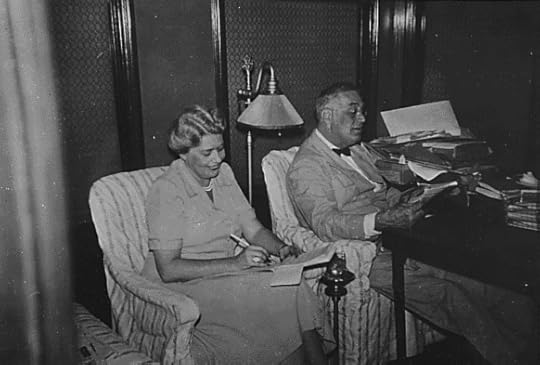
Grace Tully (9 August 1900 - 15 June 1984) was private secretary to U.S. President Franklin D. Roosevelt (FDR).
Grace Tully was born on 9 August 1900 in Bayonne, New Jersey. Her father was a businessman and a loyalist to the Democratic Party. He died when she was young, and Tully and her two sisters and brother were raised by their mother. She received her secretarial education at the Grace Institute in New York, and after graduating was appointed as secretary to Patrick Hayes, bishop of the Roman Catholic Archdiocese of New York.
In 1928, Grace Tully started to work for the Democratic National Committee, and was assigned to assist Eleanor Roosevelt who was organizing support for presidential nominee Al Smith. Later that year, when FDR was nominated for Governor of New York, Grace Tully went to work on his staff.
After Roosevelt's successful election, Tully began serving as the assistant to Missy LeHand, who was Roosevelt's personal secretary in Roosevelt's office at Albany, New York. Tully was given the dictation and typing duties that Lehand disliked. Tully served with FDR for his four years as governor.
Grace Tully moved to Washington DC in 1933, when Roosevelt was elected President. Both she and Missy LeHand were important figures for FDR during his presidency. Tully frequently accompanied FDR on his trips to Hyde Park and Shangri-La (today called Camp David).
When Missy LeHand suffered a stroke in 1941, Grace Tully took over her position as personal secretary to the President. Tully was, however, not a "companion" for Roosevelt in the same way as LeHand had been. She continued working for the President until his death in April 1945 in Warm Springs, where she was present as he died. Then she served as the Executive Secretary for the FDR Foundation. In 1949 she published her memoirs, FDR: My Boss.
In 1955 she joined the staff of the Senate Democratic Policy Committee, working with Lyndon B. Johnson, the Senate Majority Leader at the time. She retired ten years later and died in 1984.
(Source: http://en.wikipedia.org/wiki/Grace_Tully)
More:
http://www.fdrlibrary.marist.edu/arch...
http://www.youtube.com/watch?v=Rs3ghS...
http://www.nytimes.com/1984/06/16/obi...
http://www.fdrlibrary.marist.edu/arch...
http://www.archives.gov/press/press-r...
 by Grace Tully (no photo)
by Grace Tully (no photo) by
by
 Jean Edward Smith
Jean Edward Smith by
by
 Joseph E. Persico
Joseph E. Persico by Craig Shirley (no photo)
by Craig Shirley (no photo) by Alfred B. Rollins, Jr. (no photo)
by Alfred B. Rollins, Jr. (no photo)
 Chief Justice Earl Warren
Chief Justice Earl Warren
Earl Warren was an immensely popular Republican governor when President Dwight Eisenhower appointed him to the Supreme Court. Ike later regretted his choice; he had hoped to appoint a moderate conservative; Warren proved to be an unabashed liberal.
Warren joined the Court in the midst of one of its most important issues: racial segregation in public schools. The new Chief proved an effective leader (unlike his predecessor) by bringing the Brethren from division to unanimity on the issue of racial equality. At the end of his service, Warren concluded that his greatest contribution to government was his opinion in the reapportionment cases. However, his contribution to racial equality still stands as a testament to his role as a leader extraordinaire.
In November 1963, President Lyndon B. Johnson called on a reluctant Warren to serve as a member of the special committee to investigate the assassination of President John F. Kennedy. When first approached by the Attorney General Robert Kennedy (brother to the slain president), Warren declined. He was concerned that such service would tarnish the Court's legitimacy. But in this secretly recorded telephone call, Johnson explained to Sen. Richard Russell how he persuaded Warren to serve.
In a public address following his retirement for the Court, Warren articulated his strong commitment to the principle of equality and admonished Americans that they face continued strife and upheaval by failing to heed the rightful demands for equality.
Personal information:
Born: Thursday, March 19, 1891
Died: Tuesday, July 9, 1974
Childhood Location: California
Childhood Surroundings: California
Position: Chief Justice
Seat: 1
Nominated By: Eisenhower
Commissioned on: Thursday, October 1, 1953
Sworn In: Sunday, October 4, 1953
Left Office: Sunday, June 22, 1969
Reason For Leaving: Retired
Length of Service: 15 years, 8 months, 18 days
Home: California
(Source: http://www.oyez.org/justices/earl_warren)
More:
http://en.wikipedia.org/wiki/Earl_Warren
http://www.vqronline.org/articles/197...
http://www.fjc.gov/servlet/nGetInfo?j...
http://www.lbjlib.utexas.edu/johnson/...
http://www.findagrave.com/cgi-bin/fg....
http://archive.org/details/gov.archiv...
http://www.britannica.com/EBchecked/t...
http://warren.ucsd.edu/about/biograph...
http://www.michaelariens.com/ConLaw/j...
http://www.americanrhetoric.com/speec...
http://www.mnc.net/norway/warren.htm
 by
by
 Earl Warren
Earl Warren by Jim Newton (no photo)
by Jim Newton (no photo) by Ed Cray (no photo)
by Ed Cray (no photo) by Morton J. Horwitz (no photo)
by Morton J. Horwitz (no photo) by Bernard Schwartz (no photo)
by Bernard Schwartz (no photo)
 Walter Lippmann
Walter Lippmann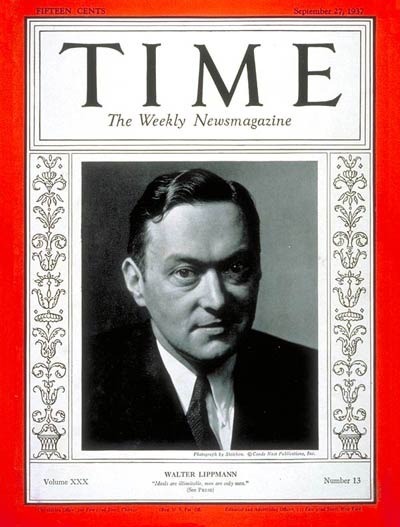
Walter Lippmann (September 23, 1889 – December 14, 1974[1]) was an American public intellectual, writer, reporter, and political commentator famous for being among the first to introduce the concept of Cold War; he coined the term stereotype in the modern psychological meaning as well. Lippmann was twice awarded (1958 and 1962) a Pulitzer Prize for his syndicated newspaper column, "Today and Tomorrow".
Walter Lippmann was born on September 23, 1889, in New York City, to Jacob and Daisy Baum Lippmann; his upper-middle class German Jewish family took annual holidays in Europe. At age 17, he entered Harvard University where he studied under George Santayana, William James, and Graham Wallas, concentrating upon philosophy and languages (he spoke German and French), and earned his degree in three years, graduating as a member of the Phi Beta Kappa society.
Lippmann was a journalist, a media critic and an amateur philosopher who tried to reconcile the tensions between liberty and democracy in a complex and modern world, as in his 1920 book Liberty and the News.
In 1913, Lippmann, Herbert Croly, and Walter Weyl became the founding editors of The New Republic magazine. During World War I, Lippmann became an adviser to President Woodrow Wilson and assisted in the drafting of Wilson's Fourteen Points speech. He sharply criticized George Creel, whom the President appointed to head wartime propaganda efforts at the committee on Public Information. While he was prepared to curb his liberal instincts because of the war saying he had "no doctrinaire belief in free speech", he nonetheless advised Wilson that censorship should "never be entrusted to anyone who is not himself tolerant, nor to anyone who is unacquainted with the long record of folly which is the history of suppression."
Walter Lippmann examined the coverage of newspapers and saw many inaccuracies and other problems. He and Charles Merz, in a 1920 study entitled A Test of the News, stated that The New York Times' coverage of the Bolshevik revolution was biased and inaccurate. In addition to his Pulitzer Prize-winning column "Today and Tomorrow," he published several books. Lippmann was the first to bring the phrase "cold war" to common currency in his 1947 book by the same name.
It was Lippmann who first identified the tendency of journalists to generalize about other people based on fixed ideas. He argued that people—including journalists—are more apt to believe "the pictures in their heads" than come to judgment by critical thinking. Humans condense ideas into symbols, he wrote, and journalism, a force quickly becoming the mass media, is an ineffective method of educating the public. Even if journalists did better jobs of informing the public about important issues, Lippmann believed "the mass of the reading public is not interested in learning and assimilating the results of accurate investigation." Citizens, he wrote, were too self-centered to care about public policy except as pertaining to pressing local issues.
Lippmann saw the purpose of journalism as "intelligence work". Within this role, journalists are a link between policymakers and the public. A journalist seeks facts from policymakers which he then transmits to citizens who form a public opinion. In this model, the information may be used to hold policymakers accountable to citizens. This theory was spawned by the industrial era and some critics[citation needed] argue the model needs rethinking in post-industrial societies.
Though a journalist himself, he did not assume that news and truth are synonymous. For Lippmann, the “function of news is to signalize an event, the function of truth is to bring to light the hidden facts, to set them in relation with each other, and make a picture of reality on which men can act.” A journalist’s version of the truth is subjective and limited to how he constructs his reality. The news, therefore, is “imperfectly recorded” and too fragile to bear the charge as “an organ of direct democracy.”
To his mind, democratic ideals had deteriorated, voters were largely ignorant about issues and policies, they lacked the competence to participate in public life and cared little for participating in the political process. In Public Opinion (1922), Lippmann noted that the stability the government achieved during the patronage era of the 19th century was threatened by modern realities. He wrote that a “governing class” must rise to face the new challenges.
The basic problem of democracy, he wrote, was the accuracy of news and protection of sources. He argued that distorted information was inherent in the human mind. People make up their minds before they define the facts, while the ideal would be to gather and analyze the facts before reaching conclusions. By seeing first, he argued, it is possible to sanitize polluted information. Lippmann argued that seeing through stereotypes (which he coined in this specific meaning) subjected us to partial truths. Lippmann called the notion of a public competent to direct public affairs a "false ideal." He compared the political savvy of an average man to a theater-goer walking into a play in the middle of the third act and leaving before the last curtain.
Early on Lippmann said the "bewildered herd," his way of referring to the masses, must be governed by “a specialized class whose interests reach beyond the locality." This class is composed of experts, specialists and bureaucrats. The experts, who often are referred to as "elites," were to be a machinery of knowledge that circumvents the primary defect of democracy, the impossible ideal of the "omnicompetent citizen". Later, in The Phantom Public (1925), he recognized that the class of experts were also, in most respects, outsiders to any particular problem, and hence, not capable of effective action. Philosopher John Dewey (1859–1952) agreed with Lippmann's assertions that the modern world was becoming too complex for every citizen to grasp all its aspects, but Dewey, unlike Lippmann, believed that the public (a composite of many “publics” within society) could form a “Great Community” that could become educated about issues, come to judgments and arrive at solutions to societal problems.
Following the removal from office of Henry A. Wallace in September 1946, Lippmann became the leading public advocate of the need to respect a Soviet sphere of influence in Europe, as opposed to the containment strategy being advocated at the time by people like George F. Kennan. In July 1959 Lippman denied that Castro's regime will be allied with the USSR saying: "It would be a great mistake even to intimate that Castro's Cuba has any real prospect of becoming a Soviet satellite."
Lippmann was an informal adviser to several presidents. On September 14, 1964, President Lyndon Johnson presented Lippmann with the Presidential Medal of Freedom. He later had a rather famous feud with Johnson over his handling of the Vietnam War, of which Lippmann had become highly critical.
Lippman retired from his syndicated column in 1967, and died in 1974.(Source: http://en.wikipedia.org/wiki/Walter_L...)
More:
http://www.spartacus.schoolnet.co.uk/...
http://www.brainyquote.com/quotes/aut...
http://www.opendemocracy.net/article/...
http://www.faculty.english.vt.edu/Col...
http://nieman.harvard.edu/NiemanFound...
http://historymatters.gmu.edu/d/5172/
http://www.theatlantic.com/walter-lip...
http://media.litmuse.net/essays/the-r...
http://www.thepublicdiscourse.com/201...
http://noam-chomsky.tumblr.com/post/1...
(no image)Walter Lippman, Philosopher-Journalist by Edward and Schapsmeier, Frederick Schapsmeier (no photo)
(no image)American Top Journalists Analyse Russia: Pulitzer Prize Winning Articles and Cartoons by Heinz-Dietrich Fischer (no photo)
(no image) The Public Philosophy On the Decline and Revival of the Western Society by
 Walter Lippmann
Walter Lippmann by Frederick Schauer (no photo)
by Frederick Schauer (no photo) by C. Neil Macrae (no photo)
by C. Neil Macrae (no photo) by B.A. Taleb (no photo)
by B.A. Taleb (no photo)





 by
by
 Walter Lippmann
Walter Lippmann
 Laurence Steinhardt
Laurence Steinhardt 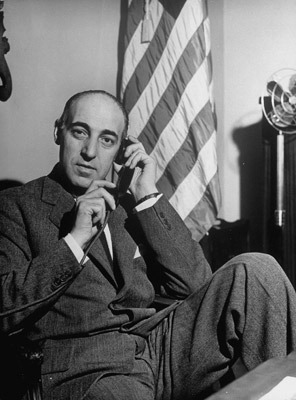
Steinhardt was born October 6, 1892 in New York City. He served as a Sergeant in the Quartermaster Corps in the U.S. Army in World War I.
He was a member of the Federation of American Zionists and the American Zion Commonwealth. He practised law at Guggenheimer, Untermyer and Marshall, where his uncle Samuel Untermyer was partner, from 1920 through 1933. In 1932, he worked on the presidential campaign of Franklin Roosevelt.
Steinhardt was appointed U.S. Minister to Sweden in 1933 by Franklin D. Roosevelt. He was appointed ambassador to Peru in 1937, the Soviet Union in 1939. In 1941, he evacuated Moscow evacuation to Kuybyshev.
On January 12, 1942, he was appointed ambassador to Turkey. While ambassador to Turkey, Steinhardt, particularly because he was Jewish, was involved in the rescue of Hungarian Jews from Bergen Belsen. He also played a significant role in helping many eminent intellectuals fleeing Europe to find refuge in Turkey.
In 1945, President Truman appointed Steinhardt ambassador to Czechoslovakia, and to Canada in 1948. While serving as the Ambassador to Canada, he was killed in a plane crash on March 28, 1950 near Ramsayville, Ontario, while en route to Washington, D. C.
He is buried in section 30, Arlington National Cemetery.
(Source: https://en.wikipedia.org/wiki/Laurenc...)
More:
http://newsfeed.time.com/2012/09/12/b...
http://history.state.gov/departmenthi...
http://www.arlingtoncemetery.net/last...
http://www.nndb.com/people/338/000120...
http://www.jta.org/1950/03/29/archive...
http://politicalgraveyard.com/familie...
 by Dennis J. Dunn (no photo)
by Dennis J. Dunn (no photo) by Igor Lukes (no photo)
by Igor Lukes (no photo) by Richard Breitman (no photo)
by Richard Breitman (no photo) by John Earl Haynes (no photo)
by John Earl Haynes (no photo)(no image) Who's Who in Jewish History: After the Period of the Old Testament by Joan Comay (no photo)
 Admiral Husband Edward Kimmel
Admiral Husband Edward Kimmel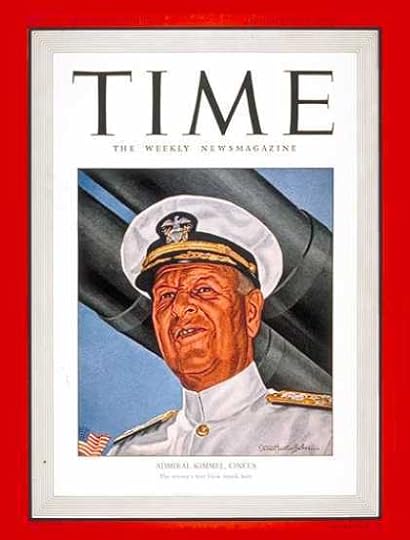
Husband Edward Kimmel was born to a US Army major in Henderson, Kentucky, United States. He graduated from the United States Naval Academy in Maryland, United States in 1904 as an ordnance specialist, and subsequently served aboard several battleships and destroyers and held other shore posts. With his academic credentials earned at the Naval War College and his impressive career record, he was promoted to the flag rank of rear admiral in 1937 with such responsibilities as being the commander of Cruiser Division Seven on a diplomatic trip to South America, and the commander of Cruisers of Battle Force Fleet. His experience led to his appointment as the Commander-in-Chief of the United States Pacific Fleet, with a brevet rank of admiral. In this role, he was said to be a hard worker that inspired subordinates, but some had also criticized that his over-attention to detail betrayed his lack of self-confidence, thus always spending the time to revisit minute tasks he had done previous when he could have delegated the work to others in the first place.
On the opening chapter of the United States' involvement in the Pacific War, the location of his headquarters, Pearl Harbor, Territory of Hawaii was subjected to a Japanese raid, which killed over 3,000 and temporarily disabled his fleet. Kimmel, along with his US Army counterpart Lieutenant General Walter Short, was one of the principle scapegoats, and he was relieved from his command merely ten days after the raid and was reverted back to his permanent rank of rear admiral. He was subsequently found guilty of errors of judgement and dereliction of duty, and retired from the US Navy in 1942.
In retirement, Kimmel was hired by the military contractor Frederick R. Harris, Inc. He passed away at Groton, Connecticut, United States, in 1968, at the age of 86. It was not until after his death before the United States Senate cleared his name on 25 May 1999, although the Department of Defense would continue to place the blame of the Pearl Harbor disaster on Kimmel and Short. "(Kimmel and Short) were denied vital intelligence that was available in Washington", said Senator William Roth, Jr., noting that they had been made into scapegoats in 1941 to lift blame from other high ranking officers. The attack on Pearl Harbor faced nine investigations, the national attention was clearly unjustly weighted on this single event when, for example, the same unpreparedness for Japanese aggression was equally as great at the Philippine Islands. When President Franklin Roosevelt ordered Supreme Court Justice Owen Roberts to head up the investigative commission, which was appropriately named the Robers Commission, many argue that Roosevelt had much political motivation in mind. By charging Kimmel and Short with failure to defend the important American military bases at the Territory of Hawaii, Roosevelt paved himself a path to take military action against Japanese aggression that he had long wished to intervene, and cleared himself of any faults of his own for his re-election campaign in 1944.
(Source: http://ww2db.com/person_bio.php?perso...)
More:
http://en.wikipedia.org/wiki/Husband_...
http://www.history.navy.mil/photos/pe...
http://www.hendersondepot.org/admiral...
http://www.nationalgeographic.com/pea...
http://ussslcca25.com/zach15.htm
http://www.nndb.com/people/973/000024...
http://www.kimmelfamily.net/Husband.htm
http://archive.org/details/1946-01-14...
http://www.pearlharbor911attacks.com/...
 by
by
 Robert Leckie
Robert Leckie by
by
 W.E.B. Griffin
W.E.B. Griffin by
by
 William Raymond Manchester
William Raymond Manchester by Husband Edward Kimmel (no photo)
by Husband Edward Kimmel (no photo) by Walter R. Borneman (no photo)
by Walter R. Borneman (no photo)
 South African Field Marshal Jan Christian Smuts
South African Field Marshal Jan Christian Smuts
Jan Christian Smuts was born 24 May 1870, on the farm Ongegund near Riebeeck West in what is now South Africa. He was educated at Victoria College at Stellenbosch and studied law at Cambridge. He returned to South Africa after his studies at Cambridge in 1895. As a result of the Jameson Raid against the Transvaal (29 December - 2 January 1895-6, certainly one of the initiating events of the Boer War), his political leanings turned from endorsement of Cecil Rhodes’ dream of a British Africa to support of President Paulus Kruger and the South African Republic. In June 1898, Smuts was appointed State Attorney for the South African Republic.
After the start of the Boer War and the fall of Pretoria in June 1900, Smuts took to the field and led a Boer unit in the area of Vereeniging and Potchefstroom. At the Boer conference in June 1901, it was decided Smuts would lead an expedition into the Cape Colony. In early September Smuts and his unit crossed the Orange River near Zastron and entered Cape Colony. By early October they were in sight of Port Elizabeth and from here they turned west and by January 1902 Smuts and his men were in the western part of Cape Colony. The towns of Springbok and Concordia were taken and O’Okiep was soon under siege. Smuts participated in the meetings at Vereeniging and was there when the surrender was signed at the end of May 1902.
After the elections of February 1907, Smuts became part of Premier Louis Botha’s cabinet. In May 1910, the Union of South Africa was achieved under a constitution Smuts helped to write.
When WWI started, the British government thought it desirable if the South African forces could capture German South West Africa and destroy the powerful wireless transmitters there. Before joining the war on the British side, Premier Botha and Smuts had to put down an open rebellion in South Africa by units of their armed forces and some influential veterans of the Boer War. Premier Botha (once commander-in-chief of the Boer Army) returned to the field as General and led the South African and British forces supported by Major-General Smuts and forced the surrender of the German forces in July 1915. Soon, in February 1916, now Lieutenant-General Smuts, took command of the Allied forces in East Africa. Here he entered the chase for Colonel Paul Lettow-Vorbeck but Colonel Lettow-Vorbeck evaded capture even to the end of the war.
In January 1917 Lieutenant-General Smuts turned over command and left for England where he had been appointed a member of the Imperial War Cabinet. He resigned the War Cabinet in December 1918 and in late June 1919 he and Premier Botha signed the Treaty of Versailles.
Upon the death of Premier Botha in late August 1919, Smuts became Premier of South Africa and remained so until 1924. In September 1939 he was again Premier and was Commander-in-Chief of the South African and Rhodesian Forces from 1940-1945. In September 1941 he was awarded the rank of Field Marshal. When the war ended in Europe in May 1945, Premier Smuts was in San Francisco working with other delegates on the United Nations Charter.
Field Marshal Jan Christian Smuts died at home in South Africa on 11 September 1950.
(Source: http://net.lib.byu.edu/estu/wwi/bio/s...)
More:
http://www.spartacus.schoolnet.co.uk/...
https://en.wikipedia.org/wiki/Jan_Smuts
http://www.southafrica.info/about/his...
http://zar.co.za/smuts.htm
http://www.info.gov.za/aboutsa/histor...
http://lenel.ch/docs/Jan-Smuts-e.pdf
http://en.wikipedia.org/wiki/Pretoria
http://www.britannica.com/EBchecked/t...
http://www.history.com/this-day-in-hi...
http://www.bwm.org.au/site/About_the_...
 by Spencer C. Tucker (no photo)
by Spencer C. Tucker (no photo) by Rene Kraus (no photo)
by Rene Kraus (no photo) by Jesse Russell (no photo)
by Jesse Russell (no photo) by H.C. Armstrong (no photo)
by H.C. Armstrong (no photo) by Anne Samson (no photo)
by Anne Samson (no photo)(no image)Jan Christian Smuts: A Biography by Jan Christian Smuts (no photo)
(no image)Jan Christian Smuts A Bibliophile? by Jacqueline A Kalley (no photo)
(no image)Jan Christian Smuts: The Conscience of a South African by Kenneth Ingham (no photo)
(no image)General Louis Botha A Biography by Johannes Meintjes (no photo)
 J. Edgar Hoover
J. Edgar Hoover
John Edgar Hoover was born in Washington, D.C. on January 1, 1895. Upon completing high school, he began working at the Library of Congress and attending night classes at George Washington University Law School. In 1916, he was awarded his LL.B. and the next year his LL.M.
Mr. Hoover entered on duty with the Department of Justice on July 26, 1917, and rose quickly in government service. He led the Department’s General Intelligence Division (GID) and, in November 1918, he was named assistant to the attorney general. When the GID was moved in the Bureau of Investigation in 1921, he was named assistant director of the BOI. On May 10, 1924, Attorney General Harlan Fiske Stone appointed the 29-year-old Hoover acting director of the Bureau, and by the end of the year Mr. Hoover was named Director.
As Director, Mr. Hoover put into effect a number of institutional changes to correct criticisms made of his predecessor’s administration. Director Hoover fired a number of agents whom he considered to be political appointees and/or unqualified to be special agents. He ordered background checks, interviews, and physical testing for new agent applicants and he revived the earlier Bureau policies of requiring legal or accounting training.
Under Director Hoover, the Bureau grew in responsibility and importance, becoming an integral part of the national government and an icon in American popular culture. In the 1930s, the FBI attacked the violent crime by gangsters and implemented programs to professionalize U.S. law enforcement through training and forensic assistance. For example, the Bureau opened its Technical Laboratory to provide forensic analysis on Bureau investigations as well as services to other federal, state, and local law enforcement officials.
During the 1940s and 1950s, the Bureau garnered headlines for its staunch efforts against Nazi and Communist espionage. During World War II, the Bureau took the lead in domestic counterintelligence, counterespionage, and countersabotage investigations. President Roosevelt also tasked the Bureau with running a foreign intelligence service in the Western Hemisphere. This operation was called the Special Intelligence Service, or SIS. In the early years of the Cold War, the Bureau took on the added responsibility of investigating the backgrounds of government employees to ensure that foreign agents did not infiltrate the government. More traditional criminal investigations including car thefts, bank robberies, and kidnappings also remained important.
In the 1960s and early 1970s, the Bureau took on investigations in the field of civil rights and organized crime. The threat of political violence occupied many of the Bureau’s resources as did the threat of foreign espionage. In spite of Mr. Hoover’s age and length of service, presidents of both parties made the decision to keep him at the helm of the Bureau. When Mr. Hoover died in his sleep on May 2, 1972, he had led the FBI for 48 years.
(Source: http://www.fbi.gov/about-us/history/d...)
More:
http://www.biography.com/people/j-edg...
http://www.history.com/this-day-in-hi...
http://www.nbcnews.com/id/4638275/ns/...
http://en.wikipedia.org/wiki/J._Edgar...
http://www.zpub.com/notes/znote-jeh.html
http://vault.fbi.gov/J.%20Edgar%20Hoover
http://www.pbs.org/wgbh/americanexper...
http://www.spartacus.schoolnet.co.uk/...
http://www.findagrave.com/cgi-bin/fg....
http://www.jehooverfoundation.org/
 by
by
 Tim Weiner
Tim Weiner by Kenneth D. Ackerman
by Kenneth D. Ackerman by Joseph L. Schott (no photo)
by Joseph L. Schott (no photo) by Richard Gid Powers (no photo)
by Richard Gid Powers (no photo) by Douglas M. Charles (no photo)
by Douglas M. Charles (no photo)
Books mentioned in this topic
Eisenhower in War and Peace (other topics)The Battle of Sicily: How the Allies Lost Their Chance for Total Victory (other topics)
The Battle of Sicily: How the Allies Lost Their Chance for Total Victory (other topics)
The Devils' Alliance: Hitler's Pact with Stalin, 1939-1941 (other topics)
The Jew Who Defeated Hitler: Henry Morgenthau Jr., FDR, and How We Won the War (other topics)
More...
Authors mentioned in this topic
Jean Edward Smith (other topics)Samuel W. Mitcham Jr. (other topics)
Samuel W. Mitcham Jr. (other topics)
Roger Moorhouse (other topics)
Peter Moreira (other topics)
More...







Constantine Oumansky was the Soviet Union's ambassador to the United States, chosen after a successful career in police work and journalism in Russia. He was "perhaps the offensive diplomat ever sent to Washington", said journalist David Brinkley. He disliked the United States, and never held back on expressing that sentiment. As a direct result, he had few friends in Washington. Invitations to his dinners were often turned down, and sometimes those who attended were ordered to do so out of diplomatic necessity. An staff member of the United States Department of the State once attended a dinner held by Oumansky, and had to endure "a perfectly miserable evening at the Soviet embassy." He recalled that Oumansky spent the entire time delivering a ranting, abusive tirade about real and imaginary American indignities to his country and about the essential rottenness of American society, its political and economical system and all its people without exception.
US Secretary of State Cordell Hull described Oumansky thought the Russian ambassador "did much to harm Russian-American relations." Hull and his staff attempted to be friendly, but Oumansky's attitude changed little. In Jan 1941, US intelligence picked up clue that Germany might be panning to invade Russia, and warned the Soviet embassy; Oumansky responded in anger, claiming that the US was attempting to undermine Russo-German friendship. In Jun 1942, he was replaced by Andrei Gromyko in Washington and was assigned to Mexico. For a diplomat who had served in Washington, this seemed to be a demotion, for that the Soviet Embassy in Mexico City had only been a mere ministry only recently. However, the intent was that, with Oumansky's loyalty and experience, he could improve relationship with Latin American countries. In Nov 1943, he delivered the message to the Western Allies that Russia intended on annexing the portion of Poland even beyond what was taken by Russian troops in Sep 1939, when Germany and Russia jointly invaded the country.
(Source: http://ww2db.com/person_bio.php?perso...)
More:
http://en.wikipedia.org/wiki/Konstant...
http://www.vectorsite.net/twsnow_04.html
http://www.documentstalk.com/wp/ouman...
http://www.dirksencenter.org/guides_e...
https://www.cia.gov/news-information/...
http://www.criticalpast.com/video/656...
http://www.time.com/time/magazine/art...
http://trove.nla.gov.au/ndp/del/artic...
(no image) Soviet Jewry and Soviet Policy by Alfred D. Low (no photo)
(no image) Shaw: Interviews and Recollections by A.M. M. Gibbs (no photo)